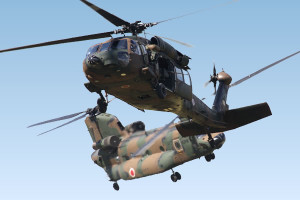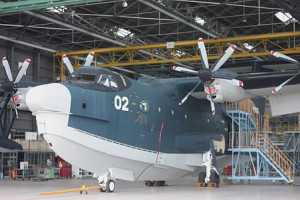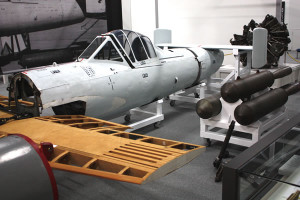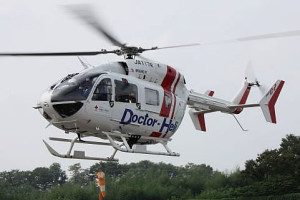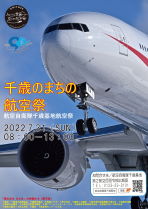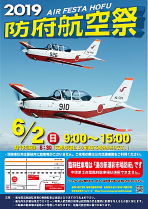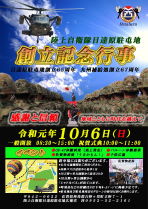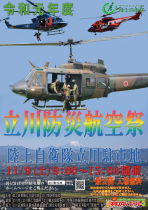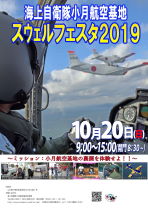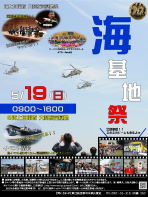JASDF Squadron Histories & Markings Part 2
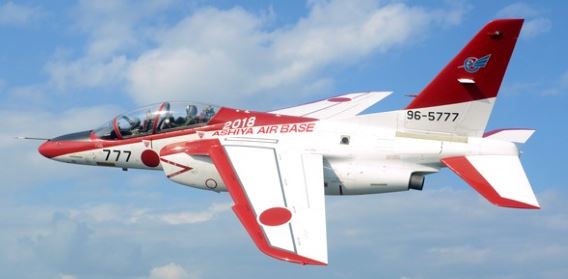 A Kawasaki T-4 from the 13th Flying Training Wing based at Ashiya AB, Fukuoka Prefecture, in
A Kawasaki T-4 from the 13th Flying Training Wing based at Ashiya AB, Fukuoka Prefecture, in
early 2018. Every year, the unit paints a special new year marking on one of its aircraft in time
for the base air show, which is usually held late in the year but was postponed to February 18.
(Photo source: JASDF Ashiya AB homepage)
(http://www.mod.go.jp/asdf/ashiya/)
Following the pattern of the other squadron history pages, the first listing of JASDF support and training units appears in numerical order. However, these also include an entry for each of the two training air wings, the three flying training wings (FTWs) and three tactical airlift groups (TAGs), which are themselves organizationally divided into squadrons.
| Unit No. | Notes |
| 1st Air Wing | Comprises 31st/32nd Training Sqn |
| 1st Flying Training School | 1955–1959 |
| 1st Tactical Airlift Group (TAG) | 401st/404th Sqn |
| 1st Technical School (TS) | |
| 2nd Flying Training School | 1955–1959 |
| 2nd TAG | 402nd Sqn |
| 3rd Flying Training School | 1957–1959 |
| 3rd TAG | 403rd Sqn/41st Sqn |
| 4th Air Wing | 11th Sqn/21st Fighter Training Sqn |
| 5th TS | |
| 11th Sqn | Blue Impulse aerobatic team |
| 11th Flying Training Wing (FTW) | |
| 12th FTW | |
| 13th FTW | |
| 14th FTW to 17th FTW | All four units disbanded 1963-64 |
| 21st Fighter Training Sqn | |
| 22nd Fighter Training Sqn | Disbanded 2001 |
| 23rd Fighter Training Sqn | |
| 31st Training Sqn | |
| 32nd Training Sqn | |
| 33rd/35th Sqns | Disbanded 1989/1991 |
| 41st Flight Training Sqn | |
| 401st Sqn and 402nd Airlift Sqn | |
| 403rd Tactical Airlift Sqn | |
| 404th Tactical Airlift Tanker Sqn | |
| 405th Air Refueling Sqn | Formed Dec. 15, 2020 |
| 601st Sqn to 603rd Sqn | |
| 701st Sqn | Special Airlift Group |
 A JASDF C-130H passes over a JGSDF soldier heading towards the Malemute drop zone during
A JASDF C-130H passes over a JGSDF soldier heading towards the Malemute drop zone during
the bilateral U.S.-Japan exercise Arctic Aurora held at Joint Base Elmendorf-Richardson, Alaska,
in June 2018. (U.S. Air Force/Justin Connaher)
Please note that those elements that are or were designated primarily by role are covered on the Squadron Histories Part 3 page, some parts of which are currently (January 2020) being compiled.
|
1st Air Wing |
Formed | As unnumbered Air Wing: Dec. 1, 1955 (Hamamatsu, F-86F) As training organization 1st Air Wing: Oct. 1, 1956 (Hamamatsu, F-86F) |
| Current Base | Hamamatsu (under Air Training Command, 31st/32nd Sqn, T-4) |
Having initially served as the unnumbered Air Wing, the re-designated 1st Air Wing assumed responsibility for conducting jet fighter pilot training courses in its own right. This long-established “mother” unit, which produced the fully-fledged homegrown pilots needed to man the squadrons in the formative years of the JASDF, has remained as an element within the Air Training Command setup headquartered at the Wing’s Hamamatsu base since the Command’s inception on March 16, 1989.
Details of its F-86F era can be found under the individual histories of the long-defunct squadrons most closely associated with the 1st Air Wing, namely the 1st, 2nd and 5th squadrons, on the page devoted to JASDF front-line squadron histories.
The 1st Air Wing also commanded a detachment that was formed with ex-5th Sqn F-86Fs at Matsushima on July 1, 1971. It was an aircraft from this unit that was tragically involved in a mid-air collision with an All Nippon Airways Boeing 727 over Iwate Prefecture, which at the time was the world’s worst airline accident, on the 30th of that same month. The detachment was disbanded on August 23, 1973.
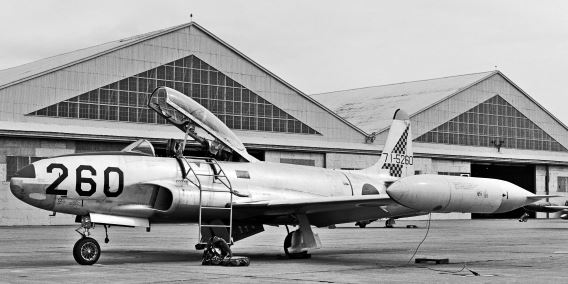 Primarily an F-86F unit, the 1st Air Wing’s short-lived Matsushima detachment also
Primarily an F-86F unit, the 1st Air Wing’s short-lived Matsushima detachment also
operated the T-33A. (Photo [Matsushima, Oct. 1972]: Akira Watanabe)
The history of the 11th Sqn (below) includes the background to the 1st Air Wing’s formation of an F-86F aerobatic team, the forerunner of today’s Blue Impulse. (During its T-2 era, the team came under the 4th Air Wing’s 21st Sqn.)
The 1st Air Wing’s T-33A era spanned the years when the 33rd and 35th squadrons (also listed below) were based at Hamamatsu, from the mid-60s to the early 90s, since which time two T-4 squadrons (the 31st and 32nd) have been in residence.
The 1st Air Wing passed the milestone of 200,000 accident-free flying hours on May 31, 2012.
1st Air Wing Markings
A black and yellow checkerboard design has been used throughout the 1st Air Wing’s existence. Usually seen in the form of a broad horizontal band on the tailfin in the F-86F era (see 1st Sqn entry on front-line unit histories page), there have been variations. For example, the F-86Fs and T-33As of the detachment based at Matsushima 1971–73 carried a solid ‘4’ marking, denoting the resident 4th Air Wing, that could be taken for a ‘1’ in the checkerboard pattern.
Both of the current constituent units retain the now slanted black and yellow checkerboard tail marking, but the 31st Sqn has blue and the 32nd red shadow edging beneath.
 (Photo [Ashiya, August 1975]: Takao Kadokami)
(Photo [Ashiya, August 1975]: Takao Kadokami)
|
1st Flying Training |
Formed | Nov. 1, 1955 (Hamamatsu, with Branch School at Hofu, T-34A) |
| Reorganized | As 11th Flying Training Wing (Ozuki) and 12th Flying Training Wing (Hofu), both flying T-34A, June 1, 1959 |
Previously the simply named Flying Training School that came into existence six days after the JASDF itself, on July 6, 1954, the 1st FTS moved to Ozuki on March 31, 1956, five months after its re-designation.
The 1st FTS and its branch school at Hofu went on to form the 11th and 12th FTWs, respectively.
|
1st Tactical |
Formed | Mar. 31, 1978 (Air Transport Wing, Komaki, C-1/YS-11) |
| Current Base | Komaki, under Air Support Command (401st Sqn, C-130H/KC-130H; 404th Sqn, KC-767) |
The 1st Tactical Airlift Group (TAG, sometimes referred to as a tactical airlift wing) formed at Komaki on March 31, 1978, the same day as its sister unit, the 2nd TAG, formed at Iruma. The Air Transport Wing, incorporating all three TAGs, and the Air Rescue Wing were combined to form the Air Support Command on March 16, 1989.
 A C-130H crew from the 401st Sqn, 1st TAG, practices landing on an unprepared strip.
A C-130H crew from the 401st Sqn, 1st TAG, practices landing on an unprepared strip.
(Photo: Japan Ministry of Defense/JASDF)
Aside from its primary tasks of airlifting personnel and equipment as well as in-flight refueling, the 1st TAG has been active in support of Japan’s international cooperation, including reconstruction assistance in Iraq as part of the nation’s contribution to peacekeeping operations (PKO).
1st TAG Tail Markings
Although aircraft from the sister 2nd TAG carry the TAG badge, those assigned to the 1st TAG carry the individual squadron (401st, 404th) markings, rather than its own badge, which primarily features a red shachihoko, a dolphinlike mythical creature (included below for reference).
 (Japan Ministry of Defense)
(Japan Ministry of Defense)
For special markings, a 1st TAG aircraft at the Komaki airshow in October 2008 (link) carried a badge on its forward fuselage to mark the 30th anniversary (link).
|
1st Technical School |
Formed |
As Maintenance School: Sept. 1, 1954 (Hamamatsu) As 1st TS: June 1, 1959 (Hamamatsu) |
| Current Base | Hamamatsu (Air Training Command, various aircraft types) |
The primary role of the 1st TS is to provide the full gamut of technical training on the maintenance of the aircraft in service with the JASDF and the weapons with which the combat aircraft types are armed.
All five JASDF technical schools were organized under the Technical Training Headquarters in 1962. The 1st TS has been under the then newly formed Air Training Command umbrella since March 16, 1989.
 Drawing a crowd on the Hamamatsu AB open day in November 2002 was this F-15J from the
Drawing a crowd on the Hamamatsu AB open day in November 2002 was this F-15J from the
based 1st Technical School. A clearer photo, taken three years later, can be viewed here (link).
 A Fuji T-7 when temporarily assigned to the 1st Technical School for instructional purposes.
A Fuji T-7 when temporarily assigned to the 1st Technical School for instructional purposes.
(Photo [Oct. 2010]: ‘Ken H’ via Wikimedia Commons)
 Counting its five years as the Maintenance School towards the total, the 1st TS held a
Counting its five years as the Maintenance School towards the total, the 1st TS held a
ceremony to mark its 70th anniversary on September 6, 2024. (Photo: JASDF/1st TS)
1st TS Tail Marking
 This F-86F was reportedly delivered to the JASDF’s 2nd Air Wing in October 1956 but after having
This F-86F was reportedly delivered to the JASDF’s 2nd Air Wing in October 1956 but after having
been involved in an accident on January 31, 1958, was withdrawn from use when with the 1st
Technical School in April 1958 and returned to the United States. The diamond-shaped tail
marking seen indistinctly in this photo was replaced simply by the kanji (教) for teaching
in a disc by early 1961; the kanji had possibly formed the central element of the
earlier design. (Photo: Tujimon via X @orapo960)
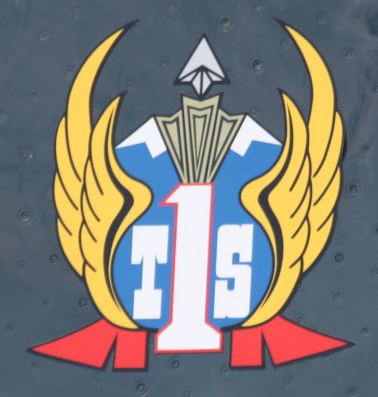
The main element of the unit’s current emblem (above, as carried on an F-2A in September 2014) is a winged ‘1TS’.
1st TECHNICAL SCHOOL SPECIAL MARKING
2004 JASDF 50th Anniversary T-1B 25-5854
 The 1st TS T-1B specially marked for the 50th anniversary of the JASDF at a wet
The 1st TS T-1B specially marked for the 50th anniversary of the JASDF at a wet
Hamamatsu in October 2004. The left side is shown to good effect here (link).
(Photo: Maryu via Wikimedia Commons)
Although the marking of the 5th TS (see later) was prominently displayed on the tail, the drop tanks bore the emblem of the 1st TS. A large blue ‘50’ and ‘1TS Anniversary’ were painted on the upper surfaces of the port and starboard wings, respectively. The concept was the wind and waves of the Enshu Sea, which lies off the west coast of Shizuoka Prefecture.
March 3, 2006 Final T-1B Flight (See 5th TS)
JASDF 70th Anniversary, 2024
 (Image: JASDF Hamamatsu AB via X @JASDF_Hamamatsu)
(Image: JASDF Hamamatsu AB via X @JASDF_Hamamatsu)
|
2nd Flying Training |
Formed | Nov. 1, 1955 (Matsushima, T-6) |
| Reorganized | As 13th Flying Training Wing, June 1, 1959 (Utsunomiya, T-6) |
Initially designated the Provisional Matsushima Detachment, what was to become the 2nd Flying Training School the following year commenced the first pilot cadet training course on U.S. Air Force T-6s on July 6, 1954, five days after the JASDF came into being.
A branch school of the 2nd FTS having been established at Yanome air base (today’s Sendai airport) on December 1, 1956, the parent unit relocated from Matsushima to Utsunomiya on August 1, 1957. For F-86F training purposes, the 2nd FTS Provisional Matsushima Training Unit was formed at Matsushima the same day. A year later, the unit at Yanome was simply re-designated as the First Branch School.
A short-lived Second Branch School of the 2nd FTS formed on the T-6 at Shizuhama on August 1, 1958.
The 2nd FTS ultimately became the 13th Flying Training Wing, on June 1, 1959.
2nd FTS Markings
Aircraft assigned to the First Branch School of the 2nd FTS sported a dark blue chevron on their tails, which was possibly the same marking carried by aircraft at the main school at Matsushima and later Utsunomiya. (For the markings of Second Branch School at Shizuhama, see 15th Flying Training Wing.)
|
2nd TAG |
Formed | Mar. 31, 1978 (Air Transport Wing, Kisarazu, C-1/YS-11) |
| Current Base | Iruma, under Air Support Command (402nd Sqn, C-1, U-4) |
The 2nd TAG was formed from the upper echelons of the 402nd Sqn at Iruma on the same day as the 1st TAG, on March 31, 1978, nearly 10 years to the day after its constituent unit’s June 1968 move from Kisarazu to Iruma. (For early formative history see Air Transport Wing, for other, later details, see 402nd Sqn.) The Air Transport Wing, incorporating all three TAGs, and the Air Rescue Wing were combined to form the Air Support Command on March 16, 1989.
 As reported on the Bulletin Board (Oct. 21, 2018), a 402nd Sqn C-1 was painted in a kabuki
As reported on the Bulletin Board (Oct. 21, 2018), a 402nd Sqn C-1 was painted in a kabuki
actor-themed colour scheme to mark the 2nd TAG’s 60th anniversary (counting from the
days of its Air Transport Group predecessor). (Photo: JASDF Iruma AB)
2nd TAG Tail Marking
 (Japan Ministry of Defense/JASDF)
(Japan Ministry of Defense/JASDF)
Unlike its two sister units, the 2nd TAG applies its own badge rather than individual squadron markings to its aircraft. In the shape of a shield, the badge depicts a gold-coloured eagle over a map of Japan with two red lightning bolts. Signifying the 2nd TAG’s regular flights bringing materiel and personnel to bases across Japan, the eagle carries five “loads” in its talons that are spread across the map.
 A low-viz version of the 2nd TAG’s tail marking was adopted for the unit’s second C-2.
A low-viz version of the 2nd TAG’s tail marking was adopted for the unit’s second C-2.
(Photo [July 2024]: HOPPY via X @s2f5g4)
 The markings carried on the left side of 402nd Sqn/2nd TAG C-1 48-1004 in late 1991. They
The markings carried on the left side of 402nd Sqn/2nd TAG C-1 48-1004 in late 1991. They
comprised the yellow, radio callsign-based COSMO FLIGHT logo, with each ‘O’ made into
a Saturn-like planet. The blue nose badge included a cartoon depiction of a shishi (lion,
but also the name given to the guardian dog on the left-side of Shinto shrines).
(Photo [Iruma, Nov. 1991]: Akio Misawa)
For more photos of and information on the special markings adopted over the years by the 2nd TAG, please see the August 2022 Bulletin Board entry, Kawasaki C-1 Retrospective/Sitrep.
|
3rd Flying Training |
Formed | Oct 1, 1957 (Tsuiki, T-33A) |
| Reorganized | As 16th FTW (Tsuiki, T-33A) and 17th FTW (Nyutabaru, T-33A), June 1, 1959 |
What had previously been the Provisional Ashiya Air Group (from August 1, 1954) and then the Provisional Tsuiki Air Group (from January 20, 1955) was given the more permanent title of 3rd Flying Training School (FTS) on October 1, 1957. A Branch School was formed at Nyutabaru on December 1 that year.
June 1, 1959, saw the main and branch schools of the 3rd FTS re-designated as the 16th and 17th FTW, respectively, though neither was destined to remain active for very long.
|
3rd TAG |
Formed | Mar. 31, 1978 (Air Transport Wing, Miho, YS-11) |
| Current Base | Miho (under Air Support Command, 41st Flying Training Sqn, T-400; 403rd Sqn, C-2) |
The 3rd TAG dates back to September 1959, when the United States returned Miho air base to JASDF control, which resulted in a provisional C-46 unit being formed and tasked with multi-engine training there on July 15, 1961.
When formed in 1978, the 3rd TAG was solely a YS-11 operator; its first C-1 did not arrive until March 3 the following year. A decade later, on March 16, 1989, the 3rd TAG was reorganized under the newly formed Air Support Command.
The 3rd TAG’s assumption of the responsibility for multi-engine training was heralded by the arrival of T-400s to form the Provisional 41st Flying Training Squadron on June 1, 1994; the unit was granted full squadron status exactly one year later.
In 2017, the 3rd TAG marked two milestones: the arrival of its first Kawasaki C-2 on March 28, and the passing into retirement of its last YS-11 on May 29.
 A C-2 from the 3rd TAG’s 403rd Tactical Airlift Sqn. Having been a composite squadron briefly
A C-2 from the 3rd TAG’s 403rd Tactical Airlift Sqn. Having been a composite squadron briefly
operating three different types of aircraft in March 2017, the 403rd has been a C-2 only
unit since early April 2018. (Photo: Japan Ministry of Defense/JASDF)
3rd TAG Tail Markings
Although aircraft from the sister 2nd TAG carry the TAG badge, those assigned to the 3rd TAG carry the individual squadron (41st, 403rd) markings rather than its own badge, which features a unicorn (included below for reference). In Greek mythology, unicorns were believed to have the power to ward off evil spirits and, fittingly for an airlift unit, said to be capable of covering long distances at night and devoting themselves to their tasks with wisdom. As will be noticed, the 3rd refers to itself as an air transport wing rather than as a tactical airlift group.
 (Japan Ministry of Defense/JASDF)
(Japan Ministry of Defense/JASDF)
 In view of the occasion, a surprisingly rare photo of the C-1 decorated as a thank-you
In view of the occasion, a surprisingly rare photo of the C-1 decorated as a thank-you
present for visitors to the Miho AB 40th anniversary event in 1998.
(Photo: JFS-81 (旧CORPLIFT/ASCOT05) via Twitter (@Jasdf_dock)
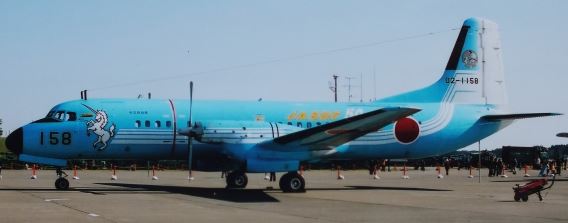 As part of the JASDF’s 50th anniversary celebrations, the 3rd TAG painted a YS-11 in a special
As part of the JASDF’s 50th anniversary celebrations, the 3rd TAG painted a YS-11 in a special
colour scheme that incorporated its own unicorn marking. According to the Miho base website,
the four white fuselage stripes that swept up to merge on the tail were a way to utilize the
whole aircraft. Seen as the wake of a ship, they symbolized the continuity of Miho-based
personnel over the years. (Photo [Nyutabaru, Dec. 2004]: Takao Kadokami)
In the run-up to Halloween in October 2018, the 3rd TAG/Miho base Twitter feed (link) included photos of the now withdrawn from use first production C-1 and a YS-11 parked on the south side of the base. The aircraft had been “tagged” with dayglo witch on a broomstick graffiti in a throwback to when that design used to be carried on the tails of Miho-based aircraft (see 403rd Tactical Airlift Sqn).
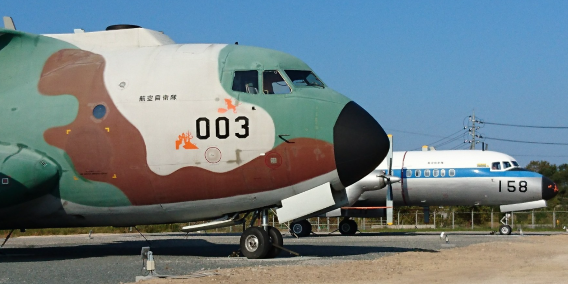 (Photo: JASDF Miho AB)
(Photo: JASDF Miho AB)
For more photos of and information on the special markings adopted over the years by the 3rd TAG, please see the August 2022 Bulletin Board entry, Kawasaki C-1 Retrospective/Sitrep.
|
4th Air Wing |
Formed | Feb. 16, 1958 (Matsushima, F-86F) |
| Current Base | Matsushima (under Air Training Command, 11th Sqn Blue Impulse, T-4; 21st Flying Training Sqn, F-2B and T-4) |
It was not until June 1, 1959, that an overall JASDF training organization, the Flying Training Command (Hikōkyōiku Shūdan), formally came into being. As mentioned above, an initially unnumbered (later 1st) Air Wing had been formed in December 1955 to fulfill this function alongside its front-line role.
As the service had by then formed four F-86F squadrons, the 4th Air Wing was formed in February 1958 as a fighter training umbrella organization, and the 5th Sqn relocated from under the 1st Air Wing’s command at Hamamatsu-North to Matsushima. This initial stint as a training provider was to be short-lived, however, as the 4th reverted to front-line status under the Central Air Defense Force on July 1, 1960.
That association was brought to an end on August 23, 1973, with the 4th’s return to the Flying Training Command fold and the change of assignment of the 7th Sqn to F-86F operational conversion unit and the formation of the 35th Sqn on T-33As that same day.
 A pair of 7th Sqn F-86Fs at Matsushima in July 1976. After a short initiation as a training unit with
A pair of 7th Sqn F-86Fs at Matsushima in July 1976. After a short initiation as a training unit with
the 5th Sqn from 1958 to 1960, the 4th Wing’s 7th Sqn reverted to the training role from 1973
until its disbandment in 1977. (Photo: Akira Watanabe)
Two T-2 squadrons, the 21st and the 22nd, formed in 1976 and 1978, respectively, bookending the 7th’s bowing out in 1977 and preceding the 35th’s move to Hamamatsu. The 4th initially became the parent unit for the Blue Impulse aerobatic team when this role was assumed by the 21st in 1982, a role that was continued by the then newly formed, T-4-equipped 11th Sqn in 1995.
 A six-aircraft formation of 4th Air Wing T-2s at Iruma in February 1981. (Photo: Akira Watanabe)
A six-aircraft formation of 4th Air Wing T-2s at Iruma in February 1981. (Photo: Akira Watanabe)
The T-4 having been selected as the Blue Impulse team’s next mount in June 1991, a unit to prepare for the type’s introduction and operations had been formed within the 21st Sqn as early as October 1992. The first Blue Impulse-standard T-4 was delivered to the 4th Air Wing on August 11, 1994, and displayed at the Matsushima air show 10 days later. On December 22, 1995, the 11th Sqn became the official unit designation of the Blue Impulse team with the disbandment of the Sengi Kenkyūhan (Combat Research Group) under the 21st Sqn.
 The main formation of the Blue Impulse aerobatic team during its performance at the U.S.-Japan
The main formation of the Blue Impulse aerobatic team during its performance at the U.S.-Japan
Friendship Day air show at Iwakuni in May 2017, the 41st event of its kind held since 1973.
(Photo: U.S. Marine Corps/Cpl. Aaron Henson)
The current F-2B era commenced with the arrival of the Provisional F-2 Squadron’s first aircraft on April 1, 2002, though it was to be March 10, 2004, when T-2 operations finally came to an end. The 21st Sqn was simultaneously disbanded on the T-2 and reformed on the basis of the Provisional F-2 Squadron on March 29, 2004.
 (Photo: Air Training Command/JASDF)
(Photo: Air Training Command/JASDF)
Still resident at Matsushima, the 4th Air Wing found itself very much in the front line on March 11, 2011, when the base’s apron and hangars were flooded by the tsunami triggered by the Great East Japan Earthquake. No less than 18 F-2Bs were damaged, five beyond economical repair.
Fortunately away from base that day, the Blue Impulse team returned to Matsushima in March 2013; the 21st Sqn did not join them from its temporary base at Misawa for another three years.
4th Air Wing Markings
See 5th and 7th squadrons (in Part 1), 11th Squadron, 21st/22nd Fighter Training Squadron (on this page)
|
5th TS |
Formed | Oct. 1, 1962 (T-33A) |
| Current Base | Komaki (Currently no assigned aircraft) |
What had formed at Matsushima on October 1, 1958, as the Kansei Kyōikudan (literally Control Training Group) moved to Komaki on May 12, 1959, and was renamed the 5th Technical School on October 1, 1962.
Previously lacking any of its own aircraft, the unit flew T-33As in support of its air traffic control training role for the next 20 years, trading in its T-33As for T-1Bs on October 1, 1982. The 5th TS was placed under the control of the newly formed Air Training Command in March 1989.
 (Hyakuri, October 2000)
(Hyakuri, October 2000)
The part of the air traffic controller training course that had involved the use of real aircraft having been dropped in December 2005, the final flight of the unit’s four T-1Bs, the last in JASDF service, took place on March 3, 2006.
 The scene at the 5th TS following the final flight of its T-1Bs on March 6, 2006. Officially
The scene at the 5th TS following the final flight of its T-1Bs on March 6, 2006. Officially
withdrawn from operational service on May 11 that year, the pictured aircraft was
placed on display at Miho AB, where it has remained to this day.
(Photo: JASDF Komaki AB via Twitter @komaki_airbase)
5th TS Tail Markings
 (Photo [Komaki, Aug. 1980]: Akira Watanabe)
(Photo [Komaki, Aug. 1980]: Akira Watanabe)
The marking used for the T-33As (above) operated by the unit from 1978 until 1982 had a downward-pointing red chevron, to represent the Roman numeral `V` for 5th TS, on a broad horizontal dark black-green band.
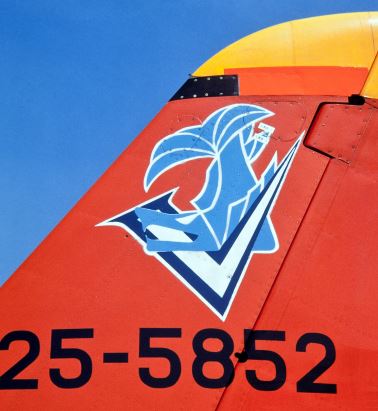 (Photo: [Komaki, Sept. 1986], Akira Watanabe)
(Photo: [Komaki, Sept. 1986], Akira Watanabe)
From 1982, the T-1 tail marking (above) again featured the Roman numeral `V` and a different, blue version of the shachihoko, the dolphinlike mythical creature that at that time appeared in red on the tails of 401st Sqn C-130Hs (and, in the 1960s, 3rd Air Wing F-86Ds) also based at Komaki.
5th TECHNICAL SCHOOL SPECIAL MARKINGS
November 1991 Hyakuri Air Show T-1B 25-5858 (link)
This aircraft had 祝百里基地航空祭 (Celebrating the Hyakuri AB Air Show) in white along its fuselage. 初鷹 (Young Hawk, the nickname given to the T-1) appeared in black forward of the ‘last three’ serial number on the nose, next to which were black and white T-1 silhouettes cut out from adhesive paper. (Also present that day, ’851 just had a black silhouette.)
1992 Komaki Air Show T-1B 25-5858
For this event otherwise standard T-1Bs, including ’858, wore individual Roman numerals (in this case ‘I’) painted on their rudders to indicate their display formation positions.
November 1992 Hamamatsu Air Show T-1B 25-5858
The same, now otherwise standard aircraft again had a black T-1B silhouette and 初鷹 on the nose. Comic eyes and a smile were added to the dayglo nose band.
November 1993 5th TS 30th Anniversary T-1B 35-5865
Displayed at that year’s Komatsu air show, this aircraft had ‘1963 – 1993’ above ‘30th ANNIVERSARY’ on its nose.
November 1995 Komaki Air Show T-1Bs 25-5852, 25-5863 plus three other aircraft
The five aircraft that performed a demonstration flight carried the unit badge on their ferry tanks. Each bore two white kanji written vertically on their rudders, the top kanji describing the second, that of the unit marking, the mythical creature shachihoko. Thus ’852 (激鯱) and ’863 (強鯱) were fierce and strong, respectively. Other aircraft carried 闘鯱 (fighting), 列鯱 (obscurely meaning ‘many, in a line’), and 猛鯱 (ferocious shachihoko).
1997 5th TS 35th Anniversary T-1Bs 25-5851, 25-5854, 35-5869
At least three aircraft had ‘35TH ANNIVERSARY’ in the shape of a T-1 silhouette with a blue outlined ‘V’ added to their noses. The penultimate T-1B built, ’869 also had 歓迎 (kangei, meaning ‘welcome’), above and ようこそ (‘good to see you’) as well as 小牧基地 (Komaki Air Base) beneath the silhouette on the day of that years’ Komaki air show.
July 2001 5th TS First T-1 Retirement T-1B 35-5864
The 5th TS received many former 13th FTW T-1Bs and retired the first when the highest number were on strength. To mark the event, ’864’s tail was painted dark blue and both sides adorned with eight white stars, each representing one of its then operational T-1Bs, and 初鷹魂 (hatsutakadamashii, Spirit of the Young Hawk) in yellow. The kanji 続 (zoku, continuing) and 完 (kan, completion) were painted in red on, respectively, the right and left sides of the rudder. A bouquet of flowers was also added to the left side of the nose as an expression of gratitude.
October 2002 5th TS 40th Anniversary T-1B 35-5867
 (Photo [Komaki, Oct. 2002]: Hiroyuki Yamauchi)
(Photo [Komaki, Oct. 2002]: Hiroyuki Yamauchi)
This scheme involved changing the colour of the fuselage stripe and tail from standard red to blue. The words ‘SINCE 1962 5 TS & T-1B 40TH ANNIVERSARY’ were added to the tail; here the colour of the shachihoko unit marking was changed from blue to gold, and the kanji 初鷹 (Young Hawk) again added vertically in red on the rudder. The ferry tanks were painted red, and ‘40th Anniversary’ added in white cursive script to the outside of the left tank.
2004 JASDF 50th Anniversary 25-5855
 (Photo [Nyutabaru, Dec. 2004]: Takao Kadokami)
(Photo [Nyutabaru, Dec. 2004]: Takao Kadokami)
Seemingly influenced by the colour scheme previously worn by Blue Impulse F-86Fs and drawing on the scheme adopted for the 40th anniversary, the fuselage stripe and tail were painted light blue, and the rudder featured a blue and white serrated pattern. ‘JASDF 50TH ANNIVERSARY’ was added in white and yellow on the tail. The red ferry tanks again had the kanji 初鷹 (Young Hawk) and T-1B in ornate script, all in white.
Below the canopy was the name of the maintenance crew chief, to the left of the 50th anniversary logo were the names of the colour scheme designers and paint crew members, and added beneath was the official JASDF anniversary slogan 美しき大空と共に (‘For the Blue Sky’). Note that the previously plain red nosewheel door had had the Japanese 祝松島基地航空祭 (‘Celebrating the Matsushima Air Base Air Show’) specially added for the occasion.
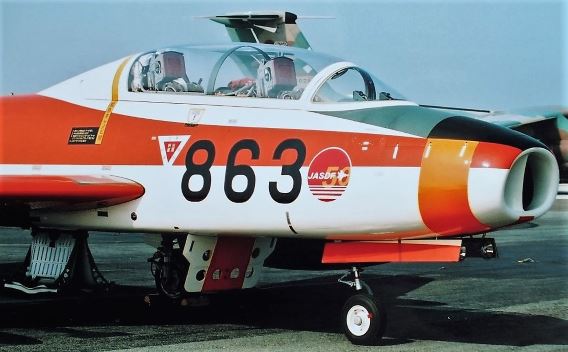 Other aircraft just wore the 50th anniversary emblem. (Photo [Ashiya, Oct. 2004]: Takao Kadokami)
Other aircraft just wore the 50th anniversary emblem. (Photo [Ashiya, Oct. 2004]: Takao Kadokami)
March 3, 2006 Final T-1B Flight, Komaki AB T-1Bs 35-5853/860/863/866
A ceremony (link) and a final four-aircraft formation flypast marked the T-1’s retirement. Of the four, only ’866 landed back at Komaki; the other three flew to the 1st TS at Hamamatsu.
The only eye-catching colour scheme was that of ’863, which sported a blue tail bearing an ornate ‘T-1’, the words ‘Final Eternity’ and the 1st TS unit marking in anticipation of its final destination. As you would expect, 初鷹was on both sides of the fuselage, this time in large white kanji, and ‘T-1 Final 1958-2006’ was in white on the outside of both dark blue ferry tanks. All the written elements of the design were reversed on the right side.
The other three were is standard colour schemes with added messages. For example, ’853 had さようなら小牧基地 (Sayonara, Komaki Air Base) in black on the sides of its fuselage, and ’860 had 初鷹魂 (hatsutakadamashii, Spirit of the Young Hawk, as seen on ’864 in July 2001) on its rear fuselage.
|
|
Formed |
As Provisional 11th Sqn: Oct. 1, 1994 |
| Current Base | Matsushima (4th Air Wing, Blue Impulse display team, T-4) | |
| See three-part Blue Impulse chronology, parts 1 and 3 of which follow this entry. | ||
The unit today designated the 11th Sqn has its origins in the F-86F era. As early as October 19, 1958, a trio of 1st Air Wing aircraft appeared as an unofficial team for an event to mark the opening of what was then known as Hamamatsu-North airbase. A four-aircraft formation performed over an SDF exhibition organized in the city of Inuyama, Aichi Prefecture, on March 15, 1959. That team was disbanded in April 1959, after just two more (a total of four) appearances.
In late 1959, however, the arrival of the U.S. Air Force Thunderbirds—then wowing the crowds by flying the F-100C Super Sabre—on the Japan leg of a four-country Asian tour was highly influential in generating interest in the JASDF having its own permanent display team for PR purposes.
The direct forerunners of today’s Blue Impulse aerobatic team, five F-86Fs were established under the front-line 2nd Sqn at Hamamatsu as the Kūchūkidō Kenkyūhan (Air Manoeuvering Research Group) from April 12, 1960.
Following the front-line 2nd Sqn’s disbandment on November 20, 1965, the sub-unit was renamed the Sengi Kenkyūhan (Combat Research Group) and was returned to the 1st Sqn/Air Wing fold, only to come under the T-33A-equipped 35th Sqn when disbandment caught up with the 1st Sqn following the cessation of F-86F training. The Blue Impulse team retained the Combat Research Group name during its T-2 era (see 21st Sqn).
The Blue Impulse aerobatic team has been officially flying the T-4 as the 11th Sqn since 1996, as shown in the chronology below.
Blue Impulse Chronology (Part 1/3)
| F-86F Era (1960–1981) | |
| Mar. 4, 1960 | Performance at Hamamatsu-North (now Hamamatsu) open day counts as first official aerobatic display |
| Apr. 16, 1960 | (Officially Aug. 1, 1960) Kūchūkidō Kenkyūhan (Air Manoeuvering Research Group) formed with five F-86Fs under command of front-line 2nd Sqn, 1st Air Wing, at Hamamatsu-North |
| May 21, 1960 | Fifth display, first with smoke, at U.S. Air Force Johnson AB (now JASDF Iruma) |
| Aug. 1, 1960 | Renamed Tokubetsu Hikō Kenkyūhan (Special Flight Research Group) |
| Sept. 1960 | Name Tenryu (Flying Dragons) adopted, Tenryu being name of river close to Hamamatsu AB |
| Early 1961 | Name changed to Blue Impulse |
| July 1961 | Special Flight Research Group/Blue Impulse transferred to 2nd Sqn |
| July 21, 1961 | Team suffers first fatality when Maj. Matsuo Kato’s aircraft crashes into sea off Cape Irago, Aichi Prefecture |
| Oct. 22, 1961 | 24th display, first use of coloured smoke and of specially painted aircraft at event marking third anniversary of Hamamatsu-North AB |
| Oct. 5, 1963 | Team makes debut in new (second) colour scheme at Miho AB event (62nd display) |
| Oct. 3, 1964 | Five team pilots practice blowing Olympic smoke rings in sky over Tokyo Olympics stadium (actual performance conducted during opening ceremony on Oct. 10, followed by another on Oct. 23, 82nd–84th displays) |
| July 25, 1965 | 100th display, Matsushima AB air show |
| Nov. 20, 1965 | Transferred from 2nd back to 1st Sqn of 1st Air Wing, Special Flight Research Group changes name to Sengi Kenkyūhan (Combat Research Group) on same day |
| Nov. 24, 1965 | Flt. Lt. Tadayoshi Jōmaru, who was reserve pilot for the Tokyo Olympics display, killed during training when aircraft stalls and crashes into forest at end of Matsushima’s runway |
| Sept. 7, 1969 | 200th display, at Sapporo-Okadama air show |
| Mar. 14, 1970 | Six aircraft draw EXPO70 in sky over Osaka world exposition site |
| Mar. 13, 1974 | 300th display, Hamamatsu-North AB air show |
| Sept. 26, 1976 | First six-aircraft (four-aircraft formation/dual solo) display at show marking 1st Air Wing’s 20th anniversary |
| Mar. 31, 1979 | 1st Sqn disbands due to cessation of pilot training on F-86F; Combat Research Group transfers to 35th Sqn with effect from following day |
| Apr. 23, 1980 | 500th display at SDF event held at Hamamatsu-North |
| Feb. 8, 1981 | Ceremony held after performing 545th and final official show on F-86F at Iruma (six T-2s also perform aerobatic display) |
| Mar. 3, 1981 | Final aerobatic training on F-86F conducted |
| Mar. 31, 1981 | Combat Research Group (F-86F Blue Impulse) disbands |
| See 21st Sqn for Part 2/3 continuation, T-2 era (1981–1995); Part 3/3 T-4 era (1995–) follows below |
|
 A five-aircraft Blue Impulse F-86F formation overflies Bentenjima, an island at the mouth of
A five-aircraft Blue Impulse F-86F formation overflies Bentenjima, an island at the mouth of
Lake Hamana, close to Hamamatsu air base in Shizuoka Prefecture, circa 1979.
(Photo: via JASDF Naha AB)
Scenes from the team’s 534th display, at Shizuhama AB on November 16, 1980, can be found from the 3:09 mark on 8mm footage uploaded to YouTube (link).
Blue Impulse Chronology (Part 3/3)
| T-4 Era (1995–) | |
| July 30, 1995 | Matsushima air show. First of two events—other a training display at Hyakuri on Nov. 12, 1995—at which Provisional 11th Sqn T-4s appear with T-2 Blue Impulse team |
| Dec. 2, 1995 | 11th Sqn forms on same day as T-2 Combat Research Group (Blue Impulse) disbands |
| Apr. 5, 1996 | First official T-4 display held at National Defense Academy (Yokosuka, Kanagawa Prefecture) cadet entrance ceremony |
| Apr. 7, 1996 | First public display, Cherry Blossom Festival, Kumagaya AB, Saitama Prefecture |
| Apr. 1997 | Team travels to give its thus far only overseas displays (Apr. 25–26) at air show marking 50th anniversary of U.S. Air Force, Nellis AB, Nevada. |
| Feb. 7, 1998 | Perform at opening ceremony of Nagano Winter Olympics |
| July 4, 2000 | On ninth anniversary of fatal T-2 accident, team suffers loss of three pilots* following a collision between aircraft ‘5’ and ‘6’ over the sea off Matsushima |
| Aug. 26, 2001 | First public appearance in nearly 15 months made at home base Matsushima air show |
| Apr. 5, 2002 | 100th T-4 display, National Defense Academy cadet entrance ceremony |
| June 4, 2002 | Team flypast prior to opening Japanese match of 2002 FIFA World Cup Korea-Japan |
| May 27, 2007 | 200th T-4 display, Miho AB air show |
| Jan. 23, 2011 | Cumulative total of displays reaches 1,000, Naha AB show |
| Mar. 11, 2011 | Team fortunately away at Ashiya AB when Matsushima put out of action by tsunami that followed Great East Japan Earthquake |
| May 23, 2011 | Training from Ashiya commences |
| Nov. 3, 2012 | 300th T-4 display, Iruma AB air show |
| Mar. 30, 2013 | Team’s homecoming to Matsushima |
| May 31, 2014 | Performs 50th anniversary flypast over former Tokyo Olympics stadium, final event before its demolition |
* Maj. Mikio Abe, Maj. Miki Ichishima and Capt. Tomohiro Umekawa
Blue Impulse F-86F and 11th Sqn T-4 Markings
(F-86F)
For their early performances in 1960, the aerobatic team used standard, natural-metal F-86Fs from the 1st Air Wing, with the black and yellow checkerboard on the tail.
(Blue Impulse F-86F, 1961 to August 1963)
In 1961, all five aircraft had special paint details added to their natural metal finish, following a request for suggestions from within the 1st Air Wing. The first was that applied to the team leader’s mount, comprising gold and pale blue areas on the wings and tail as well as fuselage bands in those same colours; the bands were known within the unit as tasuki, the word for the sashes used to hold up folded shirtsleeves. Pink and gold bands around the nose extended partway along the underside of the aircraft, and the name ‘Blue Impulse’ appeared in cursive script on the outside of the gold-painted drop tanks. For the rest of the team’s aircraft, the gold areas were replaced by a darker blue; all the team’s aircraft retained the 1st Air Wing’s horizontal checkerboard tail stripe.
The aircraft first began to be seen sporting this early colour scheme in October 1961, debuting at Hamamatsu on the 21st of that month.
(Blue Impulse F-86F, from November 1963 to March 1981)
The colour scheme that was to see the team through to the end of the F-86F era was one of five suggestions from the designers at the Toho film company, with which the team had worked for the drama Kyō mo Ware Ōzora ni Ari (in the absence of an official English title, Up in the Skies Today) that was released in February 1964. Thus, by the time of their major engagement at the Tokyo Olympics, the team’s F-86Fs were in their well-known blue and white scheme, with orange areas on their undersides as well as orange “autographed” drop tanks.
(Blue Impulse T-4)
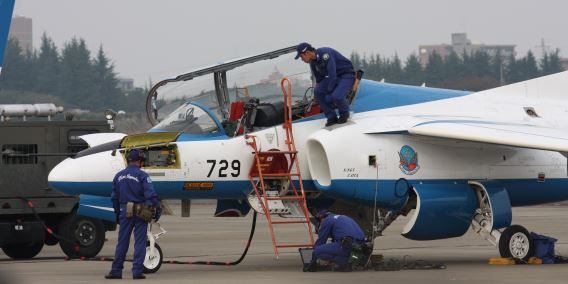 (Iruma, November 3, 2013)
(Iruma, November 3, 2013)
 (Japan Ministry of Defense/JASDF)
(Japan Ministry of Defense/JASDF)
Besides their distinctive blue and white colour schemes—a throwback to the F-86F era—and individual aircraft tail numbers, Blue Impulse aircraft carry the squadron badge (above), depicting the team flying over the globe above winged flaming arrows, on their engine intakes.
|
11th Flying Training Wing |
Formed |
As unnumbered Flying Training School: July 6, 1954 (Hamamatsu, T-34A) As 11th FTW: June 1, 1959 (Flying Training Command, Ozuki, T-34A) |
| Current Base | Shizuhama (under Air Training Command, 1st/2nd Sqn, T-7) |
Although the 11th FTW can trace its origins back to 1954, it was only formed as such in 1959 and has been at Shizuhama since 1964.
More specifically, the unit moved from Hamamatsu to Ozuki on March 31, 1956, soon after having formed as the 1st Flying Training School. Having been re-designated as the 11th Flying Training Wing on June 1, 1959, the move to Shizuhama was made on May 30, 1964.
The unit lost two pilots during its time at Ozuki when, on February 26, 1962, their aircraft struck power lines and crashed into the sea off the town of Hohoku (now part of the city of Shimonoseki), Yamaguchi Prefecture.
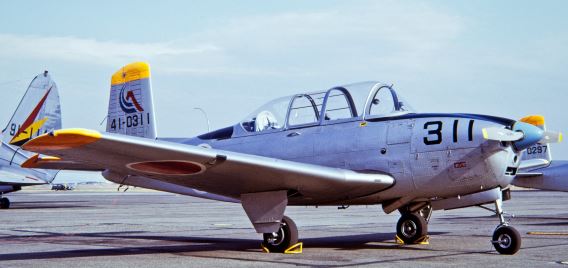 (Above and below) Two photos of 11th FTW T-34As taken four years apart at the Iruma air show.
(Above and below) Two photos of 11th FTW T-34As taken four years apart at the Iruma air show.
Dating from December 1972, that above shows the early, dowdy appearance, but by 1976 the
aircraft were were sporting a high-visibility colour scheme; ‘416 is
today part of the Chitose AB collection.
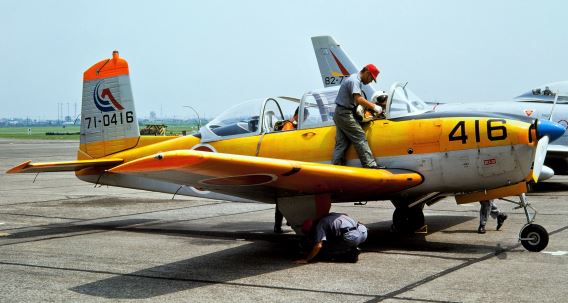 (Photos: Akira Watanabe)
(Photos: Akira Watanabe)
Having received its first Fuji T-3 in September 1978, the T-34A was progressively phased out until the 11th became solely a T-3 unit a year later, in September 1979. According to the information carried on the 11th FTW T-3 specially marked to celebrate the 50th anniversary of the JASDF in 2004 (see Special Markings section below), the unit trained 1,002 pilots on the T-34 from 1964 and 1,082 pilots on the T-3 from 1979.
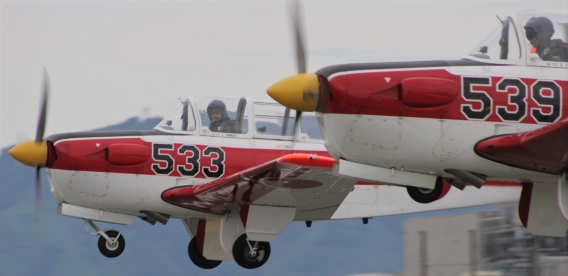 (Photo [2006]: Bombe via Twitter @bombe3939)
(Photo [2006]: Bombe via Twitter @bombe3939)
The T-7 era was ushered in on April 7, 2005, when the first example arrived, but it was to be February 22, 2007, before the last 11th FTW T-3 flight took place.
11th FTW Markings
 Silver save for dayglo orange tips to its wings and tailfin, an 11th Flying Training Wing T-34A
Silver save for dayglo orange tips to its wings and tailfin, an 11th Flying Training Wing T-34A
basks in the sun at Iruma in November 1969. From 1965 to 1971, the 11th FTW used a slightly
modified form of the tail marking of the former 2nd Flying Training School, a blue stylized
lightning flash-like‘S’ for Shizuhama superimposed offset on two horizontal red stripes.
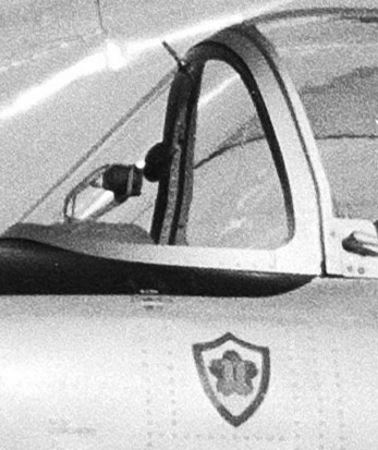 A small shield-shaped badge, possibly a cherry blossom incorporating the
A small shield-shaped badge, possibly a cherry blossom incorporating the
number ‘11’, was carried beneath the cockpit. (Photos: Akira Watanabe)
A red outline of Mt Fuji, located to the north of its base, forms part of the current unit marking (below), which was adopted way back in 1971. Also included is a representation of a local river, the Ōigawa, in blue.
 (T-3, Hyakuri, Oct. 2000)
(T-3, Hyakuri, Oct. 2000)
In the T-3 era, the colour of the propeller spinner helped the two seibibuntai (maintenance teams) to tell their aircraft apart; red and yellow spinners differentiated the aircraft assigned to the 1st and 2nd teams, respectively. This system was continued for a time with the T-7, when three short red stripes at the top of the tailfin denoted those aircraft looked after by the 1st Maintenance Team and the blue stripes those by the 2nd. The 11th has since adopted a line maintenance system and thus the markings, although still carried, are no longer of any significance.
In May 2018, the Shizuhama base 60th anniversary badge was being carried on the nose of some aircraft (link).
11th FLYING TRAINING WING SPECIAL MARKINGS
An idea that seems to have taken off in the mid-1990s, likely triggered by the JASDF’s 40th anniversary in 1994, it has become something of a tradition for the 11th FTW to decorate at least one of its aircraft every year to mark a commemorative event or just for publicity purposes at the Shizuhama air show. Here J-HangarSpace includes some photo links to provide examples of some of the weird and wonderful artwork and markings used over the years.
T-3 Special Markings
September 1984 Grey/green camouflage 11-5545 (link)
At a time when other training aircraft were being given experimental camouflage schemes, an 11th FTW T-3 appeared in a blue and grey camouflage at the SDF review. The upper surfaces were green, medium green and grey, the undersides white.
1994 JASDF 40th anniversary 91-5511
For such a high profile event, an example of each aircraft in service was selected for a special colour scheme. In the case of the T-3, it fell to the 11th FTW to come up with the anniversary design (link). A large badge (link) added to the fuselage beneath the cockpit comprised a formation of three birds, each wearing a helmet and visor, against a Mt. Fuji backdrop. Not for nothing was an aircraft incorporating the number ‘11’ in its serial number chosen, the same aircraft that has served as Shizuhama gate guard since March 2004.
June 2001 (1) 91-5519
Devoid of its fuselage national markings and serial numbers, this strange design (link) tempted fate by featuring orange and red flames around the engine and along the forward fuselage as well as licking around the lower fuselage and the leading edge of the vertical tail. The base name Shizuhama on the left side of the fuselage appeared in reverse lettering on the right side (link). Although the fuselage was otherwise all white, a Japanese slogan—possibly 静浜基地航空祭 (Shizuhama Air Base Air Show)—seems to have been painted on the undersides; the wings were wisely left untouched.
June 2001 (2) 01-5529
 (Photo: ちゃちゃ丸 via Twitter @yasuhiro1964021)
(Photo: ちゃちゃ丸 via Twitter @yasuhiro1964021)
Seen in the background of the first of the previous aircraft’s photo links, this aircraft also lacked its serial numbers. The yellow-striped design on the right side (link) was based on the 11th FTW, 2nd Sqn’s radio call-sign Fuyo (literally lotus but also an alternative name for Mt Fuji), which appeared in kanji as 芙 and 蓉 on either side of the fuselage hinomaru and as ‘FuYo’ in blue on the nose. The completely different design on the port side (link) consisted of yellow cartoon birds, a green banner proclaiming SHIZUHAMA AIR FESTIVAL in white, and on the tail a green Mt Fuji with a yellow summit and three blue ocean waves. Rather than painted on, this design was made using stickers cut out from adhesive tape.
May 2002 (1) FIFA World Cup Korea-Japan 01-5531 (link)
The theme here was the 2002 FIFA World Cup, which Japan was then about to co-host with South Korea. Again it was just the fuselage that received some treatment that involved removing the serial numbers. On this occasion a simple blue colour scheme mimicked a Japanese national Samurai Blue team shirt, with a broad red and white stripe forming a horizontal ‘V-neck’ and running along the fuselage and a red-edged white area at the top of the tailfin; again for that football shirt look, ‘11’ was painted on the tail in yellow. Added to the fuselage under the cockpit in yellow on the left side was the word ‘Japan’, which was reversed on the right side. Appearing above the white stripe on the rear fuselage was the Japanese expression がんばれ日本 (gambare Nippon), here meaning ‘go for it Japan’.
May 2002 (2) (Serial number unknown, link)
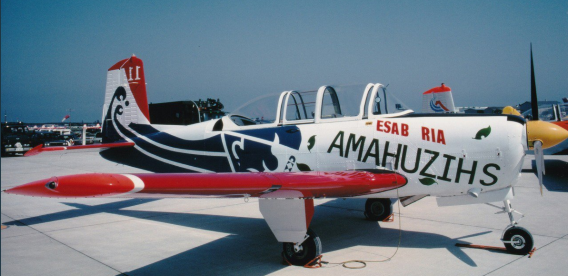 (Photo: Banchoh via Twitter @BANF30)
(Photo: Banchoh via Twitter @BANF30)
On static display alongside the World Cup colour scheme was another aircraft, sporting a blue and white wave design—which at least in part paid homage to the famous woodblock print of Mt. Fuji by the 19th century artist, Hokusai—and some fluttering green leaves. Although other 11th FTW designs had tended to feature mirror-image wording on one side of the aircraft, the lettering in red bizarrely appeared as ESA B RIA and AMAHUZIHS on the right side; even the digits in the ‘11’ on the tailfin were reversed.
May 2003 Centenary of Wright Brothers 01-5523
Both sides of this elaborately decorated aircraft featured two images of the Wright Flyer. The main wording on the Japanese-language port side (link) read 飛行機誕生 (hikōki tanjō, the birth of the aircraft) and 100周年 1903 年 (hyaku shūnen, centenary 1903); only partly visible in the link, 来年は空自50周年 (‘Next year JASDF 50th anniversary’) was added to the rear fuselage. The multicoloured tail incorporated 静浜基地 (Shizuhama Air Base) and 航空祭 (air show), above which was the aircraft’s redesigned serial number. Emblazoned along the English-language right side of the fuselage (link) was “FIRST SUSTAINED POWERD [sic] FLIGHT BY MAN”.
 As a reminder of what the T-3 normally looked like, this standard 11th FTW aircraft was present at
As a reminder of what the T-3 normally looked like, this standard 11th FTW aircraft was present at
Hyakuri in July 1985. (Photo: Takao Kadokami)
2004 JASDF 50th Anniversary (1) 91-5512
 (Photo: Banchoh via Twitter @BANF30)
(Photo: Banchoh via Twitter @BANF30)
In this case (here seen at Iruma, link), the words JASDF 50TH ANNIVERSARY ran along the anti-dazzle panel and the special JASDF half-century badge was added beneath the cockpit. The fuselage sides were used to chart the history and markings of the 11th FTW and its preceding 15th FTW, using the Japanese year-naming system. The rear fuselage had aircraft silhouettes that gave the periods and numbers of pilots trained, and the tail bore the official JASDF anniversary slogan 美しき大空と共に (‘For the Blue Sky’ [literally ‘together with the beautiful sky’]).
2004 JASDF 50th Anniversary (2) 91-5518
 (Photo: Banchoh via Twitter @BANF30)
(Photo: Banchoh via Twitter @BANF30)
The second, less elaborate scheme (link) involved giving a T-3 the yellow tail and marking from the 15th FTW T-6 era along with a smaller 50th anniversary fuselage badge.
2004 JASDF 50th Anniversary (3) 91-5513
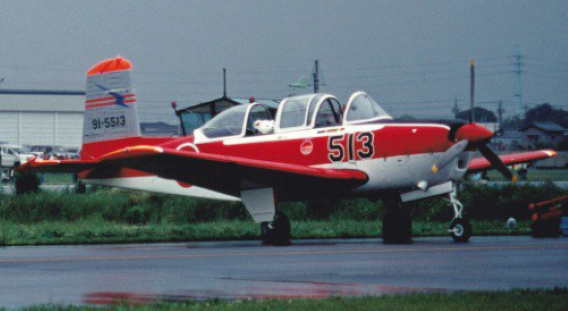 (Photo: Banchoh via Twitter @BANF30)
(Photo: Banchoh via Twitter @BANF30)
Likewise, for the third 50th anniversary scheme an aircraft had its tail repainted with the initial marking (link) first carried on the 11th’s T-34As. The other side of the aircraft looked like this (link).
2005 (1) 50th Anniversary revisited 91-5512 (link)
In 2005, the 11th took the opportunity to once again air the aircraft that had been specially marked with the main 50th anniversary design the year before. The 50th anniversary fuselage badge gave way to what looked like a flame-encircled ‘51’, and the tail slogan was changed to 空への第一歩 (‘First step to the skies’, link).
2005 (2) 01-5528
This aircraft featured enlarged tail markings, the blue stripes of which continued forward along the fuselage and ended with silhouettes of a UH-60J and an F-15J (left side, link) and an F-2 and Boeing 747 (right side, link), the culmination of the training streams along which pilots proceed from Shizuhama. The same slogan that appeared on the tail of ’512 was carried low on the fuselage, just aft of the wing.
2006 World War II camouflage 11-5541 (link)
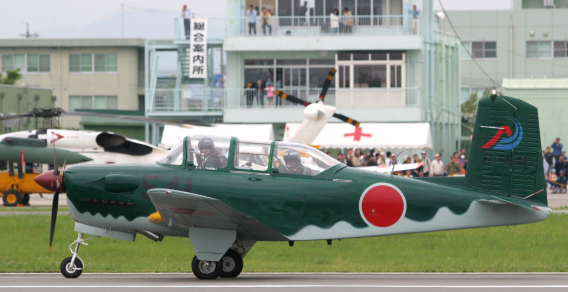 Photo: Bombe via Twitter @bombe3939)
Photo: Bombe via Twitter @bombe3939)
The green camouflage colour scheme chosen that year was meant to be a throwback to the final year of World War II, when Imperial Japanese Naval Air Force Suisei (Judy) bombers were operated from what was then Fujieda air base. To add to the illusion, engine exhausts were painted on the side of the engine (link).
T-7 Special Markings
May 2007 66-5937
 (Photos above and below: Bombe via Twitter @bombe3939)
(Photos above and below: Bombe via Twitter @bombe3939)

The fuselage colour scheme on both sides was modified to apparently give the effect of the red stripe paint peeling off, revealing its white reverse (link). Low on the fuselage on either side of the hinomaru in black was written 静浜基地 (Shizuhama Air Base) and 航空祭 (Air Show). 2007 AIR FESTA appeared on the nose on the left side only.
May 2008 Shizuhama AB 50th Anniversary 56-5929
 (Photo [May 2008] via Wikimedia Commons)
(Photo [May 2008] via Wikimedia Commons)
The main differences were the changes made to the tail marking, seen to better effect in a photo taken at Kisarazu the following October (link). Mt. Fuji appeared as a grey outline and the now three-coloured “river” was made to form a stylized ‘50’, these stripes being repeated on the rear fuselage. The words 50TH ANNIVERSARY were added beneath the anti-dazzle panel on both sides.
 (Photo: REMCAT@(CV:SNECMA M88) via Twitter @REMCAT18)
(Photo: REMCAT@(CV:SNECMA M88) via Twitter @REMCAT18)
May 2009 56-5932
For this year’s design, the fuselage sported a variation on the red and white pattern, an eagle appeared on either side ahead of the serial ‘last three’, and an arrowhead (with some small titling, including JASDF 11TH FLIGHT [not FLYING] TRAINING WING) was positioned forward of the tailplane. The design team reverted to reversing the main titling on the right side of the fuselage (link).
May 2018 Shizuhama AB 60th Anniversary 86-5949 (link) (link)
In a departure from the norm after a nine-year hiatus, the aircraft chosen to commemorate such a major milestone appeared in the standard colour scheme. A long Japanese slogan was written beneath the cockpit, thanking the local community for its support over those 60 years and pointing out that the event also coincided with the 10th anniversary of the merger of Ōigawa, where Shizuhama is located, into the city of Yaizu. The text was flanked by what appeared to be a yellowfin tuna and the cartoon-figure pilot Yai-chan seemingly riding a fish like a skateboard (link) (link). A 60th anniversary sticker (seen at the end of this report) was carried on either side of the aircraft’s nose.
 The “sora-age”-promoting Yai-chan, the Shizuhama AB mascot designed
The “sora-age”-promoting Yai-chan, the Shizuhama AB mascot designed
in collaboration with Yaizu City. (From Shizuhama AB website)
The story behind the mascot is connected to the base’s desire to show gratitude to the local community for 60 years of support.
The JASDF had been promoting nutrition education since 2015, establishing ASDF Nutrition Education Day to raise awareness and stimulate interest in food among its personnel, prevent lifestyle-related diseases, and encourage a healthier diet.
Fried chicken (kara-age) was chosen as a standard dish for the JASDF because it is available at bases across the country, made from relatively inexpensive ingredients, can be cooked in large quantities, and suits the tastes of its personnel. The name was changed from kara-age to sora-age (“sky-age”, also the kanji used for Air in ASDF) to convey the meaning of “the entire JASDF striving for higher goals (ambition)”. Starting in fiscal 2018, the last Friday of each month was designated ASDF Sora-age Day as a unified menu at all JASDF bases and sub-bases across the country.
In Shizuhama’s case, the base designed a mascot in collaboration with Yaizu City and as a way of expressing its gratitude to the community made sora-age using local ingredients. Its community relations even extended to posting the recipe on the base website with the aim of helping to make it become a local speciality.
 The design chosen for Shizuhama AB’s 60th anniversary sticker.
The design chosen for Shizuhama AB’s 60th anniversary sticker.
 (Photo: Japan Ministry of Defense/JASDF)
(Photo: Japan Ministry of Defense/JASDF)
|
12th FTW |
Formed | As Branch School of 1st Flying Training School: Nov. 1, 1955 (Hofu, T-34A) As 12th FTW: June 1, 1959 (Flying Training Command, T-34A) |
| Current Base | Hofu (under Air Training Command, 1st/2nd Sqn, T-7) |
Another offshoot descendant of the 1st Flying Training School, the 12th also came into existence in its own right on June 1, 1959.
The first T-3 having arrived in April 1979, the 12th began dual T-34A/T-3 operations from October 1, 1979, ceased training on the T-34A in October 1980, and fully transitioned to the T-7 in 2005.
12th FTW Markings
 (Photo [Iwakuni, May 1966]: Takao Kadokami)
(Photo [Iwakuni, May 1966]: Takao Kadokami)
The Hofu-Kita base website gives June 1959 as the date the 12th FTW’s original tail marking was adopted. Suggested by a Sgt. Murai who worked in the control tower at Hofu air base, the design draws on the lesson of the three arrows (being stronger than one), a parable attributed to local feudal lord during Japan’s Warring States era, Motonari Mori (1497–1571).
 (T-3, Ashiya, Sept. 2000)
(T-3, Ashiya, Sept. 2000)
The author and publisher of Japanese Air Arms 1952–1984, Akira Watanabe states on his website (link) that the 12th officially adopted the current crest on August 17, 1967. Also incorporated are the three red circles, signifying advancement, aspiration and unity, from the Mori family crest.
In the T-34A and T-3 eras, propeller spinners were painted blue or white to assist the two maintenance teams in identifying their aircraft; yellow or white have been used in the case of the T-7s.
12th FLYING TRAINING WING SPECIAL MARKINGS
Like its sister unit, the 11th FTW (above), the 12th has a history of special markings. J-HangarSpace offers a selection of the moving artworks that have appeared over the years, which have also served to boost the sales of Japanese plastic model manufacturers (link).
T-3 Special Markings
1986 Experimental Camouflage Scheme (81-5506)
Two years after the 11th FTW, in 1986 it was the 12th FTW’s turn to have one of its T-3s don experimental camouflage. Its upper surfaces were painted in a mix of green, medium green and brown, and the black ‘last three’ serial numbers, its red-only hinomaru and tail markings greatly reduced in size; the tail serial number was painted over. (A photo of this aircraft can be found on page 141 of The Collected Special Scheme (sic) of JASDF Aircraft.)
July 1994 (1) “Katta-kun” pelican design 91-5512
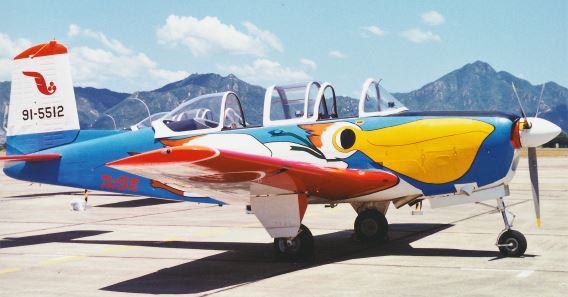 (Photo: Takao Kadokami)
(Photo: Takao Kadokami)
Katta-kun (カッタ君) was the name given to a pelican born in 1985 at a zoo in Ube, Yamaguchi Prefecture, to two birds originally from Calcutta, hence the name. Katta-kun gained local lasting fame for managing to escape and venturing into a nearby kindergarten, where he became a regular visitor. (Katta-kun remained at the zoo until his death in 2008, outliving ’512, which was built in 1979 but scrapped early in 2006, by nearly two years.)
The left side of the aircraft can be viewed here (link), and another photo of the aircraft exists with its last three ‘512’ repeated on its nose.
As the following photos show, apparently no expense or effort was spared in expanding on the pelican/zoo themes for air show publicity purposes.
July 1994 (2) “Pereena-chan” pelican design 11-5540 (link)
 (Photo: Takao Kadokami)
(Photo: Takao Kadokami)
Another aircraft was suitably painted and named after a female member of the same zoo’s pelican colony, Pereena-chan (ペリーナちゃん).
July 1994 (3) Animal and bird designs: pelicans (91-5518 [link]), penguin (01-5526), squirrel (01-5528), rabbit (01-5530), tortoise (01-5531), chicken (01-5534 [link]) and koala bear (01-5547, below)
 (Photo: Takao Kadokami)
(Photo: Takao Kadokami)
Aside from the major pelican artworks, no less than seven other aircraft were adorned with designs applied to their rear fuselages cut from sticky sheeting for ease of removal at the end of the air show.
July 1995 Hofu-Kita AB 40th Anniversary (1) 11-5540 (01-5530 according to The Collected Special Scheme [sic] of JASDF Aircraft)
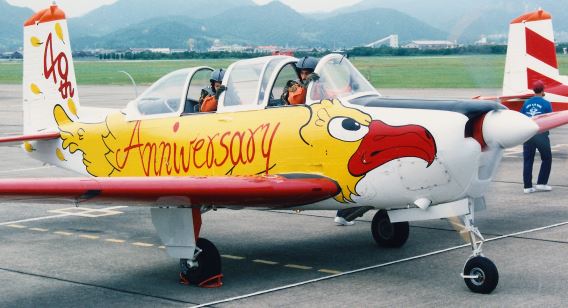 (Photo: Takao Kadokami)
(Photo: Takao Kadokami)
The base anniversary provided an opportunity to again dress up one of the aircraft that had been decked out as a pelican the previous year, this time as an eagle. The fuselage was painted, but the markings were reportedly cut-out stickers.
July 1995 Hofu-Kita AB 40th Anniversary (2) 91-5516
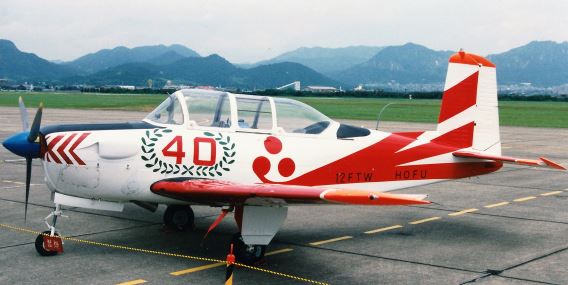 (Photo: Takao Kadokami)
(Photo: Takao Kadokami)
This event marked the start of the trend of providing one specially marked aircraft for the flying display and another for static display; only one aircraft was prepared from 2001. As also seen in the monochrome photo below, a T-3 was also given a splash of red paint in the form of an enlarged and modified squadron marking on the occasion of the 40th anniversary. Both aircraft (below) had their serial numbers and fuselage national markings removed.
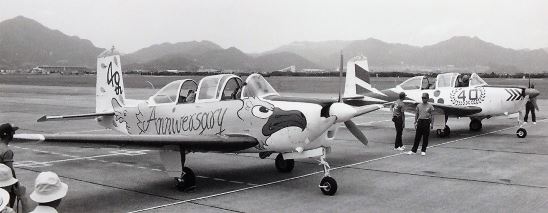 (Photo: Takao Kadokami)
(Photo: Takao Kadokami)
1996 81-5503 and 01-5523
 Not of the best quality, but thus far the only online record found of the gaudy
Not of the best quality, but thus far the only online record found of the gaudy
participants from the 1996 event. (Photo: JASDF Hofu-Kita AB website gallery)
’503 had an enlarged 12th FTW marking on its forward fuselage, and three gold star-spangled black stripes extending back to a red ‘41’—signifying the 41st anniversary of the forming of the branch school of 1st Flying Training School—in a green-wreathed yellow disk aft of the cockpit. In contrast, overall blue and white ’523 had ‘T-3 Air Festival 96’ emblazoned in blue along its fuselage sides. As a yellow ‘XII’, the Roman numeral for 12, was added to the blue forward part of the tail, only the ‘23’ of the aircraft’s serial remained on the rudder on the left side, and ’01-’ on the right. (Photos of both these aircraft can be found on page 142 of The Collected Special Scheme (sic) of JASDF Aircraft.)
1997 91-5506 and 01-5534
’506 sported a design mainly consisting of the 12th’s marking of the three arrows of legend and a black-edged fuselage band. The design applied to 01-5534 featured a crudely written ‘12FTW’ with an elongated version of the red squadron marking on the side of a light blue fuselage with an eagle head marking on the nose.
1998 (1) 91-5512 (link); (2) 11-5540 (link) (link)
Two of the old-stager aircraft used in previous years were again given special makeovers, the designs incorporating blue and white stripes and cartoon chicks, respectively.
1999 81-5504 and 91-5517
 81-5504 and 91-5517 at the 1999 event. The latter is now displayed, in the standard T-3
81-5504 and 91-5517 at the 1999 event. The latter is now displayed, in the standard T-3
scheme, at JASDF Air Park, Hamamatsu. (Photos: JASDF Hofu-Kita AB website gallery)
‘517 featured a flying helmet-wearing pelican, but the elements common to both designs were chicks, symbolizing tyro pilots, and ribbons.
Oct. 2000 Yamaguchi Kirara Band 01-5534 (link) and 11-5540 (link)
 (Photo: JASDF Hofu-Kita AB website gallery)
(Photo: JASDF Hofu-Kita AB website gallery)
The aircraft carried elaborate designs featuring the musical instrument-playing mascots of the 山口きららバンド (Yamaguchi Kirara Band) used to promote the 2001 Japan Expo that was held in Yamaguchi Prefecture, where Hofu AB is located. Unfortunately, J-HangarSpace has thus far only been able to find links to photos showing the left-hand sides of these aircraft.
July 2001 Cartoon bird theme
(link) (link) 81-5506 (link)
The two chicks following an adult bird presumably symbolized the 12th’s training role.
2002 FIFA World Cup Korea-Japan 81-5508 (link)
A rabbit kicking a yellow and orange flame-trailing football provided the main elements to this design.
July 2003 Ahead of JASDF 50th Anniversary in 2004 01-5524
Crossed swords, the head of a samurai and the kanji 武蔵 (Musashi) over a hinomaru, alluding to the swordsman and philosopher Musashi Miyamoto (c. 1584–1645), were prominent along the fuselage. プレ50周年 (pre-50th anniversary) appeared in red and pink on the rear fuselage of this the last T-3 to receive the full special marking treatment, as the type was to disappear from the skies over Hofu-Kita in January 2005.
 No special markings, but apparently a special person on board, as evidenced by the sign
No special markings, but apparently a special person on board, as evidenced by the sign
‘VIP’ in the cockpit side window. (Photo [Tsuiki, Nov. 1994]: Rob Schleiffert)
T-7 Special Markings
Whereas the 11th FTW has all but abandoned special markings since the start of its T-7 operations, the 12th has avidly carried on the tradition for its annual air show. Some impetus was again supplied by the first year of T-7 operations, 2004, coinciding with a major milestone JASDF anniversary. The only year missed since then was 2011, the year of the Great East Japan Earthquake and tsunami, when there was no air show held. At that time, the nation was being asked to show jishuku (self-restraint) out of respect to the disaster victims and deference to those still experiencing hardship.
July 2004 JASDF 50th Anniversary 46-5911
Again primarily involving the use of an enlarged version of the unit marking on its fuselage sides—to express hope and unity, according to one Japanese source—the design was intended to evoke the plum blossoms that bloom at the Tenmangu Shrine in Hofu. Added to the nose was an eagle against a hinomaru background. The aircraft is seen here (link) at Komatsu in September 2004.
 (Photos: JASDF Hofu-Kita AB website gallery)
(Photos: JASDF Hofu-Kita AB website gallery)
July 2005 Hofu-Kita AB 50th Anniversary 46-5910
Incorporating 12FTW and continuing the bird theme, the nose marking was reversed and placed further back on the right side (link). The event being commemorated appeared in English, and in Japanese 防府北基地開設50周年 on a red scroll, on the fuselage sides. The only other addition to an overall white fuselage were areas of yellow.
July 2006 Pufferfish design 36-5904
 (Photo: JASDF Hofu-Kita AB website gallery)
(Photo: JASDF Hofu-Kita AB website gallery)
As Yamaguchi Prefecture is one of the main areas in Japan for the specialist restaurants that serve fugu (pufferfish or blowfish), the fuselage was expertly transformed into the body of a cartoon fish (link), even down to the gills added forward of the cockpit. Both fuselage sides carried おいでませ (oidemase), the Yamaguchi dialect word for welcome, and the standard Japanese 防府北基地へ, meaning “to Hofu-Kita AB”. Note that the fisheye was open on the left side, happily closed on the right (link), where heart-shaped bubbles came from the fish’s mouth.
June 2007 66-6942 (link)
Comprising cartoons of JASDF personnel, pilots and maintenance crew as well as some clouds, the design on one side (link) was applied in reverse on the other (link) of an all-white fuselage. The words HOFU AIR FESTA 2007 appeared on both sides of the nose.
 (Photos: JASDF Hofu-Kita AB website gallery)
(Photos: JASDF Hofu-Kita AB website gallery)
June 2008 56-5931
According to the August 2008 issue of JWings magazine, 12th FTW unit members and their families as well as people with JASDF links were asked for suggestions for the HOFU AIR FESTA 2008 star attraction artwork. ‘Design by T. MURAKAMI’, which appeared on the tailfin strake (link), was presumably the name of the retired JASDF member whose design the magazine states was adopted (though see May 2009). The names of the four-man crew who prepared the aircraft were added under the tailplane (link).
May 2009 Flight safety milestone 46-5916
 (Photo: JASDF Hofu-Kita AB website gallery)
(Photo: JASDF Hofu-Kita AB website gallery)
The main slogans this year were HOFU AIR FESTA 2009 and, ahead of the tailplane, 無事故22万時間達成 220,000 accident-free flight hours. The technique of reversing the titling on one side was again used, in this case including the Japanese, too. Japanese script often appears read from right to left, but here the ‘22’ was reversed, too. Note that the tailfin strake again bore the same name (‘design T. MURAKAMI’) from the previous year, only this time alongside the names of the five-man STAFF.
 Standard practice for a time was to have one year’s design featured
Standard practice for a time was to have one year’s design featured
on publicity material for following year’s event.
June 2010 Hofu-Kita AB 55th Anniversary 86-5948
A great shot (link, scroll down almost to the foot of the page and click to enlarge) from above the aircraft provides a wealth of detail of this eye-catching yet simple red and white design. The aircraft also appears in this YouTube video (link).
 Just about discernible on the aircraft nearest the camera in this lineup is the red-and-white
Just about discernible on the aircraft nearest the camera in this lineup is the red-and-white
badge carried to mark the 55th anniversary of Hofu-Kita AB.
(Photo [June 2010]: kazkaz via Twitter [@kazkaz04tw])
 (Photos: JASDF Hofu-Kita AB website gallery)
(Photos: JASDF Hofu-Kita AB website gallery)
 For that year’s base anniversary, the 2010 design was completed in
For that year’s base anniversary, the 2010 design was completed in
good time for it to appear on the event poster.
June 2012 36-5903
After the two-year interval brought about by the Great East Japan Earthquake of March 2011, the Hofu-Kita air show returned in 2012. A fuselage marking aft of the cockpit incorporated 絆 (kizuna, meaning bonds or ties), which had become the byword for recovery from the disaster and was voted the kanji that best encapsulated the year 2011. On both sides the kanji was combined with a dragon, the Chinese year sign for 2012, and plum blossoms. A dragon appeared to be climbing out of the lower engine cooling air vents on either side of the nose, as seen at the start of this YouTube video (link). The names of the three staff members involved with the project were again applied to the tailfin strake.
June 2013 (1) Choruru 46-5915
 (Photo: JASDF Hofu-Kita AB website gallery)
(Photo: JASDF Hofu-Kita AB website gallery)
This aircraft featured ちょるる (Choruru), the mascot originally created for the 66th Annual National Sports Festival of Japan and 11th Annual National Sports Festival for People with Disabilities—held in Yamaguchi Prefecture in 2011—and later used for tourism promotion and other initiatives. A close-up of the artwork on the right side of the fuselage can be found here (link), and the aircraft’s departure on a demo flight on the rainy air show day was recorded for posterity and placed on YouTube here (link).
June 2013 (2) Plum blossom 76-5945
The tasteful blossom design on this aircraft served as a backdrop for a hangar display at which visitors young and old could have their photos taken while wearing a pilot’s flying suit and helmet. The usable photographic evidence was, like blossom, sadly short-lived, but glimpses of the scheme can still be found on blogs (link) (link). As shown here (link), the design was only carried on the left side of the aircraft.
June 2014 46-5914
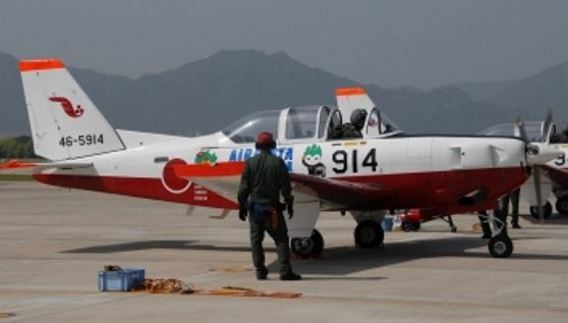 (Above and below) A simple design, of the two Hofu-Kita base mascots flanking the words
(Above and below) A simple design, of the two Hofu-Kita base mascots flanking the words
AIR FESTA HOFU 2014, was adopted in 2014. The three staff names were
applied forward of the fuselage hinomaru on the right-hand side.
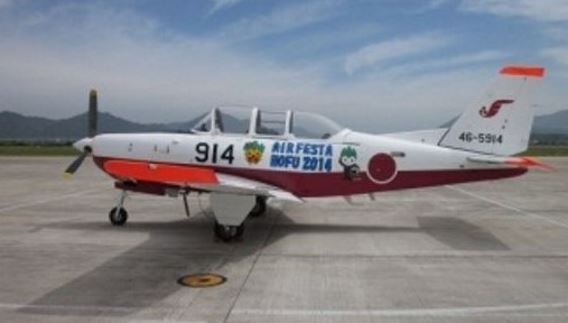 (Photos: JASDF Hofu-Kita AB website gallery)
(Photos: JASDF Hofu-Kita AB website gallery)
June 2015 Hofu-Kita AB 60th Anniversary 46-5911
The main elements of this colour scheme, kanji on red triangles, were placed above the wings (link), which normally remain untouched. The left wing had the kanji 俊, the right wing 鷲, which together are read shunshū and literally mean ‘excellent eagles’. They are taken from a stone monument at the base main gate, the inscription on which refers to Hofu-Kita’s role in training tyro pilots and translates as the ‘base of the excellent eagles’ cradle’. This was reportedly the last occasion that the specially marked aircraft was actually flown at the Hofu-Kita air show.
May 2016 Hofu-Kita AB 61st Anniversary 66-5943 (link)
Hofu-Kita’s “61th Anniviersary” (sic, link) was combined with the 80th anniversary of Hofu’s founding as a city (防府市制). The anti-dazzle panel was edged in blue and the same colour used for the tail, excluding the rudder. One of the two Hofu-Kita base mascots was “hiding” within the ‘0’ of 80th, while the other (apparently named 防 [Hō]) appeared low on the rear fuselage (link) with a speech bubble containing the words “がんばろう!熊本・大分!” (Hang in there Kumamoto, Oita), a reference to the areas that had suffered an earthquake the previous month.
May 2017 Meiji Restoration 150th Anniversary (Preview) 36-5905
 (Photo: JASDF Hofu-Kita AB website gallery)
(Photo: JASDF Hofu-Kita AB website gallery)
An historical theme was again chosen in 2017, looking ahead to the 150th anniversary of the 1868 Meiji Restoration (平成30年の明治維新150周年に向けて). This explains the orange, red and black やまぐち幕府ISHIN祭 (Yamaguchi Shogunate Restoration Festival) logo on the side of the fuselage and again, although the aircraft was not flown before the general public, in black only above the wings (link). Note that the intake on the right side of the engine seems to have carried some kind of checklist.
 (Photos [above and below]: Hamachi via Twitter @HamachiAir)
(Photos [above and below]: Hamachi via Twitter @HamachiAir)

June 2018 Meiji Restoration 150th Anniversary 76-5946 (link)
 (Photo: JASDF Hofu-Kita AB website gallery)
(Photo: JASDF Hofu-Kita AB website gallery)
A different aircraft was used for a design based on that from the previous year. Although the tailfin had been left as standard in 2017, a black area was added containing the staff names in English on the right side and the names of the design team in Japanese on the left side in white.
 (Photo: JASDF Hofu-Kita AB)
(Photo: JASDF Hofu-Kita AB)
The main changes were the addition of ornate red birds along the front fuselage and, replacing the logo, atop the wings as well as the kanji 飛 and 翔 (together meaning hishō, flying or soaring) added on either side of the fuselage hinomaru. The same logo was used on the fuselage, although this was now only in black.
 Having for many years used its aircraft as design canvasses to portray aspects of Japanese culture
Having for many years used its aircraft as design canvasses to portray aspects of Japanese culture
and history, the 12th FTW’s open day event in June 2019 would have been something of a let down
for some visitors. The T-7 on static display merely had a sticker placed on the right side of
the engine with a reference to the event being the first of the Reiwa era.
(Photo: りあじぇっと[Learjet] @roomskyguard via Twitter [link])
June 2022 Hofu-Kita AB 61st Anniversary 66-5937
 Note that the titling and markings differed on both sides. One the right side was 12th FTW in
Note that the titling and markings differed on both sides. One the right side was 12th FTW in
ornate titling, coupled with LTC “ROW” along the bottom of the front-seat cockpit framing.
The 61st Anniversary titling appeared only on the left side, underneath equally ornate
Hofu-Kita A.B. Flanked by stars, the name of the crew chief appeared in a panel
under the windscreen on the left side: C/C S.SGT TAKAFUMI INOUE.
 (Photos: [Top] 満艦飾 via Twitter @hamazk); [above] t.matsu via Twitter @tmatsu64799657)
(Photos: [Top] 満艦飾 via Twitter @hamazk); [above] t.matsu via Twitter @tmatsu64799657)
A sign placed in front of the aircraft when on static display on June 5 offered an explanation of the design concept: A symbol of Hofu-Kita AB, the T-7 gives the impression, closely related to Japanese culture, of powerfully cutting through the air with a calligraphy brush [hence the ornate titling]. At the same time, the students who are expert pilots in the making show that they are not satisfied with their current situation and are constantly striving for lofty goals as they fly off into the skies.In addition, following the establishment of the Space Operations Squadron [at Fuchu, Tokyo, in May 2020], at this year’s air festival we express our hope that Hofu-Kita AB too will further develop into the space field, and thus incorporated a starry sky into the design.
Two in-flight photos, taken from the left (link) and right (link) sides on June 1, 2022, show that the undersides were left untouched by the paint team.
June 2023 Hofu-Kita Air Show 46-5917
 The Japanese government having officially downgraded COVID-19 the previous month, a
The Japanese government having officially downgraded COVID-19 the previous month, a
decidedly upbeat design was selected for Hofu-Kita’s first air show of the post-pandemic
era. Plum blossoms are associated with Hofu Tenmangu, the local Shinto shrine.
The wings were again left untouched.
 (Photos [Top]: t.matsu via Twitter @tmatsu64799657;
(Photos [Top]: t.matsu via Twitter @tmatsu64799657;
[above] らぶらぶ via Twitter @mSEUJOi0OEl0ZGH)
 Shiawasemasu, the Japanese carried on both sides of the lower rear fuselage—note written from
Shiawasemasu, the Japanese carried on both sides of the lower rear fuselage—note written from
the right on the right-hand side—is an elevated expression of gratitude in the local dialect.
(Photo: JASDF Hofu-Kita AB via Twitter @hofukitabase)
 Having made regular appearances on specially marked aircraft since 2014, one of the
Having made regular appearances on specially marked aircraft since 2014, one of the
base mascots (Hō) was carried on both main undercarriage doors.
(Photo: JASDF Hofu-Kita AB via Twitter @hofukitabase)
The underside of the fuselage bore a decorative sequence along its centreline (from the front to the rear) of yellow and white plum blossoms, the kanji 幸 (good fortune, happiness) in red on a white disc, a cluster of five blossoms and then individual pink (larger in size) and yellow blossoms.
 (Photo: Japan Ministry of Defense/JASDF)
(Photo: Japan Ministry of Defense/JASDF)
|
13th FTW |
Formed | As NSF Provisional Matsushima Air Group: June 1, 1954 (Matsushima, U.S. Air Force T-6s) As JASDF Provisional Matsushima Air Group: July 1, 1954 As 2nd Flying Training School: Nov. 1, 1955 (Matsushima, T-6) As 13th FTW: June 1, 1959 (Flying Training Command, Utsunomiya, T-6) |
| Current Base | Ashiya (under Air Training Command, 1st/2nd Sqn, T-4) |
Its predecessor unit having moved from Matsushima to Utsunomiya on August 1, 1957, the 13th FTW officially came into existence on June 1, 1959, and also began operating the Fuji T-1 from Gifu the following year.
The Utsunomiya-based elements moved to Ashiya on September 25, 1962, and were joined by the T-1s on October 12, 1962. By late that year, the 13th was flying only the T-1.
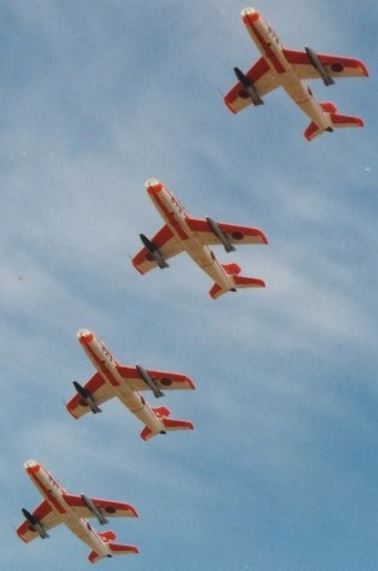 (Photo [Ashiya, Oct. 1990]: Takao Kadokami)
(Photo [Ashiya, Oct. 1990]: Takao Kadokami)
13th FTW Chronology
| 1954 | June 1 | NSF Provisional Matsushima Detachment commences training on U.S. Air Force T-6s |
| 1955 | Nov. 1 | Since July 1, 1954, known as JASDF Provisional Matsushima Detachment reforms as 2nd Flying Training School (FTS) |
| 1957 | Aug. 1 | 2nd FTS moves from Matsushima to Utsunomiya |
| 1959 | June 1 | 2nd FTS reforms as 13th FTW under Flying Training Command |
| 1960 | Aug. 1 | Gifu Flying Training Detachment forms, T-1 training commences |
| 1962 | Mar. 15 | T-6 training at Utsunomiya ends |
| Aug. 15 | 13th FTW headquarters element moves to Ashiya | |
| Oct. 12 | T-1 detachment moves from Gifu to Ashiya | |
| Oct. 20 | Changes to 13th FTW organization completed | |
| 1963 | Dec. 17 | 13th FTW suffers first fatalities when aircraft crashes at Ashiya |
| 1984 | May 23 | Receives prizes for completion of 110,000 accident-free flying hours and for fulfilling its mission |
| 1989 | Mar. 16 | Comes under Air Training Command |
| 1994 | July 20 | 300,000th flying hour on T-1 achieved |
| 1998 | Aug. 26 | Commences training on T-4 (trial course) |
| 1999 | June 1 | 1st Flying Training Sqn reforms, first half of basic flying course (T-4) commenced |
| 2000 | Dec. 14 | T-1 training ends, 2nd Flying Training Sqn reorganized |
| 2009 | June 1 | 50th anniversary |
| June 11 | Presented with award marking 50th anniversary | |
| Oct. 1 | Receives prizes for completion of 180,000 accident-free flying hours and for fulfilling its mission |
|
| 2010 | Oct. 19 | 190,000 accident-free flying hours |
| 2012 | Apr. 9 | 200,000 accident-free flying hours |
 A 13th Flying Training Wing T-4 heads toward the takeoff point at Ashiya AB in September 2000.
A 13th Flying Training Wing T-4 heads toward the takeoff point at Ashiya AB in September 2000.
 (Photo [Ashiya, February 2018]: 鳥天狗 via Twitter @EAGLE962)
(Photo [Ashiya, February 2018]: 鳥天狗 via Twitter @EAGLE962)
13th FTW Markings
The 13th’s tail marking is a rakish representation of the kanji for the number `13` (十三).
 (Photo [Ashiya, Mar. 1973]: Akira Watanabe)
(Photo [Ashiya, Mar. 1973]: Akira Watanabe)
(T-1) From 1964 to 1973, this appeared in yellow, after 1973 in white. For a brief time late in 1977, at least one aircraft assigned to the 2nd Sqn within the 13th FTW had this marking in dark green (link), before changing to blue that same year; the 1st Sqn continued to use the white marking.
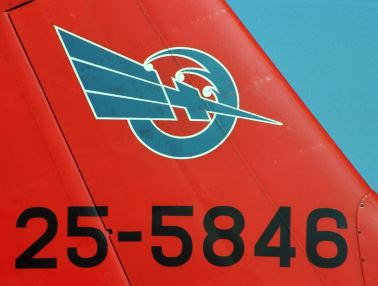 (T-1B, Ashiya, Sept. 2000)
(T-1B, Ashiya, Sept. 2000)
In April 1993, the ‘13’ marking was rearranged to incorporate waves symbolizing the Genkai Sea that lies off the northern coast of Fukuoka and Saga prefectures, as shown above.
(T-4) The 13th’s red and white T-4s continue to wear that same tail marking, in blue, today.
13th FLYING TRAINING WING SPECIAL MARKINGS
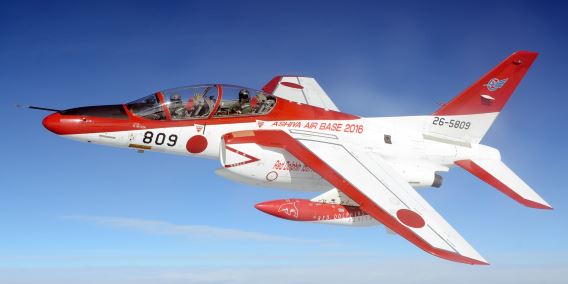 A fine study of a Kawasaki T-4 from the 13th Flying Training Wing at Ashiya, Fukuoka Prefecture.
A fine study of a Kawasaki T-4 from the 13th Flying Training Wing at Ashiya, Fukuoka Prefecture.
Specially painted to mark the type’s 15-year association with the unit for the Ashiya air show in
November 2015, the year on the fuselage inscription was changed from 2015 to 2016 for the
aircraft’s appearances at two displays in December. (Photo source: JASDF Ashiya AB)
(http://www.mod.go.jp/asdf/ashiya/gallery/index.html)
1988 Low-Visibility Research Scheme T-1A 05-5812
As previously noted in the case of the 11th FTW, for a period from the mid-1980s even training unit aircraft were used to test experimental camouflage patterns. In the case of the 13th FTW, a T-1A was painted in a three-tone matt grey, blue-grey and dark grey scheme that extended as far as the usually dayglo ornage wingtips. Although ostensibly a low-visibility scheme, the standard, white-edged hinomaru and ejector seat warning markings were retained.
 (Photos above and below [Ashiya, 1992]: genkai_daia via Twitter @genkai_daia)
(Photos above and below [Ashiya, 1992]: genkai_daia via Twitter @genkai_daia)

From the early 1990s, the 13th FTW initially confined its “special” markings to small motifs on aircraft noses and drop tanks. For example, at the 1992 Ashiya air show (above), ’813 had the words ‘First Hawk’ in English on its nose—a reference to 初鷹 (hatsutaka), the JASDF’s unofficial name for the type usually translated as Young Hawk—J▪A▪S▪D▪F on its rear fuselage and a dayglo orange rosette-like marking on its drop tanks. Also at the 1992 event, the nose of ’811 had 13FTW GENKAI (the 13th’s radio call-sign) in black cursive script above, in red, 初鷹 and the name of the aircraft’s maintenance crew chief, the latter being possibly one of the first instances of what was later to become common practice. Probably first seen on T-1B ‘865 in February 1983, shark’s teeth and eyes were painted on the drop tanks of otherwise standard T-1As in 1991 (’808) and 1992 (’815).
Naturally, a more elaborate design was used to commemorate the JASDF’s 40th anniversary in 1994, which set a trend for the following four years.
1994 JASDF 40th Anniversary T-1A 15-5823 (link)
 The scheme adopted by the 13th FTW to mark the JASDF 40th anniversary.
The scheme adopted by the 13th FTW to mark the JASDF 40th anniversary.
(Photo [Ashiya, October 1994]: Takao Kadokami)
An event was held at Hyakuri on October 1, 1994, for which one example of each aircraft type in the then current JASDF inventory was clad in a commemorative scheme. The 13th FTW provided the T-1 fleet representative, which incorporated gold-edged blue bands applied to its tail, rear fuselage and drop tanks. ‘40th Anniversary’ was ornately written on both sides of fuselage, and the right side of the nose had ‘Training Squadron’ in a kind of Gothic script and a tiny ‘13FTW’. The left side of the nose (link) featured the elaborate figure of a winged goddess pointing to four stars containing hinomaru, presumably symbolizing the 13th’s role in providing fighter pilots to each of the JASDF’s four regional air defence commands. (See 1998 40th Anniversary of T-1 First Flight below.)
October 1995 Ashiya Air Show T-1A 25-5838
The following year, an aircraft with special nose art (link) was debuted at the Ashiya air show. Seen here in close-up (link), the design featured a serpent-like dragon with a water ladle in its mouth seemingly pouncing on an あしや釜 (Ashiyagama), a well-known type of locally produced cast-iron kettle used in the tea ceremony. (At the same show, ’815 had the word ‘FESTIVAL’ arching over ’95 on both sides of its rear fuselage.)
Taken the following month, the photo here (link) shows ’838 with 祝新田原基地航空祭 (Celebrating the Nyutabaru AB Air Show) emblazoned along the side of a drop tank; note that the drop tanks fitted in October had carried the words ASHIYA▪AIR▪BASE in red.
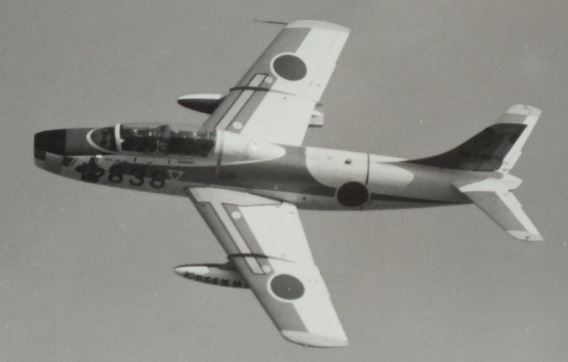 The script on its drop tanks amended accordingly, the above-mentioned specially marked
The script on its drop tanks amended accordingly, the above-mentioned specially marked
13th FTW T-1A was displayed at the Nyutabaru (above) and Tsuiki (below) air shows that
were held in November 1995. (Photos: Takao Kadokami)

1996 Ashiya Air Show T-1A 05-5808
Featuring on both sides of its nose a depiction of a straw doll—known locally as hassaku no uma (八朔の馬, meaning ‘August 1 [in old Japanese, using the lunar calendar] horse’, as written on the nosewheel doors) and made for the 300-year-old Ashiya version of a summer festival—one of the more flamboyant schemes was applied for the 1996 show. The summer festival has been designated as an Intangible Folk Cultural Asset but now takes place on the first two days of September to express the wish for babies’ healthy growth and upbringing. The white aircraft had three fetching dark blue fuselage stripes, above which was written AIR FESTIVAL ’96, ASHIYA AIR BASE FUKUOKA JAPAN, and its tail and drop tanks were decorated with a wave design vaguely reminiscent of The Great Wave off Kanagawa by the famous woodblock artist of the 18th and 19th centuries, Hokusai.
1997 Ashiya Air Show T-1A 15-5822
 “Over the Rainbow” at the 1997 Nyutabaru air show (Photo: Takao Kadokami)
“Over the Rainbow” at the 1997 Nyutabaru air show (Photo: Takao Kadokami)
Nicknamed “Over the Rainbow”, this colour scheme comprised black-outlined (from the front of the nose) red, yellow and orange stripes beneath a light blue fuselage stripe, which symbolized the nearby Onga River; the “rainbow” reappeared above the “river” behind the cockpit canopy. In-flight photos show that the three-colour stripe wrapped underneath the nose. The colours were repeated in a blue-orange-blue pattern on the drop tanks, which were emblazoned with AIR FESTIVAL ’97 on a yellow stripe.
Added above あしや (Ashiya) crudely written in red on the tail was a hamayu (giant crinum lily), an endangered species of white flower that is native to a beach park in Natsuigahama, in the southern part of the town of Ashiya, and a designated prefectural natural treasure.
1998 40th Anniversary of T-1 First Flight (?) T-1As 15-5820, 15-5823
According to the caption, a photo on a Japanese website shows two specially marked aircraft at a 13th FTW event marking the 40th anniversary of the T-1’s first flight in 1958. One (’823) appears to still be in the special markings that were applied to the aircraft for the JASDF’s 40th anniversary four years before, in 1994, whereas the other aircraft has had just the dark blue bands added. The photo was likely taken on September 30, 1994, when both these aircraft were withdrawn from service, so the event would have served a dual purpose.
1998 Ashiya Air Show T-1A 15-5826
 (Photo [Ashiya 1998]: Takao Kadokami)
(Photo [Ashiya 1998]: Takao Kadokami)
Reportedly inspired by the sunsets over the Genkai Sea, the predominantly red and blue scheme incorporated an eagle’s head on each side of the nose and fuselage hinomaru that appeared to be on the point of sinking into the waves. Finishing touches were ‘ASHIYA 1998’ on the left fuselage (reversed on the right), ‘13FTW’ on the rear fuselage and ‘Air Festival’ on the ferry tanks.
Seemingly triggered by the JASDF’s 50th anniversary in 2004, the 13th has in recent years continued the practice of giving at least one aircraft a special makeover in time for the Ashiya air show. This usually falls in October or November, after which the aircraft is made available for other base open days in southern Japan.
There follows an overview of some of the T-4 colour schemes selected for the Ashiya air show and other events.
October 2004 JASDF 50th Anniversary 36-5810 (link); 36-5811 (link)
For this major milestone event, an aircraft from each of the wing’s constituent squadrons had its tail decorated after a request for personnel to suggest designs had resulted in 32 submissions.
 (Photo [Ashiya, Oct. 2004]: Takao Kadokami)
(Photo [Ashiya, Oct. 2004]: Takao Kadokami)
The more elaborate design (above) was multicoloured and featured a dolphin jumping through the number ‘50’ to signify, according to the November 2004 issue of JWings magazine, the beginning of the next decade. The five tail stripes denoted each of the JASDF commands—air defense (red), air support (yellow), air development and test (green) and air training (blue) as well as Air Materiel Command and each of its supply depots (white)—and, at the 13th FTW level, the headquarters (red), training (yellow), maintenance (green) and airfield operations (blue) units, the white stripe incorporating the resident Air Rescue Wing squadron and the 3rd Technical School as well as the Ashiya air traffic control and weather squadrons.
 (Photo [Ashiya, Oct. 2004]: Takao Kadokami)
(Photo [Ashiya, Oct. 2004]: Takao Kadokami)
The other design (above) simply incorporated the wing marking into the 50th anniversary logo, and the drop tanks bore the 13th FTW’s official emblem. In this case, certain additional elements, such as the messages on the fuselage and drop tanks, still formed the basis of the annual design.
October 2005 Ashiya Air Show
A report in the November 2015 issue of JWings showed that the only specially marked aircraft (16-5799) had merely had 芦屋基地航空祭 (Ashiya Air Base Air Show, in gold) and 2005 (in black) as well as the 13th FTW emblem applied to its drop tanks.
September 2009 13th FTW 50th Anniversary 16-5802 (link)
 Five years after the JASDF’s 50th anniversary, the 13th celebrated its own half-century with an
Five years after the JASDF’s 50th anniversary, the 13th celebrated its own half-century with an
ostentatious design. (Photo [Ashiya, Sept. 2009]: ‘Amayagan’ via Wikimedia Commons)
 The same aircraft graced the Nyutabaru air show in November 2009. (Photo: Takao Kadokami)
The same aircraft graced the Nyutabaru air show in November 2009. (Photo: Takao Kadokami)
November 2014 JASDF 60th Anniversary 06-5789 (link), 26-5806
 (Photo [Tsuiki, Nov. 2014]: Takao Kadokami)
(Photo [Tsuiki, Nov. 2014]: Takao Kadokami)
After a five-year hiatus, including 2011 when Ashiya’s 50th anniversary passed unnoted in marking form—most likely in keeping with the official line calling for restraint on celebrations in the aftermath of that year’s Great East Japan Earthquake—two aircraft carried special markings for the JASDF’s diamond jubilee. Both designs had been created by two of the five-man team of 13th FTW personnel that was placed in charge of the project.
That pictured above featured a retro design, incorporating the 13th FTW tail marking in the form it appeared during the T-1 era with a ‘60’ added. The aircraft was thus split into a forward fuselage in the current standard “Red Dolphin” T-4 scheme and a rear fuselage replicating that of a T-1 in the 1960s. The 60th anniversary logo was carried on the engine intakes, and ‘since 1954 Anniversary60th’ painted along the outside of the ferry tanks.
 The 60th anniversary logo, as carried on many JASDF aircraft in 2014.
The 60th anniversary logo, as carried on many JASDF aircraft in 2014.
The second aircraft (link) was simply given a new tail design by adding ‘60’ to the standard unit marking, the ‘6’ being partly formed by a leaping red dolphin; the unit marking “speared” the ‘0’ on the right side. Following the slanting line of the red tail were the words ‘JAPAN AIR SELF DEFENSE FORCE 60th Anniversary’ in gold, and the rudder carried the words ‘since 1954’ in white. The 60th anniversary logo was again carried on the engine intakes, and ‘RED DOLPHINS’ painted along the outside of the ferry tanks.
More photos of both aircraft can be found here (link) and here (link).
November 2015 Ashiya Air Show 26-5809 (standard scheme), 86-5767 (link, two-tone grey)
 (Photo: JASDF Ashiya AB)
(Photo: JASDF Ashiya AB)
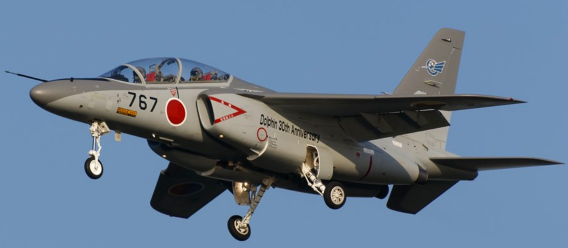 (Photo: kazkaz via Twitter @kazkaz04tw)
(Photo: kazkaz via Twitter @kazkaz04tw)
These aircraft were simply painted with the words ‘Red Dolphin 15th Anniversary’ in red and ‘Dolphin 30th Anniversary’ in black to mark, respectively, 15 years of T-4 training at Ashiya and 30 years since the first flight, on July 29, 1985, of the T-4 prototype. (The 13th often refers to the T-4 as the Dolphin, and calls its unofficial display team the Red Dolphins.) Both also bore the words ASHIYA AIR SHOW 2015 for the home base event, but in the case of ’809 these were subsequently changed to ASHIYA AIR BASE 2016 (above) prior to doing the rounds of other air shows, including Tsuiki (link).
October 2016 Ashiya Air Show 06-5634 (1,000 T-4 pilots graduated), 26-5807 (two-tone grey)

The pair of 13th FTW T-4s specially painted for publicity purposes, photographed in December 2016.
One sports a two-tone grey scheme, while a sister aircraft specially painted for the base air show in
October bears the slogan 1000 T-4 student pilots graduated to mark a major unit milestone.
The upper fuselage wording was changed from ASHIYA AIR SHOW 2016 to ASHIYA
AIR BASE 2017 for the aircraft’s appearances at displays in December.
The photo below shows that the intake marking carried on the starboard side is that of the 1st Sqn
of the 13th FTW; that on the port side is of the wing’s 2nd Sqn. (Photo source: JASDF Ashiya AB)
(http://www.mod.go.jp/asdf/ashiya/gallery/index.html)
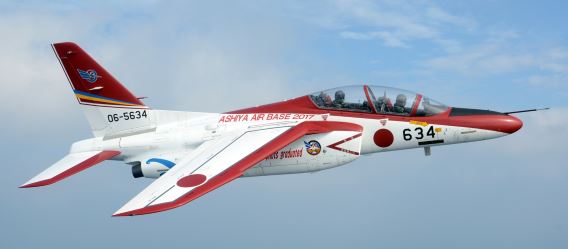
The January 2017 issue of Kōkū Fan contained an explanation of the design elements of the more colourful of the two aircraft specially marked for the occasion. Aside from the fuselage slogan, commemorating the milestone the 13th FTW had reached on August 29, 2016, ’634 had a blue wave on either side of its rear fuselage, symbolizing the Genkai Sea that lies off the northern coast of Fukuoka and Saga prefectures; Genkai also happens to be the radio call-sign of the 13th FTW’s 2nd Sqn. The tail stripes were in the colours of both the squadrons that make up the 13th. The other aircraft essentially replicated the two-tone grey scheme of the previous year, darker grey being applied on what are normally the red areas of the standard scheme. Although it had been planned for both aircraft to participate in the traditional flypast that opens an air show, ’807 developed a minor technical fault on the day and was thus confined to the static display.
 (Above and below) Close-ups of the fuselage-side artwork applied to ’634 in 2016, which included
(Above and below) Close-ups of the fuselage-side artwork applied to ’634 in 2016, which included
the emblems of the two squadrons that make up the 13th FTW.
 (Photos: JASDF Ashiya AB)
(Photos: JASDF Ashiya AB)
The more flamboyant aircraft was also displayed at the Nyutabaru (link) and Naha shows in December 2016.
 A closer look at the same specially painted two-tone grey T-4 at the 2016 Ashiya air show.
A closer look at the same specially painted two-tone grey T-4 at the 2016 Ashiya air show.
(Photo: ‘Amayagan’ via Wikimedia Commons)
November 2017 Tsuiki Air Show and December 2017 Naha Air Show 96-5777
 (Above and below photos [Tsuiki, Nov. 2017]: Hunini via Wikimedia Commons)
(Above and below photos [Tsuiki, Nov. 2017]: Hunini via Wikimedia Commons)

Unusually, as the Ashiya show was postponed from autumn 2017 to February 2018, specially painted aircraft attended the base events at Tsuiki (link, and as seen above) and Naha (link). (See also the in-flight photo, showing the aircraft with the fuselage wording updated to 2018, at the top of this website page.)
February 2018 Ashiya Air Show 06-5789 (link)
 (Photo [Ashiya, February 2018]: 鳥天狗 via Twitter @EAGLE962)
(Photo [Ashiya, February 2018]: 鳥天狗 via Twitter @EAGLE962)
For the rescheduled fiscal 2017 Ashiya base event, a four-man team used a projector to add the words 2018 ASHIYA AIR BASE FESTIVAL to the tail and fuselage of a standard T-4. According to the show report in the May 2018 issue of Kōkū Fan, the pair of leaping dolphins along the lower fuselage on each side (link) symbolized a student pilot and instructor. Although seemingly comparatively simple markings, the fuselage curves reportedly made achieving an overall balance a very painstaking process.
October 2018 Ashiya Air Show 06-5636 (ribbon design, link)
Highlighted in the show report that appeared in the January 2019 issue of Kōkū Fan, the special aircraft markings for the second base event of 2018 (also seen to good effect here, link) comprised two elements. The overall theme was to remember those affected by the natural disasters that had befallen western Japan in particular during the course of the year (link).
Designed by Takezō Ikegami, a fifth-year student at a high school in Kokura, Fukuoka Prefecture, the tri-coloured nose flash symbolized the unity of SDF personnel who play an active and vital role in disaster relief operations. The brainchild of Master Sergeant Sayuri Ushijima, a woman who is a member of Ashiya’s air traffic control personnel, the fuselage ribbon expressed gratitude to those who supported the SDF’s efforts and those who had come to the event. Added above the ‘Ashiya 2018’ banner on both sides of the fuselage beneath the wings was the slogan がんばろう 西日本!! (Gambarō Nishinippon!!), here meaning ‘let’s all hang in there western Japan!’ The names of the two designers were painted on the nosewheel door.
Having been out of action for about a week while a four-man team applied the special markings, the aircraft was back in its standard colour scheme by the end of the same month.
October 2019 Ashiya 60th Anniversary Air Show 16-5657
 (Photo [Ashiya, October 2019]:だいちゃん(飛行機大好き家族) via Twitter @hikokikazoku)
(Photo [Ashiya, October 2019]:だいちゃん(飛行機大好き家族) via Twitter @hikokikazoku)
Around 22,000 spectators attended this event, which featured a T-4 sporting a combination of previous design elements repeated on both the left (link) and right (link) sides. There were a total of 13 dolphins on the aircraft, including one “hidden” on the nose.
March 2022 Ashiya AB 60th Anniversary 06-5647
 (Photo [Mar. 2, 2022]: jibitz via Twitter @jd921858)
(Photo [Mar. 2, 2022]: jibitz via Twitter @jd921858)
In a throwback to the early T-1 era, the aircraft is partly orange. The 60th anniversary logo and the 13th FTW emblem appear on both fuselage sides, the 60th anniversary badge on both sides of the tail fin. Not only the vertical stabilizer but also the upper surfaces of the wings wear the 13th FTW’s unit marking, in solid blue on the left, blue outline on the right. Note that the words 1st Flight Training Squadron (of the 13th FTW) have been added to the tail, following the slanted angle of the base of the orange section.
 (Photo: JASDF Ashiya AB @jasdf_ashiya)
(Photo: JASDF Ashiya AB @jasdf_ashiya)
 The main logo (above) and 13th FTW badge were placed on both sides of the fuselage, and the
The main logo (above) and 13th FTW badge were placed on both sides of the fuselage, and the
dolphin anniversary badge (below) applied to both sides of the tail fin.
 (Images: JASDF Ashiya AB)
(Images: JASDF Ashiya AB)
|
14th FTW |
Formed |
As Branch School of 2nd Flying Training School: |
| Disbanded | Mar. 15, 1963 (at Utsunomiya, T-6) |
On December 1, 1956, a branch school of the 2nd Flying Training School formed at Yanome airfield, which was renamed Sendai airfield upon its return to Japanese control the following year. Re-designated as the First Branch School of the 2nd Flying Training School on August 1, 1958, and as the 14th FTW 10 months after that, the unit moved to Utsunomiya on March 15, 1962, exactly a year before its disbandment.
Although the unit had ceased to exist 55 years ago, a now deleted news item on the Hyakuri AB website reported that, on September 9, 2018, a group of JASDF veterans and current base personnel travelled to Mt. Kaba in Ibaraki Prefecture. They cleaned a monument and held a service in memory of the two pilots who lost their lives when their 14th FTW T-6 crashed in the mountainous Niihari district on September 20, 1962. Another incident, on May 24, 1960, had claimed the life of another pilot, when his aircraft had come down in the sea off Sendai.
|
15th FTW |
Formed |
As Matsushima Detachment, |
| Disbanded | May 30, 1964 (at Shizuhama, T-6) |
Having initially formed at Matsushima, the name change from the Matsushima Detachment to Detachment 2 of the 2nd Flying Training School coincided with a move to Shizuhama. The short-lived 15th FTW was disbanded one day short of its fifth anniversary.
According to the information carried on the 11th FTW T-3 specially marked to celebrate the 50th anniversary of the JASDF in 2004, the 15th FTW trained a total of 371 pilots during the course of its six-year history at Shizuhama, to where the then Second Branch School of the 2nd Flying Training School had moved in 1958.
The 15th enjoyed a better safety record than its sister units. The only recorded incident occurred on February 13, 1961, when the crew fortunately escaped unharmed after their aircraft had come down in a field near their base.
2nd Flying Training School/15th FTW Tail Markings
From 1958 to 1960, the 2nd Flying Training School’s Shizuhama-based (Second Branch School) aircraft carried a tail marking that comprised two horizontal red stripes, on which was superimposed an offset, stylized curved ‘S’ for Shizuhama. At some stage in 1960, the design was changed to a white-capped, blue image of Mt. Fuji placed offset on a blue rectangular stylized ‘S’, again standing for Shizuhama. (The earlier marking was resurrected with the ‘S’ taking on a slightly modified, more lightning flash form by the 11th FTW [q.v.]).
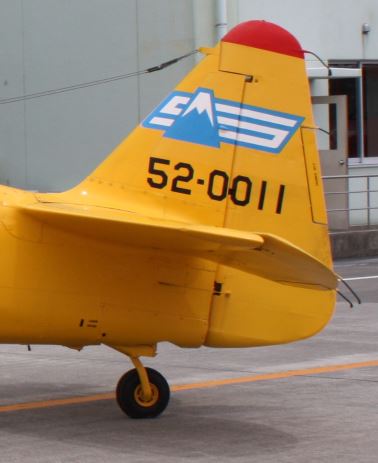 The marking adopted by the 15th FTW in 1960 is carried on the T-6 preserved at Shizuhama.
The marking adopted by the 15th FTW in 1960 is carried on the T-6 preserved at Shizuhama.
|
16th FTW |
Formed | As Provisional Ashiya Air Group: Aug. 1, 1954 (T-33A) As Provisional Tsuiki Air Group: Jan. 20, 1955 (T-33A) As 3rd Flying Training School: Oct. 1, 1957 (T-33A) As 16th FTW: June 1, 1959 (Flying Training Command, T-33A) |
| Disbanded | Oct. 26, 1964 (at Tsuiki, T-33A) |
Taken from an album compiled by the contributor’s father, a series of rare images of 16th FTW T-33As at Tsuiki appeared on a Japanese website that is currently being revamped. Closer inspection of the view across the apron reveals that the row facing the camera are all Lockheed-built aircraft, and that those in the background were all built by Kawasaki, so the caption writer wonders whether they were operated separately. (In the photo, the second aircraft from the left in front remains on display at Tsuiki to this day, that nearest the camera at Hofu-Kita.)
 T-33As of the short-lived 16th FTW at Tsuiki in December 1962 (Photo: Takao Kadokami)
T-33As of the short-lived 16th FTW at Tsuiki in December 1962 (Photo: Takao Kadokami)
Two 16th FTW pilots managed to eject safely from their aircraft before it crashed north of Mt. Aso, Kumamoto Prefecture, on October 28, 1960. Sadly, even in the month after the unit’s formation, others were not so fortunate, as the following table shows:
| July 20, 1959 | Pilot reported as missing after his aircraft crashes into sea off city of Ube, Yamaguchi Prefecture |
| Mar. 12, 1962 | Pilot killed in crash at night into sea off Sukumo, Kochi Prefecture |
| Apr. 11, 1962 | Crashed onto house in Itazuke, Fukuoka Prefecture. Pilot and two people on ground killed |
| Mar. 3, 1964 | Both pilots killed when aircraft crashes in mountains soon after takeoff from Tsuiki AB |
Upon its disbandment, the 16th’s aircraft were immediately passed to the 33rd Sqn, which had formed that same day.
16th FTW Tail Marking
At some stage, a broad dayglo red horizontal stripe was introduced and remained the unit’s simple marking right up to its disbandment.
 (Photo [Tsuiki, September 1963]: Takao Kadokami)
(Photo [Tsuiki, September 1963]: Takao Kadokami)
|
17th FTW |
Formed | As Branch School of 3rd Flying Training School: Dec. 1, 1957 (Nyutabaru, T-33A) As 17th FTW: June 1, 1959 (Flying Training Command, T-33A) |
| Disbanded | Jan. 25, 1963 (at Nyutabaru, T-33A) |
This squadron was based at Nyutabaru, where it had originally formed as a branch school, for all of its short existence.
The unit made the headlines for unfortunate reasons from July 5 to July 13, 1961, when a search was conducted for the crew members from a pair of its T-33As that had collided 17 nautical miles (32km) off Aburatsu, Miyazaki Prefecture. Two pilots were successfully rescued, but one was killed and the other reported missing. The unit had lost a pilot on March 2, 1960, when an aircraft crashed into the sea off Kanoya, Kagoshima Prefecture.
 A bleak, aircraft-less scene from the 17th FTW’s disbandment ceremony in January 1963
A bleak, aircraft-less scene from the 17th FTW’s disbandment ceremony in January 1963
(Photo: JASDF Nyutabaru AB)
17th FTW Tail Marking
 The 17th FTW marking being applied to the tail of a T-33A soon after the unit’s formation.
The 17th FTW marking being applied to the tail of a T-33A soon after the unit’s formation.
(Photo: JASDF Nyutabaru AB)
For its brief time on active service, the 17th FTW’s T-33As carried a more elaborate tail marking suitable for a unit based in Miyazaki, which is steeped in Japanese history. Resembling a gold eight-pointed star, the marking was actually of Yata no Kagami, the octagonal mirror that forms part of the imperial regalia of Japan. This was partly obscured by a red stylized ‘17’.
|
|
Formed | As T-2 Operational Flight Evaluation Group: Mar. 31, 1975 (4th Air Wing, Matsushima) As Provisional 21st Sqn: Mar. 25, 1976 As 21st Fighter Training Sqn: Oct. 1, 1976 (4th Air Wing, T-2/T-33A) |
| Current Base | Matsushima (4th Air Wing, F-2B/T-4) |
 An aircraft from the T-2 Operational Flight Evaluation Group, a forerunner of the 21st Sqn, on the
An aircraft from the T-2 Operational Flight Evaluation Group, a forerunner of the 21st Sqn, on the
ramp at Matsushima in August 1975. (Photo: Akira Watanabe)
The unit that had originally formed as the T-2 Operational Flight Evaluation Group in March 1975 was ultimately officially designated the 21st Sqn with a standard T-2 complement of 25 aircraft on October 1, 1976. In between times, instructors and, from April 1976, the first course of four students were trained by the Provisional 21st Sqn.
Aerobatic flight training on the T-2 commenced on July 1, 1977, and, with a view to replacing the Blue Impulse team’s F-86Fs with the T-2, the Air Staff Office instructed dedicated studies into the type’s feasibility in March 1978. The culmination of these studies was the performance by six T-2s on the day of the 545th and final official show by the team on the F-86F at Iruma on February 8, 1981. Mitsubishi rolled out the first Blue Impulse-standard T-2 on August 11 that same year.
On January 12, 1982, the Sengi Kenkyūhan (Combat Research Group, the official name of the Blue Impulse), which had been disbanded when temporarily placed under the 35th Sqn in the previous month, was reformed under the 21st to allow the team to reform on the T-2.
 Iwakuni, May 5, 1994 (Photo: Margaret Stalker)
Iwakuni, May 5, 1994 (Photo: Margaret Stalker)
Blue Impulse Chronology (Part 2/3)
| Blue Impulse T-2 Era (1981–1995)* | |
| Feb. 8, 1981 | Six T-2s also perform aerobatic display at final Blue Impulse F-86F display, Iruma AB |
| Jan. 12, 1982 | Team officially reforms, again as the Combat Research Group, with seven T-2s within 21st Sqn, 4th Air Wing, at Matsushima |
| July 25, 1982 | First official four-aircraft display, at Matsushima, limited to low pass due to bad weather |
| Aug. 8, 1982 | First full display programme performed at Chitose AB show |
| Nov. 14, 1982 | Capt. Kiyoshi Takashima killed when his aircraft crashes onto buildings in town of Takaoka during Hamamatsu air display. Tragic incident also claimed lives of 10 people and injured 13 others on ground |
| Feb. 1983 | Restart of training flights |
| Oct. 30, 1983 | Return to display flying made with appearance at SDF review, JGSDF Asaka |
| Nov. 1983 | Maintaining tradition, team draws logo of international aerospace show in sky above Gifu AB venue (Nov. 3, 5) and performs flypast (Nov. 6) |
| July 29, 1984 | Perform five-aircraft display at Matsushima air show |
| Apr. 1, 1990 | Draw EXPO90 flower logo in sky over Osaka |
| June 3, 1990 | 100th T-2 display, Gifu AB air show (T-4 selected as next Blue Impulse aircraft that month) |
| July 4, 1991 | Capt. Seiji Hamaguchi and Capt. Yuta Shikichi killed when their aircraft collide near Mt. Kinka, Miyagi Prefecture, when on training flight |
| Aug. 23, 1992 | Display flights resume with limited, four-aircraft performance at Matsushima |
| Aug. 1993 | Add one solo to increase displays to five aircraft |
| Aug. 7, 1994 | Perform six-aircraft display at Chitose air show |
| Nov. 26, 1995 | Perform what was to be final full, maximum ceiling programme at Nyutabaru AB show |
| Dec. 3, 1995 | Perform final (175th) display on T-2, a flypast at Hamamatsu AB show |
| Dec. 8, 1995 | Final T-2 aerobatic training flights conducted at Matsushima |
| Dec. 22, 1995 | 21st Sqn Combat Research Group (T-2 Blue Impulse) disbands* |
| * For Parts 1 and 3, the Blue Impulse F-86F era (1960–1981) and continuation on T-4, see 11th Sqn |
|
 The Blue Impulse team during its 175th and final public appearance flying the T-2,
The Blue Impulse team during its 175th and final public appearance flying the T-2,
Hamamatsu, December 3, 1995. (‘spaceaero2’ via Wikimedia Commons)
The T-4 having been selected as the Blue Impulse team’s next mount in June 1991, a unit to prepare for the type’s operation was formed within the 21st Sqn in October 1992.
The Provisional F-2 Training Sqn formed on April 1, 2002, and was officially numbered the 21st Sqn on March 29, 2004, the day that unit disbanded on the T-2; the last flight of a 21st Sqn T-2 had taken place on March 10.
The 21st’s 20th anniversary having been marked by a specially painted aircraft at the 1996 Matsushima air show (link), a 40th anniversary ceremony was held at the base on March 25, 2017.
Six years before, on March 11, 2011, the unit had been greatly affected by the tsunami triggered by the Great East Japan Earthquake. Matsushima was put out of action, and all 18 of the 21st’s F-2Bs were left either standing in water up to their engine intakes or in one case, as was shown in widely disseminated images, swept away by the sheer force of the tsunami and wedged against the side of a building. It was April 16 before training could be resumed, on aircraft loaned from other squadrons, from what was to be the unit’s home for the next five years, Misawa.
The first of the 13 F-2Bs deemed repairable arrived at Misawa on April 21, 2015. Including six of the refurbished aircraft, a total of 10 F-2Bs returned triumphantly to Matsushima on March 20, 2016, and recommenced training three days later.
 The last of the tsunami-damaged F-2Bs was returned to service following a ceremony at
The last of the tsunami-damaged F-2Bs was returned to service following a ceremony at
Matsushima on February 28, 2018. (Photo: JASDF Matsushima AB)
21st Fighter Training Sqn Tail Markings
 (Photo [Hyakuri, Oct. 1975]: Akira Watanabe)
(Photo [Hyakuri, Oct. 1975]: Akira Watanabe)
Soon after the T-2 Operational Flight Evaluation Group was formed, and for about a year from the time the provisional squadron came into existence in 1976, what were to be 21st Sqn aircraft carried a large white stylized `4` (as shown above), echoing the 4th FTW’s tail marking from its F-86F heyday.
 (Photo [Atsugi, May 1983]: Akira Watanabe)
(Photo [Atsugi, May 1983]: Akira Watanabe)
As the base name Matsushima means ‘pine island’, and the area is known for its pine forests, a new marking adopted in 1977 (above) was of a pair of green pine needles, bent into the form of a four enclosing white areas. As the unit’s first T-2s were early unarmed versions sporting orange tails, the marking was edged in white.
 A 21st Sqn T-2 commences its takeoff roll at Matsushima in October 1994. (Photo: Rob Schleiffert)
A 21st Sqn T-2 commences its takeoff roll at Matsushima in October 1994. (Photo: Rob Schleiffert)
A smaller version of the original ‘solid 4’ design, in blue (above), was adopted in 1985, a tradition that has been maintained from the Provisional F-2 Training Sqn onward.
21ST FIGHTER TRAINING SQN SPECIAL MARKINGS
October 1994 JASDF 50th Anniversary Event, Hyakuri 69-5129
This reserve aircraft had the same multicolour striped markings as the 22nd Sqn’s 29-5178 (q.v.).
July 1996 Matsushima Air Show, 21st Sqn 20th Anniversary ‘Blue Ribbon’ 39-5181
Entwined with a distinctive yellow-edged, dark blue ribbon bearing the words ‘20th [on the tail ‘20TH’] ANNIVERSARY’, the aircraft carried a special commemorative emblem (link) and the words ‘Blue Ribbon’ on its engine intake splitter plates.
November 2003 T-2 Final Year/Matsushima Open House 29-5178
By 2003 an already retired aircraft, which had received a JASDF 40th anniversary livery when with the 22nd Sqn back in 1994, ’178 was originally prepared for display at the July 2003 Matsushima air show, only for the event to be hurriedly cancelled due to an earthquake early that same day. The aircraft was given a striking overall blue scheme to mark the 21st’s final year with the T-2, a golden ‘21’ being incorporated into an ornate red-tipped feather design that was applied to the upper surfaces of the main wing as well as both sides of the tail and fuselage; in the case of the latter at each end of the words FIGHTER TRAINING SQUADRON, which was reversed on the right side. 第21飛行隊 (21st Sqn) in yellow was added to a white-edged gold stripe at the top of the tailfin.
On either side of the nose was a light blue disc emblem with a dark blue surround bearing the words MATSUSHIMA A.B. 21st SQUADRON in yellow around the top and 1976-2004 around the bottom. The words Farewell Argus, T-2 appeared in red cursive script over a plan view of the specially marked aircraft. Another badge featuring a T-2 was carried low on the right side of the fuselage.
The engine intake splitter plates were used to record those responsible for conceiving and executing the design (right side) and the names of squadron’s final T-2 personnel (left side).
Blue Impulse T-2 Markings
In October 1980, members of the general public were asked to submit designs for the Blue Impulse T-2 colour scheme. From the 2,055 submissions, the winning design used as a basis, which was announced in on January 9, 1981, was that from four high school girls. On a white base, the predominantly dark and light blue design with an arrow underside design harked back to the F-86F era; the drop tanks remained orange.
An individual formation number appeared on the rudder of each aircraft in the summer of 1987.
|
22nd |
Formed | Apr. 5, 1978 (4th Air Wing, Matsushima, T-2/T-33A) |
| Disbanded | Mar. 27, 2001 (4th Air Wing, Matsushima, T-2/T-4) |
 A 22nd Sqn T-2 on the taxiway when visiting Tsuiki during the unit’s first year of operations.
A 22nd Sqn T-2 on the taxiway when visiting Tsuiki during the unit’s first year of operations.
(Photo [Nov. 1978]: Takao Kadokami)
Formed alongside its sister squadron at Matsushima, the 22nd Fighter Training Sqn from the outset assumed responsibility for combat basic training (CBT) and combat training (CB) courses. Having previously just received their wings at Hamamatsu, tyro pilots would spend around seven and a half months on the T-2 phase of their training, although those destined for training in the United States were exempted from part of the CBT course.
22nd Fighter Training Squadron Chronology
| 1978 | Apr. 5 | (See above) |
| 1979 | Aug. 24 | Reaches 10,000 accident-free flying hour milestone |
| 1981 | June 17 | Having reached 20,000th accident-free flying hour in record time in second year of operation, two pilots killed in crash on takeoff from Tsuiki |
| 1983 | Apr. 1 | Trial combat maneuvering course conducted |
| Oct. 18 | Trial F-15J preparatory course conducted | |
| 1986 | Sept. 30 | Combat maneuvering courses commenced |
| 1988 | Mar. 7 | Receives last T-2 built |
| 1989 | Apr. 5 | 10th anniversary event features early and late version T-2s and T-33A in special colour schemes. Cumulative flying hours on that day stand at 73,000 |
| 1990 | Jan. 26 | Receives unit’s first T-4 |
| 1994 | Mar. 16 | Unit’s last T-33A flight |
| May 31 | Reaches 100,000th T-2 flying hour | |
| 1996 | July 4 | T-2 withdrawal from use commenced, camouflaged T-2s temporarily received from 3rd Air Wing at Misawa |
| 1998 | Apr. 3 | 20th anniversary ceremony held |
| Oct. 5 | Reaches 50,000 accident-free flying hour milestone | |
| 2001 | Mar. 16 | Final T-2 flight, 60,094 accident-free flying hours |
| Mar. 27 | Disbanded |
22nd Fighter Training Sqn Tail Markings
As previously mentioned, the base name Matsushima means ‘pine island’, and the area is known for its pine forests. In 1978, the 22nd adopted the design, first devised by the 21st Sqn in the previous year, of a pair of green pine needles bent into the form of a four, but changed the enclosed areas from white to yellow.
 (Photo [Matsushima, Oct. 1994]: Rob Schleiffert)
(Photo [Matsushima, Oct. 1994]: Rob Schleiffert)
Like the 21st Sqn, the 22nd adopted a smaller version of the original ‘solid 4’ design of the Provisional T-2 Squadron, only in red (above), in 1985.
22ND FIGHTER TRAINING SQN SPECIAL MARKINGS
1988 10th Anniversary 59-5108 ‘Orange Ribbon’, 79-5142
 The subject of a plastic model kit from Fujimi, the ninth T-2 built was one of two 22nd Sqn aircraft
The subject of a plastic model kit from Fujimi, the ninth T-2 built was one of two 22nd Sqn aircraft
given a 10th anniversary makeover. (Photo from [link])
Specially for the occasion, the 22nd painted early and late versions of the T-2 (as well as a T-33A) in special schemes. The early version T-2 featured a skillfully applied slanting orange ribbon that extended the entire length of the fuselage. The later model merely had red and blue diagonal stripes on either side of the hinomaru leading from under the nose to aft of the cockpit and horizontal stripes in the same colours at the top of the fin.
October 1994 JASDF 40th Anniversary Event, Hyakuri 29-5178
As the representative T-2 operator chosen for this event, the 4th Air Wing painted a 22nd Sqn aircraft (and also a 21st Sqn aircraft, 69-5129) with a white-edged fuselage stripe, the red, yellow and blue elements of which were also separated by white. Starting thinly behind the nose cone, the stripes ended with a broad sweep on the vertical tail. The words ‘40th Anniversary’ were applied in cursive style in blue to the sides of the engine intakes.
July 1997 pre-20th Anniversary 19-5170
Ahead of the official 20th anniversary on April 5, 1998, an aircraft at the 1997 Matsushima air show had an eagle’s head incorporating the number ‘20’ in black added to its nose. Next to it, in red, were JASDF 22SQ 1998.4.5 above 20th ANNIVERSARY.
April 1998 20th Anniversary 79-5145 (May 1998 [link])
To an all-black tail were added a somewhat larger, white version of the eagle’s head incorporating the number ‘20’ and, in red, Amos (the unit’s radio call-sign) and ‘Since 1978’; ‘20th Anniversary’ was emblazoned in red, white and blue along the side of the engine intake. These elements were reversed on the right side, as seen in this photo taken at the Matushima air show in July 1998 (link). By the day of the show, the aircraft had also had a cartoon of an arrow-riding eagle applied to either side of its nose. The aircraft was still decked out in its special scheme when snow was on the ground; in one photo, an unidentified badge can be seen added forward of the ‘20th’ and presumably the names of the paint shop team written on the engine intake splitter plate.
Although not special markings as such, from the latter half of the 1990s the 22nd also deployed T-2s in the type of camouflage worn by F-1 fighters, as seen in this photo from October 1997 (link). T-2s assigned to F-1 squadrons had worn camouflage from around 1984.
March 2001 Squadron Disbandment ‘Flying Phoenix’ 99-5160
 The distinctly high-viz scheme with which the 22nd bowed out on its last flight, conducted on
The distinctly high-viz scheme with which the 22nd bowed out on its last flight, conducted on
March 16, 2001; the curtain came down on the unit’s 23 years of operations 11 days later.
The left side of the aircraft can be seen here (link). (Photo: JASDF/4th Air Wing)
Praised at the time for the degree of perfection achieved in using the whole aircraft as a canvas, which was then not standard practice, this design would have been difficult to beat for impact; red was the squadron colour after all. Note the coloured design and ‘FTS-22’ on the ventral strake. When carried, the aircraft’s drop tanks were black with shark eyes and mouths as well as red and yellow flashes bearing the wording THE 22SQ FINAL YEAR; the uppermost drop tank fins also carried the original ‘broken pine needle’ insignia.
|
23rd |
Formed | Oct. 6, 2000 (Fighter Training Group, Nyutabaru, F-15J/DJ) |
| Current Base | Nyutabaru (Fighter Training Group, F-15J/DJ, T-4) |
 A grainy view of the formalities marking the formation of the 23rd Fighter Training
A grainy view of the formalities marking the formation of the 23rd Fighter Training
Squadron at Nyutabaru in October 2000. (Photo: JASDF Nyutabaru AB)
Tasked with overseeing the changes to the operational conversion training syllabus that were prompted by the retirement of the T-1 and T-2 and the introduction of the F-2A/B, a Provisional Fighter Training Group was formed at Nyutabaru on August 3, 1999. The 23rd Fighter Training Squadron was formed under the Group, which not surprisingly reports to Air Training Command, on the very day its provisional status was removed in October 2000. As a training squadron flying the F-15, the 23rd was at the time billed as something of a rarity.
The 23rd assumed the mantle, and took over the aircraft, of the 5th Air Wing’s previous operational conversion unit, the F-15J/DJ Eagle-equipped 202nd Sqn, which had disbanded three days before, on October 3, 2000. Due to its training responsibilities, the unit is exempt from quick reaction alert duties designed to prevent incursions into Japanese airspace.
 An F-15DJ of the then newly formed 23rd Fighter Training Sqn undergoes final pre-flight
An F-15DJ of the then newly formed 23rd Fighter Training Sqn undergoes final pre-flight
preparations at the end of the Nyutabaru AB runway in November 2000.
A ceremony was held on October 17, 2020, to mark two decades (and 11 days) of operations, during which time the 23rd trained and sent 550 pilots to front-line squadrons. To help prevent the spread of COVID-19 infections, off-base invitations were limited to those living in Miyazaki Prefecture, but event attendees still numbered around 180.
 Falling in at a socially distanced jet wash distance behind the 20th anniversary aircraft, the
Falling in at a socially distanced jet wash distance behind the 20th anniversary aircraft, the
23rd Fighter Training Squadron becomes the first JASDF unit to perform a so-called
“elephant walk” solo. The term was first adopted by the then U.S. Army Air Force in
World War II to describe the Indian-file mass launch of aircraft on a single mission.
(Photo [Sept. 8, 2020]: JASDF Nyutabaru via Twitter @JASDF_Nyutabaru)
23rd Fighter Training Sqn Tail Marking

The 202nd Sqn’s haniwa (clay figure) markings were painted over and replaced by orange and red arrows, denoting `2-3` in kanji (二三), flanking a black prancing wild horse. The horse is of the small, endangered Misaki (meaning cape) breed that inhabits Cape Toi in southern Miyazaki Prefecture.
23rd Fighter Training Squadron
Special 10th Anniversary Marking (2010)
 Specially marked to commemorate the unit’s first decade of operations, a 23rd Sqn F-15DJ takes
Specially marked to commemorate the unit’s first decade of operations, a 23rd Sqn F-15DJ takes
off from Nyutabaru in November 2010. (Photo: Jerry Gunner via Wikimedia Commons)
 A photo of the aircraft’s undersides can be found here (link), of its right side here (link).
A photo of the aircraft’s undersides can be found here (link), of its right side here (link).
 (Photos [Nyutabaru, December 2010]: Naoki_O via Twitter @naoki_o_557)
(Photos [Nyutabaru, December 2010]: Naoki_O via Twitter @naoki_o_557)
23rd Fighter Training Squadron
Special 20th Anniversary Marking (2020)
 The specially painted 20th anniversary F-15DJ over a stretch of Miyazaki Prefecture
The specially painted 20th anniversary F-15DJ over a stretch of Miyazaki Prefecture
coastline (above) and parked in front of the Nyutabaru AB tower.
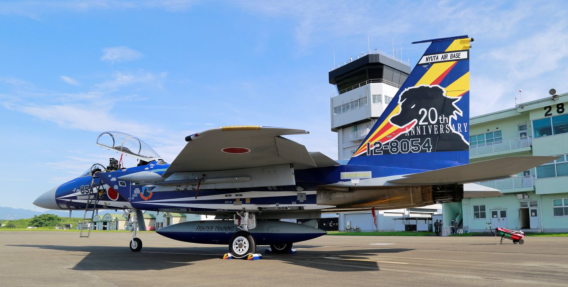 (Photos: JASDF Nyutabaru via Twitter @JASDF_Nyutabaru)
(Photos: JASDF Nyutabaru via Twitter @JASDF_Nyutabaru)
 Unveiled on September 8, 2020, the snazzy blue aircraft graced the cover of the December issue of
Unveiled on September 8, 2020, the snazzy blue aircraft graced the cover of the December issue of
Kōkū Fan magazine, published in October;the F-15DJ’s undersides can be seen here (link).
 The 23rd Fighter Training Squadron anniversary aircraft arrives on a training visit at Komatsu AB.
The 23rd Fighter Training Squadron anniversary aircraft arrives on a training visit at Komatsu AB.
Providing details of the nose area, the photo was actually from a series Komatsu is running on
the women serving among its ranks. The ground crew member had joined the service six
years before, having as a young girl been inspired by the SDF’s disaster relief
efforts in the aftermath of the Chuetsu Earthquake in October 2004.
(Photo [Nov. 2020]: JASDF Komatsu AB via Twitter @JasdfKomatsu)
 (Photo [Nyutabaru, Oct. 2014]: Andy Binks)
(Photo [Nyutabaru, Oct. 2014]: Andy Binks)
 (Photo [Nyutabaru, Feb. 2017]: マロダヨー via Twitter @Marodayooooo)
(Photo [Nyutabaru, Feb. 2017]: マロダヨー via Twitter @Marodayooooo)
|
31st Training Sqn |
Formed |
As Provisional T-4 Sqn: Oct. 1, 1988 (1st Air Wing, Hamamatsu, T-4) As 31st Sqn: Oct. 2, 1989 (1st Air Wing, Hamamatsu, T-4) |
| Current base | Hamamatsu (1st Air Wing, T-4) |
More than a year elapsed from the formation of the Provisional T-4 Squadron, which was primarily charged with the conversion training of former 35th Sqn T-33A instructors, to the start of the first basic training course on the T-4 in November 1989. In the early 90s, these courses reportedly usually comprised five students and lasted seven and a half months.
From April to early December 1997, while construction work was carried out at Hamamatsu ahead of the arrival of the first E-767, the 31st moved to Komatsu to conduct its training.
Having held an event to mark its 20th anniversary on November 14, 2009, the 31st will be marking its 30th anniversary in 2019.
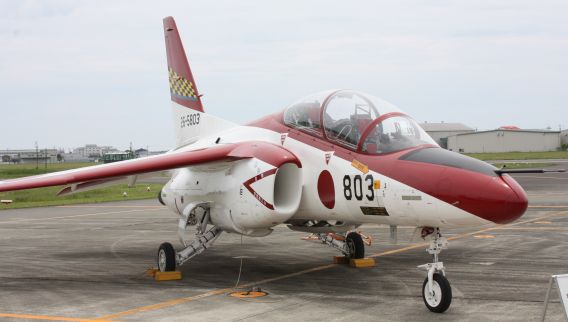 Normally based at Hamamatsu, this 31st Sqn T-4 is seen on a visit to Shizuhama AB in May 2012.
Normally based at Hamamatsu, this 31st Sqn T-4 is seen on a visit to Shizuhama AB in May 2012.
31st Training Sqn Tail Markings
Both of the current Hamamatsu T-4 units retain a slanted version of the horizontal, black and yellow 1st Air Wing checkerboard tail marking that dates back to the F-86F era; the 31st Sqn has blue shadow edging beneath.
To further facilitate identification within the 1st Air Wing, the 31st Sqn has, in principal, operated T-4s with odd-numbered serials.
[A section on 31st Training Squadron Special Markings is combined with that for the 32nd Sqn.]
|
32nd Training Sqn |
Formed | March 31, 1990 (1st Air Wing, Hamamatsu, T-4) |
| Current Base | Hamamatsu (1st Air Wing, T-4) |
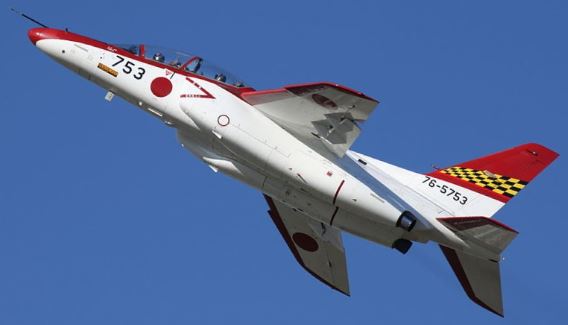 32nd Sqn T-4 on climb out from Hamamatsu
32nd Sqn T-4 on climb out from Hamamatsu
(Photo [Nov. 2010]: Jerry Gunner via Wikimedia Commons)
The second of the two 1st Air Wing T-4 squadrons, the 32nd drew heavily on the then recently disbanded 33rd Sqn (see below) for its initial personnel.
From April to early December 1997, while construction work was carried out at Hamamatsu ahead of the arrival of the first E-767, the 32nd moved to Matsushima to conduct its training.
32nd Training Sqn Tail Markings
Like its sister unit, the 31st Sqn, the 32nd has the slanted black and yellow checkerboard tail marking, but with red shadow edging beneath.
To further facilitate identification within the Wing, the 32nd Sqn has, in principal, operated T-4s with even-numbered serials.
31ST/32ND TRAINING SQUADRON SPECIAL MARKINGS
Now generally an annual event, as at the other JASDF flight training bases, the painting of special markings at Hamamatsu appears to have started with the ‘Blue Dolphin’ displays at the base air festivals in 1993 and 1994.
1994 Hamamatsu Air Festival 06-5633 / 06-5637 / 06-5639 (31st Sqn)
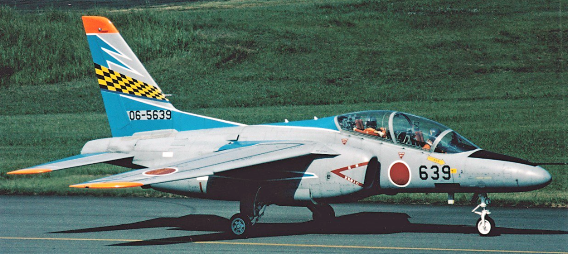 (Photo: BANCHOH via Twitter [link])
(Photo: BANCHOH via Twitter [link])
A design that in part doffed a cap to the Blue Impulse era and set a trend for later years was applied to three aircraft; ’633 was still decked out in the scheme when seen at Iruma later that year (link).
October 1994 JASDF 40th Anniversary 06-5640 (32nd Sqn)
Seen here (link) at the Hamamatsu event that October, this trendsetting early design comprised three main elements: the ‘last three’ of the aircraft’s serial on the nose had the ‘6’ whited out to leave the anniversary number ‘40’; the main JASDF event of the year was written out on the red sharkmouth ferry tanks; and, rather than just a stripe, the 1st Air Wing’s checkerboard design covered the entire tail above the full serial.
1995 Hamamatsu Air Festival 06-5631 (31st) / 06-5632 (32nd)
The cartoon character Astro Boy (known in Japan as Mighty Atom), appeared on the tail of ’631, and his younger sister Uran on the tail of ‘632, which reportedly also had a character called Holstein on its engine intakes.
Although hardly special markings, when the 31st and 32nd were temporarily relocated to Komatsu and Matsushima, respectively, during Hamamatsu runway maintenance in 1997, their aircraft had extra dayglo added to the leading edges of the wings and tail to assist recognition. In July 1997, for unknown reasons a 32nd Sqn aircraft was again seen with an Astro Boy cartoon character badge (link). For the Komatsu air show that year, when the 303rd Sqn marked a decade of F-15J operations, the 31st Sqn provided a specially marked aircraft as the 1st Air Wing representative that featured additional checkerboard markings, what appeared to be a hoop-jumping dolphin and white shadowing on the ‘last three’ on the nose.
1998 Hamamatsu Air Festival 76-5753 (31st Sqn)
In a departure from the norm but for a specific reason, the ‘last three’ of the serial on the nose of this aircraft were painted out and written in kanji七五三. Fortunately, the aircraft serial could provide a link to the annual Shichi-Go-San (Seven-Five-Three) festival, for children of those ages held on the weekend nearest to November 15, which accounts for the two accompanying cartoon character-like children. To further appeal to younger visitors in particular, the ferry tanks featured a Hello Kitty design.
In or around August 1999, a T-4 from each squadron, specially selected as they had consecutive serials ending in ’31 and ’32 ([link] and at Ashiya that December [link]), carried an ‘I Love T-4’ marking (with one red dolphin in the case of the 32nd Sqn [link]). Not connected with an air festival, they were thought to have possibly been the mounts of the respective squadron commanders. A Japanese report states that the 31st Sqn badge featured two blue dolphins.
November 1999 (1) T-4 10th Anniversary 56-5733 (31st)
For the annual home base festival, each squadron marked a separate event, and it fell to the 31st to mark its decade of T-4 operations (link). The following month, the same aircraft was displayed at Ashiya, where T-4 training had just commenced as T-1 operations were winding down. Photos of the right side show the different positioning of the beach ball, which incorporated reference to the 1st Air Wing’s checkerboard marking. Unfortunately, no photos reveal much detail of the fuselage marking, which appears to be a long English inscription against a JASDF eagle marking background.
November 1999 (2) ‘The Millennium Dolphin’ 56-5736 (32nd)
A year younger, the 32nd Sqn painted an aircraft in a kind of splinter pattern to mark the approaching new millennium and, not to be outdone, to look ahead to its own impending decade of operations (link).
November 2002 Hamamatsu Air Base 50th Anniversary 66-5750 (32nd)
 (Above and below) Incorporating Mt. Fuji and leaping dolphins, an elaborate scheme was applied
(Above and below) Incorporating Mt. Fuji and leaping dolphins, an elaborate scheme was applied
to just one aircraft to celebrate 50 years of postwar operations at Hamamatsu.
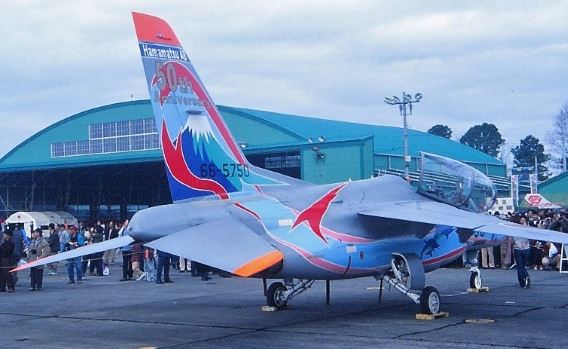
 (Hamamatsu, Nov. 2002)
(Hamamatsu, Nov. 2002)
2004 JASDF 50th Anniversary 66-5747 (31st [link]), 56-5734 (32nd)
As would be expected, each squadron contributed an aircraft to mark this major service milestone, only this time the basic design was the same.
In the case of the blue 31st Sqn aircraft, the nature of the event was plainly visible on both the upper and lower surfaces. The distinctive white dolphin silhouete can be made out in this eye-level photo, taken at a wet Hamamatsu in October 2004 (link).
Likewise the upper and lower surfaces of the red 32nd Sqn aircraft, also as seen parked next to its sister squadron aircraft that October (link). This taxying shot shows off the right side of the aircraft on a somewhat brighter day in July 2004 (link).
October 2006 1st Air Wing 50th Anniversary
86-5767 (31st), 16-5660 (32nd [link])
Displayed at the Hamamatsu air festival that year were two specially decked-out T-4s (link), though the less elaborate markings were confined to the tails and drop tanks. The white tailfin designs, featuring ‘1st Wing 50th Anniversary’ in cursive script on both sides and a black silhouette of an F-86F on the left and a T-33A on the right, were identical save for blue (31st) or red lettering. The script and silhouettes were echoed on the ferry tanks, the silhouettes being the opposite of the type shown on the tail.
September 2007 Grey Schemes 26-5676 (link) and 56-5732 (link, both 32nd)
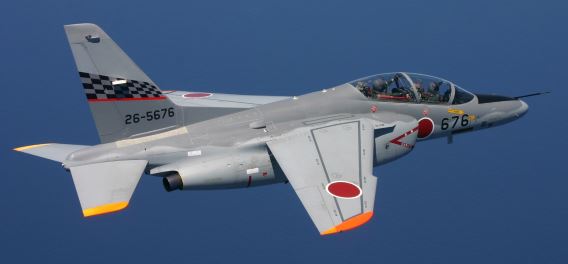 (Above and below) The two 32 Sqn aircraft that appeared in grey schemes in the course of 2007;
(Above and below) The two 32 Sqn aircraft that appeared in grey schemes in the course of 2007;
that above was still sporting this scheme in April 2008. Note that ‘732 had the squadron
number in its serial outlined in white. (Photos: Japan Ministry of Defense/JASDF)
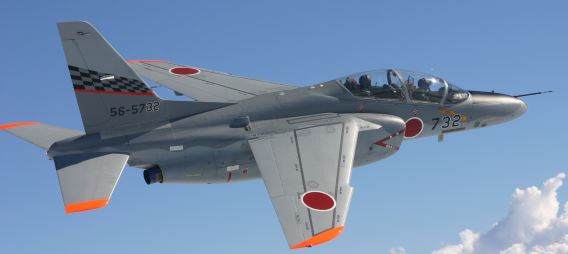
October 2008 Hamamatsu Air Festival 06-5782 (32nd)
 First seen in a grey scheme in around May 2008, this aircraft was present at the
First seen in a grey scheme in around May 2008, this aircraft was present at the
Hamamatsu Air Festival in October that year.
(Photo [Shizuhama, May 2008]: Yoshiaki Yamaguchi via Wikimedia Commons)
2008–2009 Blue Combat Aircraft Scheme
66-5744 (31st), 66-5742 (32nd [link])
An aircraft from each squadron was painted in a blue overwater camouflage scheme of the type applied to F-2 fighters, according to one publication to give them the more threatening appearance of an actual combat aircraft during training exercises. The second of the links provided above shows the aircraft landing at Hamamatsu in June 2008; ’742 is shown here (link) landing at Gifu in March the following year; shots of the upper surfaces of ’744 show that they were designed to deceive.
October 2009 31st Sqn 20th Anniversary 36-5699
For comparison with the link above, this view of the right side (link) shows that the lettering of ‘Anniversary’, below the small ‘20’ badge and above the standard checkerboard tail marking, is the same as on the left side; ‘ambulance-style’ reversing of letters has become something of a habit with other units. The upper surfaces of this scheme featured chevrons reminiscent of the tail markings used by the 501st Sqn in its RF-86F era.
June 2010 31st Sqn ‘100,000 Accident-Free Flight Hours’
16-5655, 16-5797 (link)
In the case of 16-5655, the drop tank marking designed for this safety milestone appeared in reverse on the right tank; note that the T-4 silhouette in the final zero was on the left side only. The aircraft also carried a commemorative badge.
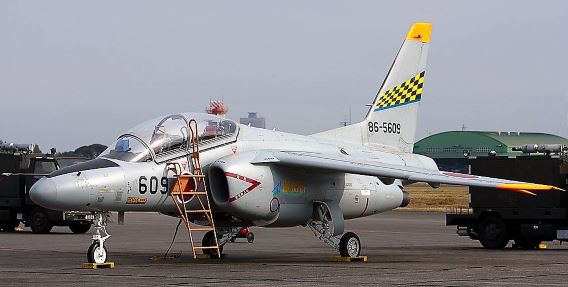 Initially seen on ferry tanks, the ‘100,000 Accident-Free Flight Hours’ logo was applied to the
Initially seen on ferry tanks, the ‘100,000 Accident-Free Flight Hours’ logo was applied to the
fuselage of this aircraft especially for the Hamamatsu air festival held in October 2010.
(Photo: Ken H. via Wikimedia Commons)
2010 32nd Sqn 20th Anniversary 56-5732
For the 32nd’s turn to celebrate two decades of operations, an aircraft was painted in a distinctive pink and rust brown eagle design; the aircraft is seen here (link) landing at Gifu in March 2010.
October 2011 Hamamatsu Air Festival Ferry Tank Art 66-5748 (32nd [link])
For the first time, PR use was made of a static display aircraft with its ferry tanks adorned with designs created by local children (link). This has become something of a feature of festivals over the intervening years and now usually involves an aircraft from each squadron.
August 2012 Hamamatsu Air Festival ‘111,111 Accident-Free Flight Hours’
46-5711 (31st)
Use was again made of an aircraft with an appropriate serial number, or as close as was possible in this case. As seen in the above link, this special marking comprised just three elements: on the fuselage, a small plan-view silhouette of a T-4 and an ‘111,111hours’ inscription, the latter being repeated on a blue stripe at the top of the fin. Note that the fourth ‘1’ in the fuselage inscription is a head-on (?) silhouette of a T-4 turned on its side. The inscriptions were reversed on the right side (link).
November 2012 Hamamatsu Air Festival Ferry Tank Art
86-5763 (31st)
An otherwise standard 31st Sqn T-4 was on static display with its ferry tanks adorned with artworks contributed by children from じょうほくようちえん (Jouhoku Yochien, Jouhoku Kindergarten) in Hamamatsu. Grown-ups had applied AIR FESTA HAMAMATSU 2012 in blue to the fuselage.
October 2013 Hamamatsu Air Festival ‘Mount Fuji’
06-5649 (link), 46-5711 (link) and 96-5778 (31st); 56-5741 and 66-5742 (32nd)
No less than five aircraft received major makeovers, but ’741 (link) and ’778 (link) flew at least once with the right sides showing only green Shizuoka countryside, not the full Mount Fuji scene. (As can be seen here [link], ’741 was completed in time for the air festival). Also, a slight difference was noticed in the main artwork applied to two fully completed aircraft (link).
2013 Hamamatsu Air Festival Hamamatsu Tourism Promotion/Ferry Tank Art
16-5655 (31st), 56-5732 (32nd)
As the inscription on the tanks showed, these designs were from children attendingアソか学園じょうほくようちえん (Asoka Gakuen Jouhoku Youchien), the Jouhoku Kindergarten in Hamamatsu operated by the Asoka Gakuen Educational Association.
Both aircraft had tail markings that promoted Hamamatsu tourism. Standing next to an inscription 出世大名 (shusse daimyō, or successful Japanese feudal lord), 家康くん (Ieyasu-kun) was a mascot that took its name from the shogun Ieyasu Tokugawa (1543–1616) to mark the centenary of the city’s foundation. Tokugawa spent around 15 years from age 29 in Hamamatsu before going on to found the shogunate that bears his name and become one of the three unifiers of Japan. Other motifs incorporated into the mascot included a hairpiece of eels from Lake Hamana, a local delicacy, and clothing that incorporated a family crest of a sliced mikan (tangerine) and a hakama (traditional man’s skirt) featuring a keyboard design; the fruit are locally grown and musical instrument manufacturers Kawai and Yamaha are headquartered in Hamamatsu. Under his left shoe was the warning that Ieyasu-kun was ‘Copyright Hamamatsu City’ (浜松市).
2014 JASDF 60th Anniversary 96-5778 (31st), 86-5612 (32nd)
 (Hamamatsu Air Festival, Sept. 28, 2014)
(Hamamatsu Air Festival, Sept. 28, 2014)
 (Above and below) The two 60th anniversary aircraft photographed at their Hamamatsu home but
(Above and below) The two 60th anniversary aircraft photographed at their Hamamatsu home but
far from the madding crowd that gathered on the air festival day in September 2014.
(Photos: [above, Oct. 22] Andy Binks; [below, Oct. 14] Tom Meikle)

 (Hamamatsu Air Festival, Sept. 28, 2014)
(Hamamatsu Air Festival, Sept. 28, 2014)
September 2014 Hamamatsu Air Festival Ferry Tank Art
26-5676 (32nd), 36-5700 (31st)

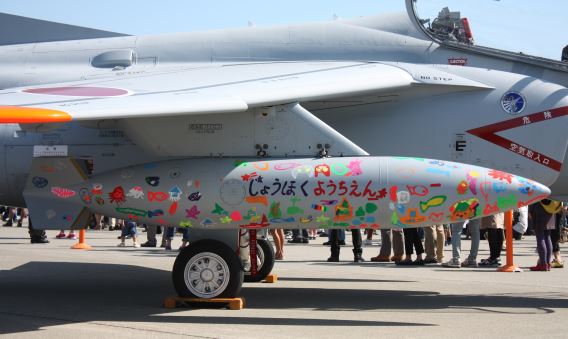
The outside halves of the ferry tanks of two aircraft were again decorated by children from じょうほくようちえん (Jouhoku Yochien, Jouhoku Kindergarten) in Hamamatsu.

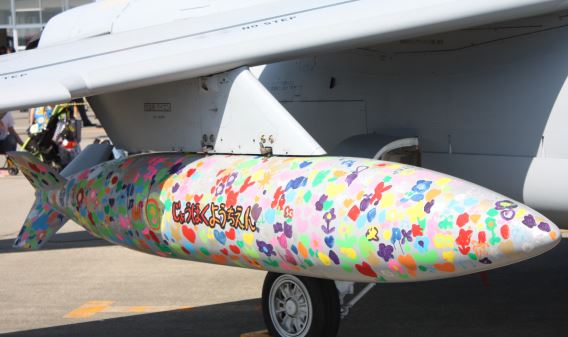
2015 1st Air Wing 60th Anniversary ‘Blue/Red Dolphin’ 96-5778 (31st)
The same aircraft as 2014 was used for a scheme that was divided in two, the left (blue) side of the fuselage for the 31st, the right (red) side for the 32nd Sqn. The respective fuselage flashes incorporated the announcement: ‘1WING 60TH ANNIVERSARY’.
Retaining the 31st’s standard blue checkerboard edging on both sides, the tail again featured Ieyasu-kun (see 2013), the mascot’s image being repeated in smaller form inside the red air intake danger triangles.
November 2015 Hamamatsu Air Festival Ferry Tank Art
46-5713 (32nd), 66-5747 (31st)
Ahead of the air show, local children had once again been allowed to show their artistic side on T-4 ferry tanks. As mentioned on the tanks, this year the children were from しとろようちえん (Shitoro Yochien or Shitoro Kindergarten, in the Shitoro area of Hamamatsu).
October 2016 Hamamatsu Air Festival ‘Lake Hamana Eel/Hamamatsu Music’
76-5752 (32nd [link] [link, landing at Nagoya])
The special markings on this grey-painted aircraft repeated two elements included in the 2013 Hamamatsu Tourism Promotion design. This time, the whole aircraft was painted to resemble a Lake Hamana eel (link), with eyes on the aircraft’s nose (link) and the curves of an eel’s body along its fuselage, although these have been made to look like a line of music to provide a connection with the piano keyboard design on the rudder; as in 2013, a reference to the Hamamatsu-based musical instrument manufacturers, Kawai and Yamaha. For the black-and-white badges on either side of the tailfin, a cartoon eel formed the ‘6’ of the year ‘2016’. This photo captured the design on the upper surfaces of the wings (link); the undersides were unmarked (link).
October 2016 Hamamatsu Air Festival Ferry Tank Art
96-5613 (31st), 96-5780 (32nd [link])
Children from the Shitoro Kindergarten had once again been let loose on some ferry tanks prior to the event.
October 2017 Hamamatsu Air Festival Ferry Tank Art
66-5744 (31st [link] [link]), 66-5751 (32nd [link])
At this rainy event, these two hangared aircraft modeled designs again created by children from the Shitoro Kindergarten; a photo of ’751’s right tank appeared in the February 2018 issue of Kōkū Fan.
November 2018 Hamamatsu Air Festival ‘Rugby World Cup Japan 2019’
06-5641 (32nd [link])
Unlike in 2017 blessed with good weather, this event attracted some 130,000 visitors. Most of them will have noticed this ‘Red Dolphin’-scheme aircraft, which was given pride of place. The aircraft had an official Rugby World Cup (RWC) poster—modified to promote the city of Shizuoka’s involvement as a host city—added on either side immediately aft of the air intake warning triangle. Although a promotional RWC inscription was also included on the left side of the nose (link), the right side carried an image of a hinomaru over Mt. Fuji.
Both sides of the tail featured the official RWC mascots ‘Ren-G’ playing rugby; in a lineout on the left side (link) and tackling in open play on the right (link). They might, implausibly, look a bit like seal pups with hats but are in fact shishi (lions, but also the name given to the guardian dog on the left-side of Shinto shrines).
The aircraft’s ferry tanks (link) were also given some fetching red stripes (possibly in imitation of a rugby ball), cherry blossoms (Japan’s national rugby team being known as the Brave Blossoms) and ornate wording.
For the 2019 Hamamatsu Air Festival, J-HangarSpace’s money is on a design promoting the Tokyo Olympics and Paralympics 2020 cycling events being held in Shizuoka Prefecture. The 31st Sqn will no doubt also be marking its 30th anniversary.
November 2018 Hamamatsu Air Festival Ferry Tank Art
36-5700 (31st), 06-5628 (32nd)
In a hangar were two aircraft with artwork-bedaubed ferry tanks, this time courtesy pupils attending はぎおかようちえん (Hagioka Kindergarten) in Hamamatsu. The show report in the February 2019 issue of Kōkū Fan included a small photo of ’700, and views of both aircraft can be found by scrolling down 30 or so photos on this Japanese website report (link).
April 2019 JASDF Air Park 20th Anniversary
06-5641 (32nd, still in Rugby World Cup 2019 markings, see above), 26-5803 (31st, below)
 (Photo via Twitter @Aimasho2103)
(Photo via Twitter @Aimasho2103)
One of the two based T-4s that were present for this event, the third aircraft built was towed across wearing markings specially designed for the occasion. Local Shizuoka-based plastic model maker Hasegawa chose this aircraft as the subject of one of its kits.
October 2019 Hamamatsu Air Festival /
31st Sqn and 32nd Sqn 30th Anniversaries
06-5641 (still in Rugby World Cup Japan 2019 markings, see above); plus
91-5775 (31st) and 16-5664 (32nd) 30TH ANNIVERSARY
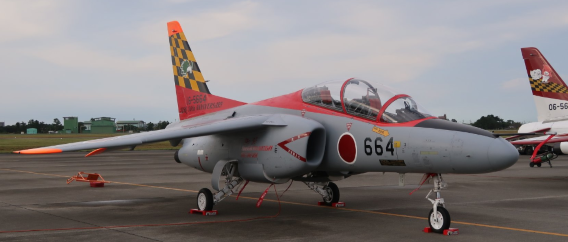 16-5664 (’32SQ 30th ANNIVERSARY’); 91-5775 (31st Sqn ’30th ANNIVERSARY’)
16-5664 (’32SQ 30th ANNIVERSARY’); 91-5775 (31st Sqn ’30th ANNIVERSARY’)
(Photos: はじめ via Twitter @kaj_mas)
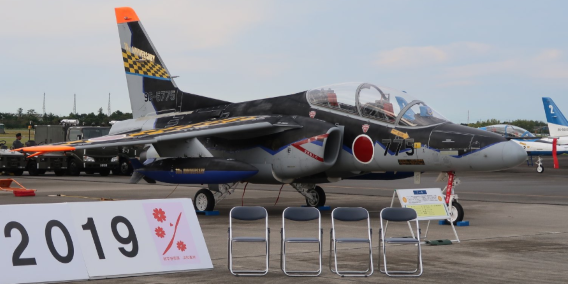
Both having been formed in fiscal year 1989, each squadron again supplied an aircraft to mark the special occasion. In the case of ’664, the slogan 30 32 Team BLINK 30th ANNIVERSARY SINCE 1990-2020 was added aft of the engine intake danger triangle on both sides—‘Blink’ being the 32nd’s radio call-sign—and 32SQ 30th ANNIVERSARY to the tail. Having been grounded with the rest of the fleet while a potential engine problem was rectified, ’664 had been returned to service still wearing this scheme by March 2020. Having been formed in the previous calendar year, the 31st’s representative ’775 sported SINCE 1989-2019.
 (Above and below) Two more photos of the aircraft painted to mark the 30th anniversary of the
(Above and below) Two more photos of the aircraft painted to mark the 30th anniversary of the
1st Air Wing’s 32nd Sqn show the slogan and, discretely added to an undercarriage door, the
names of paint team. (Photos via Twitter: [above, Hamamatsu, Mar. 2, 2020] @Kuma11blue
and [below, Oct. 20, 2019] Tomoya @syouwa2pc)

 (Photo [Hamamatsu, Oct. 2014]: Andy Binks)
(Photo [Hamamatsu, Oct. 2014]: Andy Binks)
 (Hamamatsu Air Festival, Sept. 2014)
(Hamamatsu Air Festival, Sept. 2014)
|
33rd Sqn |
Formed | Oct. 26, 1964 (Tsuiki, T-33A) |
| Disbanded | Oct. 2, 1989 (1st Air Wing, Hamamatsu, T-33A) |
Operating aircraft previously flown by the 16th FTW, which had disbanded upon the day of its formation, the 33rd was moved to 1st Air Wing command at Hamamatsu-North three months after its formation, on January 30, 1965.
 33rd Sqn T-33As had red, blue or yellow fin tips for maintenance team identification purposes.
33rd Sqn T-33As had red, blue or yellow fin tips for maintenance team identification purposes.
(Photo [Hamamatsu, Dec. 1975]: Akira Watanabe)
33rd Sqn Tail Markings
(1965–79) After the move to Hamamatsu-North, 33rd Sqn aircraft received the 1st Air Wing’s broad, horizontal, yellow and black checkerboard stripe.
 A T-33A on the Hamamatsu apron in August 1980 bears the 33rd Sqn’s later tail marking,
A T-33A on the Hamamatsu apron in August 1980 bears the 33rd Sqn’s later tail marking,
as described below. (Photo: Akira Watanabe)
(1979–90) A red stylized ‘33’ was added to the checkerboard stripe as a way to distinguish 33rd Sqn aircraft after the 35th Sqn’s arrival at Hamamatsu in the spring of 1979.
|
35th Sqn |
Formed | Aug. 23, 1973 (4th Air Wing, Matsushima, T-33A) |
| Disbanded | March 31, 1991 (1st Air Wing, Hamamatsu, T-33A) |
The 35th completed a move from Matsushima, where it had come under 4th Air Wing command, to the 1st Air Wing at Hamamatsu-Kita on April 1, 1979.
 (Photo [Ashiya, Oct. 1979]: Takao Kadokami)
(Photo [Ashiya, Oct. 1979]: Takao Kadokami)
The unit assumed responsibility for the Sengi Kenkyūhan (Combat Research Group, until December 1995 the official name for the Blue Impulse team*) operations following the disbandment of the Sabre-equipped 1st Sqn in March 1979.
* Disbanded as part of the 35th Sqn in December 1981, this component’s responsibilities were passed to the 21st Fighter Training Sqn (see above) the following month.
35th Sqn Tail Markings
(1973–77) A red solid ‘4’, signifying the 4th Air Wing.
 (Photo [Matsushima, Aug. 1977]: Akira Watanabe)
(Photo [Matsushima, Aug. 1977]: Akira Watanabe)
(1977–79) As previously mentioned, the base name Matsushima means ‘pine island’, and the area is known for its pine forests. In 1977, the 35th adopted the design first devised by the 21st Sqn, of a pair of green pine needles bent into the form of a four, but changed the enclosed area colour from white to red.
(1979–91) Following its change of base from Matsushima to Hamamatsu, the 35th modified the 1st Air Wing’s yellow and black checkerboard stripe and mimicked the 33rd Sqn’s design by the addition of a blue stylized ‘35’.
|
41st Flight Training Sqn |
Formed |
As Provisional 41st Flight Training Sqn: As 41st Flight Training Sqn: |
| Current Base | Hamamatsu (1st Air Wing, T-400) |
 (Photo: JASDF)
(Photo: JASDF)
The first of 13 T-400s having been delivered on February 16, 1994, the 41st worked up as a provisional squadron with six aircraft before being granted full squadron status on June 1, 1995. At that time, student pilots on the transport stream would have completed the earlier phases on the T-3 and T-1 before embarking on the 10-month T-400 course involving around 150 flying hours. This photo (link) shows seven aircraft lined up on the apron at Miho 10 years later, in May 2005; this (link) flight-line activity in May 2009.
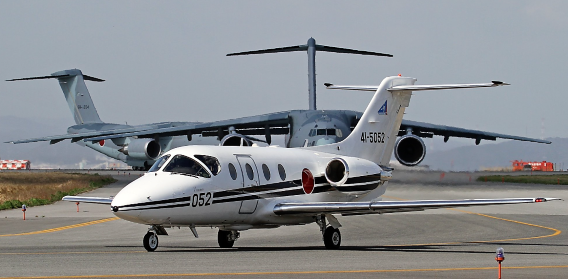 (Photo: JASDF Miho AB)
(Photo: JASDF Miho AB)
There were plans to bring the 41st under Air Training Command control and relocate the unit to the 11th FTW’s Shizuhama base in 2020, thereby enabling transport stream students to continue onto the next, now year-long phase of training from the same base. The 41st carried out some feasibility flights from Shizuhama in early December 2017. Then, in March 2018, the Ministry of Defense published a report on an alternative plan to move the squadron to Hamamatsu instead, a plan that would even involve reducing the TV licence fee for local residence to counter any protests about the increase in noise from an already very active base. The relocation was completed in October 2021.
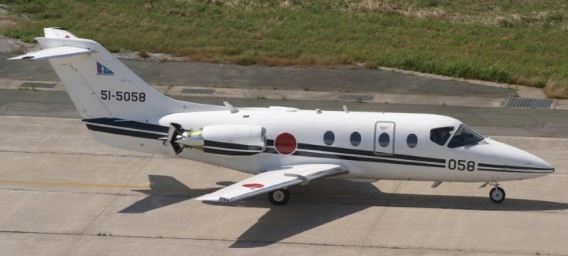 (Photo: JASDF Miho AB)
(Photo: JASDF Miho AB)
41st Flight Training Sqn Tail Marking

The fin marking consists of a stylised `41` against the silhouette of a bird’s head. The JASDF Air Support Command website (below) included an image of the green squadron emblem (below), which features a bird silhouette and the word Lanner (as in lanner falcon), the unit’s radio call-sign.
 (Image: JASDF Air Support Command)
(Image: JASDF Air Support Command)
 (Photo: JASDF Hamamatsu AB via Twitter @JASDFhamamatsu)
(Photo: JASDF Hamamatsu AB via Twitter @JASDFhamamatsu)
Following the 41st’s move to Hamamatsu, the tail marking was not surprisingly changed to the 1st Air Wing’s familiar checkerboard, with green lower edging. In the above photo, its reflection can be seen in the leading edge of the tailplane.
41st FLIGHT TRAINING SQUADRON SPECIAL MARKINGS
2004 JASDF 50th Anniversary 51-5057 (departing Iruma, Nov. 3, 2004 [link])
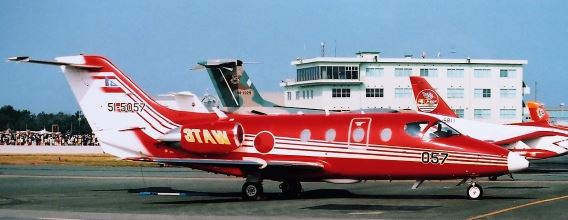 (Photo [Ashiya, Oct. 2004]: Takao Kadokami)
(Photo [Ashiya, Oct. 2004]: Takao Kadokami)
In a major departure from the unit’s bland standard scheme (link), a predominantly red-painted aircraft flew the flag for the 401st in the JASDF’s golden jubilee year. There were no differences between the right and left sides (link).
According to the Miho base website, the red scheme was chosen to mirror that of the official JASDF anniversary logo and represent the student pilots’ enthusiasm and passion for flying. Sweeping up the tail, the four white fuselage stripes, which also featured in the YS-11 (see 3rd Tactical Airlift Group) and C-1 schemes, were again taken from the official anniversary design as a way to utilize the whole aircraft as a kind of flying logo. Seen as the wake of a ship, the stripes also symbolized the continuity of personnel who had served or gone on to enjoy great success after having undergone training at Miho over the years.
2008 Miho Air Base 50th Anniversary 41-5063
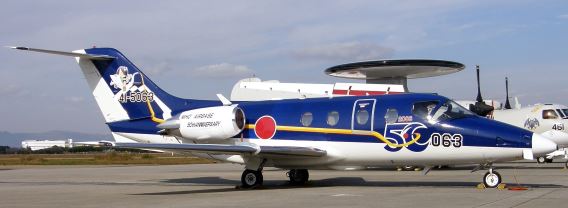 (Photo [Tsuiki, Nov. 2008]: Takao Kadokami)
(Photo [Tsuiki, Nov. 2008]: Takao Kadokami)
To mark the 50th anniversary of Miho air base, the last of the 13 T-400s delivered was one of three 3rd Tactical Airlift Group aircraft that were repainted and had a sticker from GeGeGe no Kitarō (literally meaning Spooky Kitarō), a popular spirit monster manga and anime series, attached to each side of their tails (link). The manga’s artist/writer, Shigeru Mizuki (1922–2015), was raised in nearby Sakaiminato, Tottori Prefecture, where a street is lined with bronze statues of his creations and a museum dedicated to his life and work.
With the cooperation of Mizuki Productions, designs from the series were also emblazoned on rolling stock of the local JR Sakai Line railway and on a ferry. The addition of JASDF aircraft meant that land, sea and air media were used in a concerted campaign to promote local tourism.
In a blue colour to represent the Sea of Japan and the sky, the design also included the number ‘50’—its open, crescent-shaped ‘0’ symbolizing the Yumigahama Peninsula, where Miho is located—on the nose and the outline of a mountain on either side of the tail. A series of photos on the Miho base website (link) show snapshots of the T-400 painting process.
 (Photo: JASDF Miho AB)
(Photo: JASDF Miho AB)
Although Mizuki himself was not present, the head of a Mizuki Productions office and the mayor of Sakaiminato were among the 20 visiting dignitaries and 80 base personnel who gathered for the ceremony, held on April 14, 2008 (above), during which the tail stickers were applied. Naturally featuring in the base anniversary ceremony held on May 20, 2008, the aircraft retained the scheme until the end of December that year.
 (Photo [Tsuiki, Nov. 2008]: Takao Kadokami)
(Photo [Tsuiki, Nov. 2008]: Takao Kadokami)
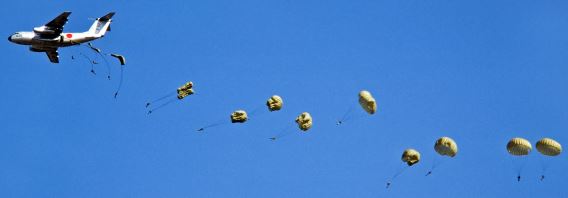 A stick of paratroopers jumps from a passing 402nd Sqn C-1 at the Iruma air show in November
A stick of paratroopers jumps from a passing 402nd Sqn C-1 at the Iruma air show in November
1978, in the early days of the type’s service career. The all-metal finish aircraft carries the
unit’s then newly adopted eagle tail marking (see squadron entry below).
(Photo: Akira Watanabe)
|
401st Airlift Sqn |
Formed | Oct. 1, 1958 (Air Transport Wing, Miho, C-46) |
| Current Base | Komaki (1st TAG, C-130H/KC-130H) |
Japanese sources differ widely with regard to some of the dates of events in the 401st’s early history, prior to its March 31, 1978, reorganization at the start of the Tactical Airlift Group (TAG) era, which has continued for the 40 years up to the present day.
 Although at that time C-46s were devoid of squadron markings, this example at Fukuoka airport in
Although at that time C-46s were devoid of squadron markings, this example at Fukuoka airport in
September 1965 was most likely assigned to the 401st Sqn. The aircraft just has the Japanese for
Air Transport Squadron, Air Transport Wing above the fuselage windows.
(Photo: Takao Kadokami)
All Japanese sources agree that the 401st and 402nd squadrons have their origins in the Tachikawa Air Transport Group of 1955 and the Miho Detachment of 1955–1958 (see later on this page), respectively, when both bases were still under U.S. military control. The first six of 36 C-46s furnished by the United States having arrived in January 1955, the Miho Detachment provided the basis for the Air Transport Wing, which commanded both squadrons after their formation in October 1958—two sources even state that this key event occurred in June 1955, others give this as the date of the relocation to Miho—at which time the 401st remained at Miho. The sources also agree that the two squadrons were reorganized under the 1st and 2nd TAGs, respectively, on March 31, 1978.
 Iruma, August 1976. A 401st Sqn YS-11C lands at what was to become its home base after
Iruma, August 1976. A 401st Sqn YS-11C lands at what was to become its home base after
conversion to YS-11E (later –EA) standard for the Electronic Warfare Squadron in 1979.
(Photo: Akira Watanabe)
Depending on the source, the 401st received its first YS-11 sometime between March 1964 and December 1969, as a lead-in to a C-46 replacement, and ceased to operate the C-46 either early in 1977 or in 1978. The first C-1 possibly arrived in March 1973, but it was reportedly April 1975 before regular “milk run” JASDF base supply operations were commenced. March 31, 1978, is generally accepted as the date the move to Komaki was completed. Amendments to the text will be made as more verifiable, less confusing information comes to light.
 Originally delivered to the 402nd Sqn in December 1974, the first production (third-built) C-1 was
Originally delivered to the 402nd Sqn in December 1974, the first production (third-built) C-1 was
passed to the 401st, sporting its tail marking on the then standard natural metal finish. Having
ended its service career with the 403rd Sqn, this aircraft is parked in a corner of Miho
air base (link and see 3rd TAG). (Photo [Misawa, Oct. 1978]: Akira Watanabe)
An indisputable fact is that tragedy struck five years into the unit’s time at Komaki. Fourteen servicemen being killed in the line of duty when two C-1s crashed during low-altitude formation training in low visibility conditions in the Sugashima area of Toba, Mie Prefecture, on April 19, 1983.
Thankfully, there is more agreement in the case of the C-130H, for which a preparatory office was set up in August 1982 and a unit for deployment to the United States for training formed in December that year.
Ferried by JASDF crews, the first two C-130Hs arrived at Komaki from the United States on March 14, 1984, at which time two YS-11s were received from the 402nd Sqn. The two C-130Hs being flown from Komaki by the then Air Proving Wing, it was September before the 401st received its first examples of the type and October when reformed on the type and operations were officially commenced. Deliveries of its full complement of 12 aircraft plus three reserves were completed during the course of fiscal 1989, when the 401st’s time as a composite squadron ended with the gradual passing on of its C-1s and YS-11s.
 While a sister aircraft undergoes maintenance, a C-130H Hercules of the 401st Sqn,
While a sister aircraft undergoes maintenance, a C-130H Hercules of the 401st Sqn,
1st Tactical Airlift Group (TAG) comes to the end of its landing run at Komaki AB in October 2000.
For the time being, the remainder of the 401st’s history comes in the form of a chronology, which highlights the unit’s contributions to disaster relief and peacekeeping efforts overseas.
401st Airlift Sqn Chronology (1984–)
| 1984 | Sept. 26 | Arrival of first C-130H |
| 1989 | May 11 | Regular services commenced by C-130H, as transfer out of C-1s and YS-11s completed during course of year |
| May 28 | First JASDF unit sent to United States to participate in USAF Airlift Rodeo (from 1992 biennial Air Mobility Rodeo) tactical airlift meet (takes part total of six times through the 90s) |
|
| 1992 | Sept. 23 | (to Sept. 10, 1993) Engaged in peacekeeping operations (PKO) in Cambodia |
| 1993 | Dec. 29 | (to Jan. 7, 1994) Engaged in PKO in Mozambique |
| 1994 | Sept. 17 | (to Dec. 28) Provided airlift support for refugees in Rwanda |
| 1995 | May 16 | Started airlift support operations in Golan Heights |
| 1998 | Nov. 13 | (to Dec. 9) Engaged in airlift operations for Japan Disaster Relief Team in aftermath of Hurricane Mitch |
| 1999 | Feb. 2 | (to Feb. 10) Conducted overseas flight training |
| Nov. 24 | (to Feb. 9) Airlift operations in support of international peace cooperation work for displaced person relief efforts in East Timor |
|
| 2001 | Feb. 5 | (to Feb. 11) Airlift operations in support of Japan’s contribution to international relief efforts after earthquake in India |
| Oct. 6 | (to Oct. 11) Afghan refugee relief by international peace cooperation work |
|
| Nov. 29 | Start of operations under Anti-Terrorism Special Measures Law passed following attacks on New York |
|
| 2002 | Mar. 2 | Engages in PKO in East Timor |
| 2003 | July 7 | (to Aug. 10) Airlift operations as part of international peace cooperation efforts for Iraqi refugee relief |
| Dec. 24 | Iraq reconstruction support dispatch unit forms at Komaki | |
| Dec. 30 | (to Jan. 6, 2004) Airlift operations as part of Japan’s contribution in support of international relief efforts in aftermath of earthquake in Bam, Iran |
|
| 2004 | Mar. 3 | Commences airlift missions in support of SDF teams despatched to assist reconstruction efforts in Iraq |
 For operations in Iraq, the 401st’s aircraft initially had their tails painted white. Later, an overall
For operations in Iraq, the 401st’s aircraft initially had their tails painted white. Later, an overall
pale blue scheme was adopted. (Photo [Nyutabaru, Oct. 2003]: Takao Kadokami)
| 2005 | Jan. 10 | (to Mar. 18) Involved in international disaster relief efforts in Indonesia following Sumatra earthquake |
| Oct. 3 | (to Dec. 3) Participates in international relief efforts in aftermath of earthquake in Pakistan |
|
| 2006 | June 1 | (to June 22) Involved in international disaster relief efforts in Indonesia following Java earthquake |
| 2007 | May 3 | Completes 500th airlift mission in support of SDF teams despatched to assist reconstruction efforts in Iraq |
| 2008 | Nov. 7 | Completes 800th airlift mission in support of SDF teams despatched to assist reconstruction efforts in Iraq |
| Dec. 12 | Airlift missions in support of SDF teams despatched to assist reconstruction efforts in Iraq ended |
|
| 2009 | May 18 | Airlifts JMSDF personnel and equipment to Djibouti as part of efforts to counter piracy off coast of Somalia |
| 2010 | Jan. 17 | (to Feb. 18) Involved in international disaster relief efforts following earthquake in Haiti |
| Feb. 5 | Airlift support of team despatched to Haiti on PKO starts | |
| Feb. 25 | Receives first Hercules reconfigured to KC-130H standard | |
| Aug. 22 | (to Sept. 7) Involved in international disaster relief efforts following severe flooding in Pakistan |
 The JASDF ‘s first KC-130H conversion (nearest camera) was delivered on February 25, 2010.
The JASDF ‘s first KC-130H conversion (nearest camera) was delivered on February 25, 2010.
(Photo: JASDF)
| 2012 | Jan. 26 | South Sudan PKO support flight operations start |
| Dec. 23 | (to Dec. 27) Conducts missions in support of withdrawal from Haiti |
|
| 2013 | Jan. 9 | (to Jan. 19) Airlift support missions in Golan Heights concluded |
| Jan. 30 | Participates in Cope North Guam 2013 exercise | |
| Nov. 12 | (to Dec. 20) Provides airlift support for Japanese contribution to international relief efforts after typhoon strikes the Philippines |
|
| 2014 | Mar. 11 | (to Apr. 28) Involved in international efforts to find missing Malaysian Airlines flight MH370 |
| Sept. 29 | (to Oct. 3) Conducts training exercises, including simulated evacuation of Japanese nationals overseas |
|
| 2015 | Apr. 28 | (to May 19) Participates in international relief efforts in aftermath of earthquake in Nepal |
| Dec. 17 | (to Dec. 18) Conducts training exercises, including simulated evacuation of Japanese nationals overseas |
|
| 2016 | July 11 | (to July 26) Three aircraft sent to Djibouti for transportation missions, including evacuation of Japanese nationals, due to worsening security situation in Juba, South Sudan |
| Dec. 2 | (to Dec. 10) Participates in Japan-U.S.-Australia humanitarian assistance and disaster relief joint training exercise in Federated States of Micronesia |
|
| Dec. 12 | (to Dec. 16) Conducts training exercises, including simulated evacuation of Japanese nationals overseas |
|
| 2017 | Nov. 3 | (to Nov. 22) One aircraft and personnel sent to train with USAF units at bases in Missouri and Arizona |
| 2018 | Oct. 7 | (to Oct. 27) Disaster relief in Indonesia (see photo below) |
| 2019 | Oct. 15 | (to Oct. 25) Participates in Exercise Shinyuu Maitri 2019 in in India (see photo below) |
| 2020 | Jan. 15 | (to Feb. 10) Supported international firefighting operations in Australia |
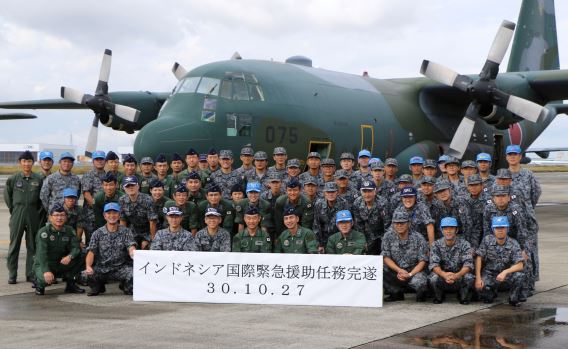 On October 27, 2018, 401st Sqn personnel pose for the camera having returned to base at the end
On October 27, 2018, 401st Sqn personnel pose for the camera having returned to base at the end
of a disaster relief mission to Indonesia. International relief efforts had been initiated in the
aftermath of an earthquake and tsunami that struck the island of Sulawesi on September 28.
Carrying around 50 personnel, a single C-130H had been sent on October 7 to assist in
relief operations, during the course of which 200 tons of supplies were airlifted from
Balikpapan to badly affected Palu and around 400 displaced persons
evacuated on the return flights. (Photo: JASDF Komaki AB)
 (Photo: JASDF Public Affairs Office)
(Photo: JASDF Public Affairs Office)
In October 2019, a 401st Sqn C-130H participated in joint training with Indian Air Force elements in Exercise Shinyuu Maitri (Hindi for ‘true friends’) 2019 (as pictured above). While based at Arjan Singh AF Station in the state of West Bengal, JASDF crews undertook joint mobility training and confirmed interoperability with Indian Air Force C-130Js, including takeoffs and landings at unprepared strips. Although the second such exercise, the 401st was making its debut, that held in December 2018 at Agra AF Station having focused on aspects of Indian AF An-32 and C-17 humanitarian and disaster relief operations alongside a JASDF C-2.
 Sent to Australia as part of the international efforts to quell unprecedented forest fires, one of the
Sent to Australia as part of the international efforts to quell unprecedented forest fires, one of the
pair of 401st Sqn C-130H Hercules undergoes maintenance at RAAF Base Richmond, near
Sydney. At the time, crews were flying in support of firefighting operations in the Namadji
National Park area of the Australian Capital Territory. Having departed on January 15,
the 70-strong contingent arrived back at Komaki on February 10, 2020.
(Photo: JASDF Public Affairs Office)
401st Airlift Sqn Tail Markings
From 1972–78, the disc-shaped marking on 401st Sqn YS-11s featured a blue cherry blossom, which appeared in red on Air Transport Training Squadron YS-11s from 1975–78.
Following the switch to the Tactical Air Group system in 1978, a 401st member suggested a new marking in August that year. A red dolphinlike shachihoko, with a blue “1” in the background, denoting the 1st TAG, was worn on its C-1 and YS-11 aircraft. This mythical creature still forms part of the 1st TAG badge (below).
 (Japan Ministry of Defense/JASDF)
(Japan Ministry of Defense/JASDF)
Although from a distance looking more like a flea, the latest marking (introduced in 2009) is of the winged horse, Pegasus (below and link).
 (Komaki, February 2014)
(Komaki, February 2014)
 The 401st unveiled its new lion’s head unit marking at the Komaki Open Base event in March 2024.
The 401st unveiled its new lion’s head unit marking at the Komaki Open Base event in March 2024.
(Photo: aya01@長野県特地派遣隊 via X @aya01flt)
401st Airlift Sqn Special Markings
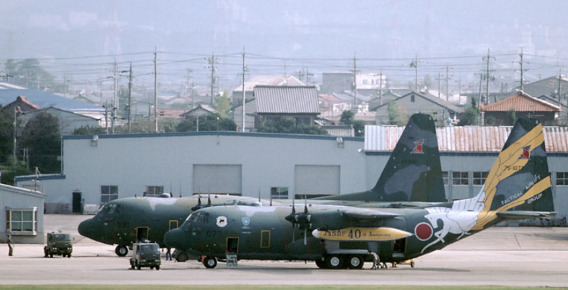 (Photo [Komaki, Nov. 1994]: Rob Schleiffert)
(Photo [Komaki, Nov. 1994]: Rob Schleiffert)
In 1994, a 401st Sqn C-130H received special treatment for the JASDF’s 40th anniversary (link). A predominant Pegasus tail design was supplemented by two shield markings on the port forward fuselage (link). These marked (left) the unit’s participation at an Air Mobility Rodeo at McChord AFB, Washington, and in United Nations PKO efforts in the three countries listed underneath: Cambodia, Mozambique and Rwanda.
The 401st C-130H in the static display at the 2009 Iruma air show carried a two-part badge (above) in the form of the number 50 on its forward fuselage. The Japanese on the left side translates as “With a wish for peace in the deep blue sky”, that on the top right commemorates the 50th anniversary of the opening of the operations building at Komaki AB above “Half a Century of Progress”, encircling a white shachihoko.
|
402nd Airlift Sqn |
Formed | Oct. 1, 1958 (Air Transport Wing, Kisarazu, C-46) |
| Current Base | Iruma (C-1/C-2/U-4) |
 A pair of Kawasaki C-1 transports from the 402nd Sqn, 2nd Tactical Airlift Group based at
A pair of Kawasaki C-1 transports from the 402nd Sqn, 2nd Tactical Airlift Group based at
Iruma, Saitama Prefecture.
Unlike the 401st Sqn, Japanese sources are in general agreement with regard to the major milestones in the 402nd’s history, such as having its origins in the Miho Detachment of 1955–1958 (see later on this page), when that base was still under U.S. military control. The Miho Detachment provided the basis for the Air Transport Wing (q.v.), which was itself formed to command both squadrons upon their formation on October 1, 1958, but the 402nd moved its already ageing C-46s to commence initial operations under the Kisarazu Training Squadron on October 17. Reporting to the Air Training Wing, the Kisarazu Training Squadron changed its name to the Kisarazu Detachment two months later, and it was not until the advent of the 402nd-commanding Kisarazu Squadron (q.v.) in June 1959 that C-46 operations began in earnest..
Receiving its first YS-11 for maintenance crew training in March 1965, about a year after the 401st Sqn, regular “milk run” JASDF base supply operations were commenced the following August. Preparations having been made in 1967, a move from Kisarazu to the former F-86F base at Iruma was undertaken March 5–31, 1968, so the 402nd’s association with its current base, which officially commenced on June 1, 1968, has passed the half century mark. The move prompted a change of command unit name to the Iruma Squadron. (Japanese Wikipedia would appear to be wide of the mark in alone giving October 1, 1968, as the date of the 402nd Sqn’s formation.)
 Resplendent with the unit’s then eagle tail marking, a 402nd YS-11C was on static display at the
Resplendent with the unit’s then eagle tail marking, a 402nd YS-11C was on static display at the
Hyakuri air show in July 1985. (Photo: Akira Watanabe)
The Air Staff Office set up a C-1 project office at Iruma in November 1971, and the 402nd used a Gifu-based Air Proving Group test aircraft for C-1 crew training in 1973. At Iruma, a course for two pilot instructors started on January 22, 1974, and was followed by a type conversion training course from April that year, when project and maintenance training groups were formed within the 402nd. The first C-1 conversion course got underway that July, the flying elements still being undertaken with the newly renamed Air Proving Wing at Gifu. Operational trials commenced following the arrival of the first production aircraft (the third aircraft built) on December 14, 1974, and continued until December 1975.
In the meantime, a preparedness evaluation was conducted at Iruma in September ahead of the first withdrawals from service of C-46s in November 1973, a task that was completed in March 1974. It was October 2001 before the YS-11 operations ceased following the passing of all the 402nd’s surviving aircraft to the 403rd Sqn.
The C-1 officially entered squadron service in February 1976. The training on and deliveries of the new type having continued smoothly through 1977, the upper echelons of the 402nd were reorganized as the 2nd Tactical Airlift Group on March 31, 1978. The 402nd was to remain the sole operational unit of the C-1 up until March 1978, a position in which the unit once again now finds itself following its receipt, in the reverse of the YS-11’s gradual demise, of ex-403rd Sqn C-1s on April 4, 2018.
 A 402nd Sqn Kawasaki C-1 hurriedly gets aloft at Iruma. The C-1 has been in service since 1976.
A 402nd Sqn Kawasaki C-1 hurriedly gets aloft at Iruma. The C-1 has been in service since 1976.
 All available 402nd Airlift Sqn members formate behind the flight crew that took C-1 ‘022’ into
All available 402nd Airlift Sqn members formate behind the flight crew that took C-1 ‘022’ into
retirement, after clocking up 17,780 flying hours, on May 11, 2015. Sadly, the aircraft was
gradually broken up at the base dump the following year. (Photo: JASDF Iruma AB)
The unit has fully operated the U-4 (Gulfstream IV) for 20 years, since January 1998, the type’s operational testing having commenced in February the previous year. More details of the U-4 operations will be added in due course. Recent examples include taking Prime Minister Shinzo Abe to Oita and Fukuoka prefectures to inspect the extent of the damage caused by Typhoon No. 3 in July 2017. On December 14, 2017, a U-4 was used by high-ranking officers when visiting their counterparts in the Vietnam Air Force.
The 2nd TAG/402Sqn often hosts visits by delegations from foreign air forces arms, including those from Pakistan (April 2015), Myanmar (August 2015) and the Royal Thai Air Force (July 2016).
 Squadron personnel welcome the return to Iruma of the 402nd Airlift Sqn C-2 that had been sent on
Squadron personnel welcome the return to Iruma of the 402nd Airlift Sqn C-2 that had been sent on
the first of a series of humanitarian missions to Poland to assist refugees from the war in Ukraine.
(Photo [May 6, 2022]: Japan Ministry of Defense Joint Staff
Public Affairs via Twitter @jointstaffpa)
402nd Sqn Tail Markings
 (Photo [Iruma, Nov. 1984]: Akira Watanabe)
(Photo [Iruma, Nov. 1984]: Akira Watanabe)
In 1978, when the squadron was placed under the command of the newly formed 2nd TAG, its aircraft carried an eagle in the shape of a ‘2’ (less effective when reversed on the starboard side, above and in this link).
 (Shimofusa, September 2012)
(Shimofusa, September 2012)
Since 1988, its aircraft have carried the crest of the 2nd TAG (above, and under 2nd TAG entry), which depicts an eagle over a map of Japan.
 Following the arrival of its first C-2 in February 2021, the 2nd TAG/402nd Sqn adopted this
Following the arrival of its first C-2 in February 2021, the 2nd TAG/402nd Sqn adopted this
low-viz version of its tail marking. A second C-2 arrived in August 2021.
(Photo: あんじゅん via Twitter @anjun2015)
|
403rd Tactical |
Formed | Mar. 31, 1978 (Air Transport Wing, Miho, YS-11) |
| Current Base | Miho (3rd TAG, C-2) |
Dating back to September 1959 when Miho AB was returned to JASDF use, and the JASDF Provisional Miho Detachment provided multi-engine training, the Flying Training Squadron formed on the C-46 at Miho on July 15, 1961. Reorganised as part of the 3rd TAG on March 31, 1978, when it took over responsibility for the training from the Air Transport Training Squadron, the 403rd Airlift Sqn received its first C-1 on March 19, 1979.
 (Photo: JASDF)
(Photo: JASDF)
Having begun to phase out its YS-11Ps (above) on June 22, 2015, the final flight of the last example was made to Nagoya, where the aircraft was to take pride of place in the Aichi Museum of Flight, on May 29, 2017. In the meantime, the first C-2 had arrived at Miho two months before, on March 28.
From November 8–17, 2017, the first C-2 combined overseas training mission and sales tour was undertaken to Djibouti, the aircraft involved returning to Japan via the Dubai air show. From November 25 to December 1 that year, another C-2 training flight was conducted, this time to New Zealand and Australia.
On January 31, 2018, the first operational missions for C-2 crews officially commenced and included supporting efforts to repatriate the remains of war dead found by volunteers on Iwo To. A return to overseas training flights was made with a mission to North America conducted from March 12–19.
An event held on March 30, 2018, to mark the squadron’s 40th anniversary was followed on April 4 by the final act of the “out with the old, in with the new” process, the passing of its remaining C-1s to the 402nd Sqn at Iruma.
 Prior to its departure from Miho for Poland, a 403rd Airlift Sqn C-2 is loaded with materiel,
Prior to its departure from Miho for Poland, a 403rd Airlift Sqn C-2 is loaded with materiel,
including helmets and bulletproof vests, destined for the Ukraine war effort.
(Photo [Mar. 10, 2022]: Japan Ministry of Defense)
403rd Tactical Airlift Sqn Tail Markings
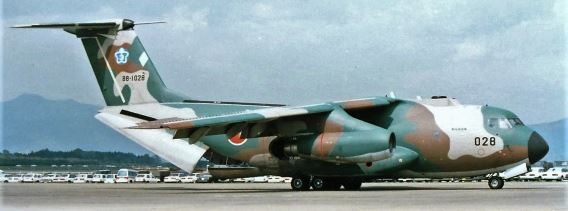 (Photo [JGSDF Takayubaru, Apr. 1990]: Takao Kadokami)
(Photo [JGSDF Takayubaru, Apr. 1990]: Takao Kadokami)
The initial marking was a blue disc containing the white-outlined petals of a cherry blossom (above). These were arranged in a stylized form that vertically spelled out the letters ‘ATW’ (for Air Transport Wing) and enclosed a ‘3’ for the organization in overall command of the 403rd Sqn, which is now usually referred to as the 3rd Tactical Airlift Group,.
Appearing in around 1991, the second version was another blue disc and a design, evoking the 403rd’s Comet radio call-sign, of a broom-riding witch drawing the number ‘3’ (link).
 (Komaki, February 2014)
(Komaki, February 2014)
Changed again for unknown reasons by 1994, the current marking (above, although seen on a now withdrawn YS-11) portrays the white hare and divinity synonymous with an ancient myth in the Inaba region, which now forms the eastern part of Tottori Prefecture, where Miho is located. Their statues feature at the Hakuto Shrine in the city of Tottori.
403rd Tactical Airlift Sqn Special Markings
Miho 50th Anniversary (2008)

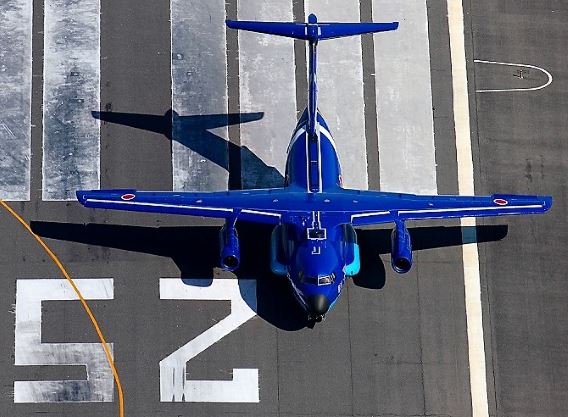 (Above [2] and below) Although one C-1 was given a complete makeover for Miho’s 50th
(Above [2] and below) Although one C-1 was given a complete makeover for Miho’s 50th
anniversary in 2008, as also shown in these snapshots of the painting process (link), line
aircraft just wore the anniversary logo. (Photos: JASDF Miho AB)
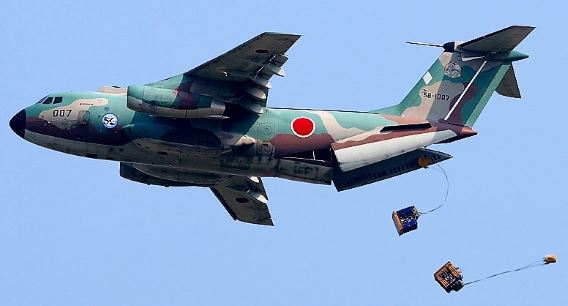
 Bathed by light reflecting off snow, a 403rd Sqn YS-11P returns to the roost. See under the
Bathed by light reflecting off snow, a 403rd Sqn YS-11P returns to the roost. See under the
3rd TAG/TAW for a photo of the YS-11P given a full makeover for the 2008 event, and the
41st Sqn T-400 for details of the marking elements. (Photo: JASDF Miho AB)
|
404th Tactical Airlift |
Formed | Mar. 26, 2009 (1st TAG, Komaki, KC-767) |
| Current Base | Komaki (1st TAG, KC-767) |
 A KC-767 from the 404th Tactical Tanker Airlift Sqn refuels the 201st TFS F-15J that was specially
A KC-767 from the 404th Tactical Tanker Airlift Sqn refuels the 201st TFS F-15J that was specially
painted to commemorate the 60th anniversary of its Chitose base in 2017 (link).
(Photo: JASDF Chitose AB)
 Delivered in 2010, the fourth and final KC-767 to enter service with the 404th Sqn departs
Delivered in 2010, the fourth and final KC-767 to enter service with the 404th Sqn departs
Hamamatsu in October 2014. (Photo: Andy Binks)
404th Tactical Airlift Tanker Sqn Chronology
| 2009 | Mar. 26 | Newly formed at Komaki (link) |
| 2010 | Apr. 1 | Commences KC-767 operations |
| Aug. 22 | (to Aug. 26) Undertakes first overseas mission as part of Haiti PKO efforts |
|
| 2012 | July 17 | (to July 8) Provides first JASDF aircraft to participate for first time in Royal International Air Tattoo (RIAT) in UK |
| 2013 | Feb. 4 | (to Feb. 15) Participates in Exercise Cope North Guam |
| Nov. 12 | (to Dec. 20) Provides airlift support for Japanese contribution to international relief efforts after typhoon strikes the Philippines |
|
| 2014 | July 11 | (to July 13) Second participation in RIAT |
| Dec. 6 | (to Dec. 11) (to Dec. 11) Airlift of materiel as part of international emergency relief operation to combat Ebola epidemic in West Africa |
|
| 2017 | Jan. 30 | (to Mar. 19) Participates in Exercise Cope North Guam |
| May 25 | (to July 1) Participates in Red Flag Alaska | |
| July 10 | 404th KC-767 visits United Arab Emirates Air Force unit | |
| July 14 | (to July 16) Third participation in RIAT | |
| July 17 | Visit made to Royal Canadian Air Force unit | |
| Sept. 3 | Concludes sister squadron accord with No. 33 Squadron, Royal Australian Air Force |
|
| 2018 | Jan. 19 | Visit made to Royal Thai Air Force unit |
 A 404th Sqn KC-767 taxies toward its parking point on the Joint Base Elmendorf-Richardson flight
A 404th Sqn KC-767 taxies toward its parking point on the Joint Base Elmendorf-Richardson flight
line in June 2017. The aircraft was transporting cargo and personnel to Alaska in support of
that year’s Red Flag joint exercise. (Photo: U.S. Air Force/Staff Sgt. Westin Warburton)
 Looked at from both sides now. A shiny 404th Sqn aircraft arrives back at Komaki, February 2014.
Looked at from both sides now. A shiny 404th Sqn aircraft arrives back at Komaki, February 2014.
 One of the 404th’s aircraft returns to Komaki after having airlifted supplies and equipment, which
One of the 404th’s aircraft returns to Komaki after having airlifted supplies and equipment, which
included helmets and bulletproof vests, to Poland in support of the Ukraine war effort.
(Photo [Mar. 13, 2022]: Japan Ministry of Defense)
404th Tactical Airlift Tanker Sqn Tail Marking
 (Komaki, February 2014)
(Komaki, February 2014)
The unit marking is of a bold-faced black horse, which has its origins in the local colour provided from olden times by a horse market, on the back of which the now city of Komaki prospered.
|
405th Air |
Formed | Dec. 15, 2020 (3rd TAG, Miho, [KC-46A]) |
| Current Base | Miho (3rd TAG, [KC-46A}) |
Possessing no aircraft at the time of its formation, the 405th ARS was then expecting that two of its six aircraft would enter service in 2021, starting in June, followed by two more in each of fiscal years 2023 and 2024.
The first did arrive at Miho on October 29, 2021, but due to further delays due to the COVID-19 pandemic, the unit had to wait until February 24, 2022, for the second.
405th Air Refueling Sqn Marking
 (Photo [right side of tail fin]: 黒羽 via Twitter @ shiki_kuroha)
(Photo [right side of tail fin]: 黒羽 via Twitter @ shiki_kuroha)
The inspiration for the official unit badge came from karasutengu, the half-man, half-crow goblin of local folklore said to inhabit Mt. Daisen, a sacred peak in Tottori Prefecture where the squadron is based. Probably intended to keep locals away, the myth dates back to the days when the mountain was off limits to all but monks and others living simple religious lives.
The December 22, 2020, edition of the Miho AB newspaper, also called Daisen, carried a small version (link) on its front page, and the March 2021 issue of Kōkū Fan included a black-and-white illustration; the design was then already appearing on squadron patch sites. It was not until the second KC-46A’s arrival that the low-vis version of the marking (above) was seen on an aircraft. The 405th has thus joined Naha-based 304th TFS in having a form of tengu as a tail marking.
 A giant statue of a crow tengu stands in Niodo Park in the town of Daisen, as also featured on
A giant statue of a crow tengu stands in Niodo Park in the town of Daisen, as also featured on
this Tottori tourism website (link). (Photo: 黒羽 via Twitter @ shiki_kuroha)
 (Photo [May 2022]: 黒羽 via Twitter @ shiki_kuroha)
(Photo [May 2022]: 黒羽 via Twitter @ shiki_kuroha)
|
601st Sqn |
Formed |
As Provisional AW&C Sqn: Nov. 15, 1983 As 601st AW&C Sqn: Apr. 5, 1986 (E-2C, Misawa) |
| Current Base | Misawa (Airborne Warning & Control Wing, E-2C/D) |
On September 6, 1976, at the height of the Cold War, a defecting Soviet Air Force MiG-25 pilot exposed the weaknesses in Japan’s air defences by landing unchallenged at Hakodate airport, Hokkaido Prefecture. As a result, the JASDF beefed up its ground-based radar network and made the acquisition of an airborne early warning (AEW) capability a priority. In 1981, pilots and ground crews began to be sent the United States to receive training from Grumman.
A preparatory unit having formed at Misawa December 21, 1982, what was to become the 601st had to wait to February 9 the following year to receive its first two E-2C Hawkeye aircraft, which were delivered by sea to Kisarazu, Chiba Prefecture. A total of four aircraft had been received by November 1983, when the preparatory unit was reformed as the Provisional Airborne Warning & Control (AW&C) Group, at that time reporting to the Northern Regional Air Command. Six of the eight aircraft delivered were on strength when the 601st AW&C Sqn officially came into being, on April 5, 1986, under the command of the AW&C Group.
 (Photo [Nyutabaru, March 1993]: Takao Kadokami)
(Photo [Nyutabaru, March 1993]: Takao Kadokami)
Assuming responsibility for patrols from March 31, 1987, the unit played an important role and quickly clocked up the flying hours, surpassing 10,000 hours that same year.
The arrival of the first E-767s prompted the formation of two flights within the 601st on March 25, 1999; the 1st Flt remained at Misawa on the E-2C, while the E-767’s 2nd Flt formed at Hamamatsu, to where the HQs of the AW&C Group and 601st Sqn were relocated.
The next change took place on March 31, 2005, when the numerical squadron designation fell into abeyance, and the E-2C unit became the Airborne Warning and Surveillance Squadron (and the E-767 flight became the Airborne Warning & Control Squadron).
After nine years, the 601st designation was resurrected when the 603rd Sqn formed on the E-2C at Naha on April 20, 2014, the E-767 element becoming the 602nd Sqn (q.v.), still under AW&C Group command. As shown in the chronology below, the 601st has been solely an E-2 unit since that time.
On March 26, 2020, overall command passed to the upgraded Airborne Warning & Control Wing (AW&CW) at Hamamatsu, to which the 602nd Sqn reports directly, and the chain of command from the two E-2 units to the AW&CW was changed to via the AEW Group at Misawa.
601st Sqn Chronology
| 1982 | Dec. 21 | Unit responsible for preparing for airborne early warning (AEW) operations under Northern Air Command and subordinate unit to prepare for AEW squadron formed at Misawa |
| 1983 | Feb. 8 | First two E-2Cs arrive |
| July 15 | Third and fourth E-2Cs arrive | |
| Nov. 10 | Receives then Japan Defense Agency approval for squadron utilization of E-2C |
|
| Nov. 15 | Above preparatory units form Provisional Airborne Warning & Control (AW&C) Sqn and Provisional 601st AW&C Sqn |
|
| 1986 | Apr. 5 | AW&C Sqn loses provisional title, formation of 601st Sqn with six aircraft completed |
| 1987 | Jan. 31 | Start of alert standby and patrol flight missions on E-2Cs |
| 1993 | Nov. 11 | Including its time as a provisional squadron in total, 601st holds event to celebrate 10th anniversary year, for which aircraft receives special markings (link) |
| 1994 | Apr. 28 | Last of 13 E-2Cs received |
| 1998 | Mar. 25 | First two E-767s arrive, AEW aircraft test unit forms at Hamamatsu under Air Development & Test Wing command |
| 1999 | Feb. 8 | Second pair of E-767s arrive at Hamamatsu |
| Mar. 24 | Receives then Japan Defense Agency approval for squadron utilization of E-767 |
|
| Mar. 25 | AW&C Group and 601st Sqn HQ relocate from Misawa to to Hamamatsu. 601st’s 1st Flight (E-2C) remains at Misawa, Hamamatsu becomes base for 2nd Flight (E-767) operations |
|
| May 10 | E-767 operations commence | |
| June 21 | (to June 25) Participates in Cope North Guam |
 10th anniversary, 1993 (Photo: Japan Ministry of Defense/JASDF)
10th anniversary, 1993 (Photo: Japan Ministry of Defense/JASDF)
| 2000 | April | E-767 missions to counter incursions of Japanese airspace commenced |
| May 30 | (to June 3) Cope North Guam | |
| 2002 | Apr. 15 | (to Apr. 26) Cope North Guam (E-767) |
| 2003 | June 5 | (to June 29) Participates in Cope Thunder multinational exercise (E-767) |
| Nov. 8 | Ceremony held to mark 20th anniversary of AW&C Group, for which aircraft again painted with special markings (link) |
|
| Nov. 10 | (to Nov. 21) Cope North Guam (E-767) | |
| 2004 | July 15 | (to July 30) Participates in U.S.-Japan Cope Thunder joint exercise (E-767) |
| Sept. 22 | Receives first E-2C refurbished to Hawkeye 2000 standard | |
| 2005 | Mar. 31 | Reorganization results in 1st Flight (E-2C) being redesignated as Airborne Warning & Surveillance Sqn, 2nd Flt (E-767) as AW&C Sqn |
| 2006 | June 1 | (to June 10) Participates in Cope North Guam |
| 2007 | June 10 | (to June 23) Cope North Guam |
| 2009 | Feb. 1 | (to Feb. 14) Cope North Guam |
| July 30 | Surpasses 100,000 accident-free flying hours, paints aircraft to mark occasion (link [Misawa] and photo below) |
 The scene at Hamamatsu on the occasion of the 20th anniversary of the AW&C Group in
The scene at Hamamatsu on the occasion of the 20th anniversary of the AW&C Group in
November 2003. (Photo: Japan Ministry of Defense/JASDF)
| 2013 | Feb. 4 | (to Feb. 15) Participation in Cope North Guam |
| Nov. 30 | Ceremony held to mark 30th anniversary of AW&C Group, aircraft again painted with special marking (link) |
|
| 2014 | Apr. 20 | Following another AW&C Group reorganization, Airborne Warning & Surveillance Sqn disbands, (E-2C) 601st Sqn reforms under Airborne Warning & Surveillance Group at Misawa, alongside newly formed 603rd Sqn (q.v.) at Naha; AW&C Sqn E-767 operations reformed under 602nd Sqn (see below) |
| 2015 | Jan. 27 | (to Mar. 12) Cope North Guam |
| 2016 | Feb. 10 | (to Feb. 26) Cope North Guam |
| 2017 | Feb. 15 | (to Mar. 3) Cope North Guam |
| 2019 | Mar. 27 | First E-2D arrives at Misawa |
| 2020 | Mar. 26 | Command passes from AW&C Group upgraded to AW&C Wing |
 30th anniversary, 2013. Note that the smaller aircraft had a much larger version of the
30th anniversary, 2013. Note that the smaller aircraft had a much larger version of the
fuselage badge carried to mark the occasion; see Special Markings section below.
(Photo: Japan Ministry of Defense/JASDF)
Following the arrival of the first E-2Ds in 2019, the unit was once again involved in a major reorganization on March 26, 2020. On that day, the commanding Airborne Warning and Control Group was disbanded and reorganized as the Airborne Warning and Control Wing (AW&CW), its elevation in the peerage being reflected in the commander’s rank being upgraded from colonel to major general. Whereas the E-767 unit (see 602nd Sqn) has from that day reported directly to the AW&CW at its Hamamatsu base, the E-2 units report via the Misawa-headquartered Airborne Warning and Control Group, which was formed that day.
 Including 34-3459, which now sports eight-bladed props, two E-2Cs were present at Hamamatsu
Including 34-3459, which now sports eight-bladed props, two E-2Cs were present at Hamamatsu
on the occasion of a visit by then Minister of Defense Tarō Kōno to the newly reorganised
Airborne Warning & Control Wing on March 29, 2020.
(Photo: Japan Ministry of Defense via Twitter @ModJapan_jp)
 40th anniversary (Photo: JASDF/Misawa AB)
40th anniversary (Photo: JASDF/Misawa AB)
Timeline of AEW Unit Designations
Airborne Warning & Control Preparatory Squadron (警戒航空準備隊)
(Non-flying, Misawa) Dec. 21, 1982 to Nov. 15, 1983
Provisional Airborne Warning & Control Group (臨時警戒航空隊)
Nov. 15, 1983 to Apr. 5, 1986
Airborne Warning & Control Group (警戒航空隊)
(Overall command) Apr. 5, 1986 to Mar. 26, 2020
601st Sqn Apr. 5, 1986 to Mar. 30, 2005
(→ 1st Flt [E-2C, Misawa]/2nd Flt [E-767, Hamamatsu] from Mar. 25, 1999)
and since Apr. 20, 2014 (E-2/Misawa)
Airborne Warning and Surveillance Squadron (飛行警戒監視隊)
Formerly 601st Sqn, 1st Flt (E-2C), Mar. 31, 2005 to Apr. 20, 2014
Airborne Warning & Control Squadron (飛行警戒管制隊)
Formerly 601st Sqn, 2nd Flt (E-767), Mar. 31, 2005 to Apr. 20, 2014
602nd Sqn (E-767) Since Apr. 20, 2014
603rd Sqn (E-2C, Naha) Since Apr. 20, 2014
Airborne Warning & Control Wing (警戒航空団) Since Mar. 26, 2020
AEW Group (飛行警戒管制群) Since Mar. 26, 2020
601st Squadron* Markings
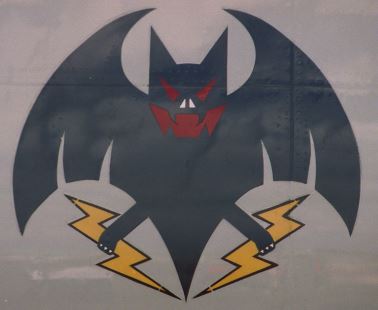 (Ashiya, September 2000)
(Ashiya, September 2000)
All 601st Sqn aircraft sport the unit’s marking of a bat clutching lightning flashes on their fuselage sides (E-2C) and, previously, tails (E-767). The design was formally decided upon on March 24, 1986.
601st Sqn/Airborne Early Warning Group Special Markings
1993, 10th Anniversary of Unit Formation E-2C 54-3457 (link)
 A close-up of the badge applied to one aircraft to mark the 601st’s 10th anniversary in 1993.
A close-up of the badge applied to one aircraft to mark the 601st’s 10th anniversary in 1993.
(Photo [Ashiya, Nov. 1993]: Takao Kadokami)
1994 JASDF 40th Anniversary E-2Cs 54-3458, 54-3459 (link) (link)
 The year 1994, in which the 601st received its last E-2C, coincided with the
The year 1994, in which the 601st received its last E-2C, coincided with the
JASDF’s 40th anniversary, an event that did not pass unnoticed.
(Photo [Misawa, Oct. 1994]: Rob Schleiffert via Wikimedia Commons)
September 2003 “Pre 50th Anniversary” E-2C 54-3457 (link) (link)
November 2003, 20th Anniversary of Unit Formation E-2C 54-3459 (link) and E-767 64-3501 (see below)
2004 JASDF 50th Anniversary E-2C 34-3460
 Members of the 601st’s maintenance team were again allowed to show their artistic side for the
Members of the 601st’s maintenance team were again allowed to show their artistic side for the
JASDF’s 50th anniversary in 2004 (link). (Photo [Nyutabaru, Dec. 2004]: Takao Kadokami)
(* From March 2005 to April 2014, the 601st Sqn designation was dropped in favour of Airborne Warning and Surveillance Squadron.)
2009 AEW E-2C 100,000 hours of safe flight 30,July,2009 (sic) E-2Cs 34-3455 and 34-3459
 (Photo: Japan Ministry of Defense/JASDF)
(Photo: Japan Ministry of Defense/JASDF)
 One of the then Airborne Warning & Surveillance Squadron’s E-2C Hawkeyes specially painted
One of the then Airborne Warning & Surveillance Squadron’s E-2C Hawkeyes specially painted
to commemorate the milestone of 100,000 accident-free flight hours attained on July 30, 2009.
Seen here and in flight (link) at Iruma in November of that year, this aircraft was one of four
assigned to the JASDF’s then newest unit, the 603rd Sqn, in 2014.
2013 30th Anniversary of Unit Formation E-2C 44-3462 / E-767 74-3503 (link)
 (Image: Japan Ministry of Defense/JASDF)
(Image: Japan Ministry of Defense/JASDF)
2014 JASDF 60th Anniversary E-2C e.g. 54-3457 (link)
 Like many squadrons, the 601st marked the JASDF’s 60th anniversary in 2014 with a
Like many squadrons, the 601st marked the JASDF’s 60th anniversary in 2014 with a
subdued, budget-saving fuselage sticker, albeit one larger than most.
(Photo [Hamamatsu, Oct. 2014]: Andy Binks)
2023 40th Anniversary of Unit Formation E-2D 01-3473
 (Photo: sachiy via X [formerly Twitter] @ssachiygmailco1)
(Photo: sachiy via X [formerly Twitter] @ssachiygmailco1)
Present at the 2023 Misawa air show was the third of the JASDF’s E-2Ds, which carried the slogan 40th anniversary E-2C/D Since 1983.11.15 on its rear fuselage. The latter is a reference to the date when the Airborne Warning & Control (AW&C) Group and the 601st AW&C Sqn were provisionally formed. In addition to the slightly incongruous use of a shark’s mouth on an unarmed aircraft, the aircraft carried a badge, incorporating the 601st’s bat and the 602nd’s owl (below), aft of the unit marking on both sides of the forward fuselage. (See Bulletin Board story, September 2023)
 (Photo: ヨルハ via X [formerly Twitter] @YoRHa1530)
(Photo: ヨルハ via X [formerly Twitter] @YoRHa1530)
E-767 Special Markings (Pre-602nd Sqn Era)
November 2003 Hamamatsu Air Show AEW Group 20th anniversary 64-3501
To mark the 20th anniversary of the AEW unit command, the first E-767 sported the heraldic-style command unit badge (link) on its forward fuselage depicting an eagle’s head above the words AEW Group in white on a blue scroll. Below the badge was a small Japanese flag to the left of JASDF and above E-767 AWACS, all in black. Possibly applied only to the aircraft’s starboard engine for the purposes of the air show were a very wide blue diagonal stripe (link), again with AEW Group in white, above a thin stripe, and a rakishly angled bold 20th in red above Anniversary in black cursive script.
2004 JASDF 50th Anniversary
 (Photo: Japan Ministry of Defense/JASDF)
(Photo: Japan Ministry of Defense/JASDF)
At that time still assigned the 601st’s 2nd Flight, specially marked aircraft ’503 and ’504 (and an unidentified other) were huddled together when paraded for the commemorative photo shoot (above). Said to evoke a refreshing breeze, the (particularly on an E-767) eye-catching blue stripe design was created by a technical sergeant assigned to the unit’s HQ and took an eight-man paint team around two months to complete. The fruits of their labours can be better appreciated in photos taken at Hamamatsu in July (link), the month when one of the aircraft took part in Exercise Cope North in Alaska, and November 2004 (link).
2009 10th Anniversary of JASDF E-767 Service Entry
 (Photo: Japan Ministry of Defense/JASDF)
(Photo: Japan Ministry of Defense/JASDF)
For this photo shoot, 64-3501 and 84-3504 carried badges featuring an owl design above the titling AWCG E-767 AWACS on their forward fuselages (link). The design incorporated the words EYES OF JAPAN in red. The badge was also applied, with all-black titling, to the “AWACS Junior” novelty display that is trundled about for children’s entertainment on air show days (link).
November 2013 30th Anniversary of Unit Formation E-767 34-7503 (see chronology table and E-2C special markings above)
|
602nd Sqn |
Formed | As Airborne Warning & Control Squadron: Mar. 31, 2005 (Hamamatsu, E-767) As 602nd Sqn: Apr. 20, 2014 (Hamamatsu, E-767) |
| Current Base | Hamamatsu (reporting direct to Airborne Warning & Control Wing, E-767) |
 Wearing a JASDF 60th anniversary badge on its engine cowling, a 602nd Sqn E-767 makes smoke
Wearing a JASDF 60th anniversary badge on its engine cowling, a 602nd Sqn E-767 makes smoke
on landing at Hamamatsu in October 2014. (Photo: Andy Binks)
The first aircraft’s maiden flight, as a standard 767, took place in the United States on October 10, 1994, and it was to be August 9, 1996, when the aircraft took to the skies fitted with its rotodome. The first pair of aircraft arrived at Hamamatsu on March 25, 1998, from where they underwent a period of additional testing by a team from the Air Development & Test Wing at Gifu. The remaining pair arrived on February 8, 1999, the type being cleared for operational use on March 24 that year.
The following day, March 25, 1999, a reorganization resulted in AW&C Group and 601st Sqn HQ relocating from Misawa to Hamamatsu. The 601st’s now 1st Flight (E-2C) remained at Misawa, while Hamamatsu began its long association with the E-767s of what was then the 601st’s 2nd Flight. (For subsequent organizational developments, see the timeline in the 601st Sqn section.)
602nd Sqn Events from 2005
| 2005 | Mar. 31 | Reformed as Airborne Warning & Control Squadron from 601st Sqn, 2nd Flt |
| May 25 | (to July 1) Participates in U.S.-Japan Cope Thunder joint exercise |
|
| 2006 | July 21 | (to Aug. 5) Participates in Cope Thunder multinational exercise |
| 2011 | June 27 | (to July 29) Participates in U.S. Air Force Red Flag Alaska |
| 2013 | Aug. 9 | (to Aug. 24) Takes part again in Red Flag Alaska |
| 2014 | Apr. 20 | Airborne Warning & Control Squadron reforms as 602nd Sqn |
| 2015 | Aug. 4 | (to Aug. 22) Red Flag Alaska exercise |
| 2018 | May 28 | (to June 30) Red Flag Alaska exercise |
| 2019 | May 27 | (to June 29) Red Flag Alaska exercise |
On March 26, 2020, the commanding, Hamamatsu-based Airborne Warning and Control Squadron was disbanded and reorganized as the Airborne Warning and Control Wing (AW&CW), its elevation in the peerage being reflected in the commander’s rank being upgraded from colonel to major general. Whereas the E-2 units report to the AW&CW via the intermediate Airborne Warning and Control Group, which is headquartered at Misawa, the co-based 602nd reports directly.
 (Photo: JASDF)
(Photo: JASDF)
The press release that accompanied the 40th anniversary photo (see Special Markings below), which had been taken on May 18, 2023, stated that the three-squadron Airborne Warning and Control Wing had achieved 200,000 accident-free flying hours as at May 24, 2023.
602nd Sqn Tail Marking
 (Hamamatsu, Sept. 2014)
(Hamamatsu, Sept. 2014)
Having worn the bat clutching lightning flashes marking of the 601st Sqn during its time as that unit’s 2nd Flight, the 602nd retains the design—comprising a caricature of a Blakiston’s eagle owl clutching lightning flashes—adopted following formation in its own right as the then Airborne Warning & Control Squadron in 2005.
The various English versions of the changing designations given to the AEW elements can cause some confusion (see timeline in 601st Sqn section). A uniform patch bearing the owl insignia carried the abbreviation AACS, which was presumably from a direct translation of 飛行警戒管制隊 (Airborne Alert & Control Squadron).
602nd Sqn Special Markings
May 2023 AW&CW 40th Anniversary
 (Photo: Japan Ministry of Defense/JASDF)
(Photo: Japan Ministry of Defense/JASDF)
 The badge for the occasion was not applied in time for the commemorative
The badge for the occasion was not applied in time for the commemorative
photo in May 2023. (See large image at end of 601st Sqn entry.)
(Photo [posted Sept. 23, 2023]: Area Kilo via X [formerly Twitter] @area_kilo)
 (Above and below) Note that E-767 64-3501 carries its 40th anniversary marking in a different
(Above and below) Note that E-767 64-3501 carries its 40th anniversary marking in a different
position aft of the forward fuselage door, November 2023.
 (Photos: 浜 松吉 via X [formerly Twitter] @anticoACL)
(Photos: 浜 松吉 via X [formerly Twitter] @anticoACL)
 On the occasion of a ceremony to mark 40 years since the founding of the JASDF’s first airborne
On the occasion of a ceremony to mark 40 years since the founding of the JASDF’s first airborne
early warning and control unit, which was held at Hamamatsu AB on December 2, 2023,
a 602nd Sqn E-767 was temporarily decorated with a shark mouth sticker, mimicking
that worn since around September by one of its sister 601st Sqn’s E-2D Hawkeyes.
The slogan at the foot of the official photo reads: “Inheriting 40 years of glorious
history and tradition to be used as fuel for future development”.
(Photo: JASDF/Hamamatsu AB)
|
603rd Sqn |
Formed | Apr. 20, 2014 (Airborne Warning & Control Group, Naha, E-2C) |
| Current Base | Naha (Airborne Warning & Control Group, E-2C [link]) |
 (Photo: Japan Ministry of Defense/JASDF)
(Photo: Japan Ministry of Defense/JASDF)
From 2010, an increase in particularly Chinese military activity resulted in a higher incidence of fighter scrambles from Naha to ward off possible incursions into Japanese airspace. As the activity showed no sign of abating, the Misawa-based Airborne Warning & Control Sqn (601st Sqn) commenced the stationing of a single E-2C in Okinawa on training rotations from around 2012.
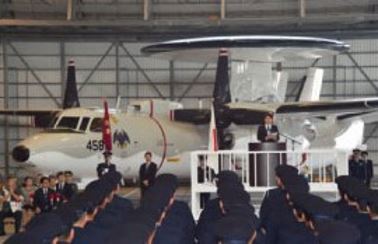 Then Defense Minister Itsunori Onodera addresses the assembled personnel in the 603rd’s hangar
Then Defense Minister Itsunori Onodera addresses the assembled personnel in the 603rd’s hangar
at Naha on the day the unit was formed, April 20, 2014. (Photo: Japan Ministry of Defense)
 Then Defense Minister Onodera is seated centrally on the front row of the outdoor
Then Defense Minister Onodera is seated centrally on the front row of the outdoor
commemorative photo on the 603rd’s first day. (Photo: Japan Ministry of Defense)
Part of a National Defense Program Guideline, a Cabinet decision on December 17, 2013, cleared the way for a new AEW squadron to be permanently based at Naha. Thus the 603rd came into existence in April the following year.
As mentioned above, on March 26, 2020, the Airborne Warning and Control Squadron was disbanded and reorganized as the Airborne Warning and Control Wing (AW&CW), its elevation in the peerage being reflected in the commander’s rank being upgraded from colonel to major general. Whereas the E-767 unit (see 602nd Sqn) reports directly to the AW&CW at its Hamamatsu base, the E-2 units report via the intermediate Airborne Warning and Control Group, which is headquartered at Misawa.
603rd Sqn Marking
603rd Sqn aircraft retain the 601st Sqn’s bat fuselage marking.
 The JASDF is continually upgrading the capabilities of its E-2C fleet.
The JASDF is continually upgrading the capabilities of its E-2C fleet.
|
701st Sqn |
Formed | As Provisional Special Airlift Group: April 1, 1992 (Chitose, 747-400) As 701st Sqn: June 1, 1993 (Special Airlift Group, Chitose, 747-400) |
| Current Base | Chitose (B777-300) |
 One of the two former JASDF B-747s over Lake Shikotsu in southwest Hokkaido.
One of the two former JASDF B-747s over Lake Shikotsu in southwest Hokkaido.
(Photo: Special Airlift Group, JASDF Chitose AB)
According to the November 2000 issue of Kōkū Fan magazine, the Japanese government was looking into the country playing a greater role on the world stage in 1987. It was this that provided the trigger for the acquisition of two Boeing 747-400s, which were to become known simply as B-747 in JASDF service, ‘to contribute to the development of internationalization’.
Suitably equipped for VIP operations, the aircraft were handed over in September and November 1991 and came under the control of the then Japan Defense Agency (JDA, now Japan Ministry of Defense) the following April. It was to be more than a year before the provisional unit, formed on April 4, 1992, was deemed ready to officially receive full squadron status under the Special Airlift Group.
In line with the transfer of the aircraft to the JASDF, the unit’s mission was expanded from the transport of VIPs, such as the prime minister and his entourage and members of the imperial family. On occasion, the unit is involved in international relief activities, the evacuation and repatriation of Japanese and other nationals caught in conflict zones, and special cases that have received prime ministerial approval.
In late December 2018, the Jiji Press news agency reported that Prime Minister Shinzō Abe had used the aircraft to visit 78 countries in seven years (since December 2012, including his first period in office from September 2006 to September 2007), extending the total to 176 countries and regions. Although primarily undertaken for members of the imperial family, the 15 domestic flights also include the Kyushu-Okinawa Summit (the 26th G8 Summit) in July 2000 and the Hokkaido-Toyako Summit (the 34th) in July 2008.
Although the aircraft carry no squadron markings, the aircraft bore the JASDF 60th anniversary logo on their winglets in 2014. They have also on occasion had the logos of political meetings added to the right of the main (left forward) passenger door. Examples include the logos chosen for the Central Asia plus Japan Dialogue and the Group of Seven (G7) Ise-Shima Summit of March and May 2016, respectively. Featuring seven cherry blossom petals around a hinomaru against a blue shape symbolizing the sea around Ise-Shima, the latter logo was designed by a student at the Oita Prefectural Tsurusaki Technical High School. (The eagle crest seen on the inside of the main passenger door when opened is that of the JASDF.)
Offering some insight into its operations and the aircraft interiors, the Special Airlift Group produced an English-language video that can be viewed on YouTube (link).
701st Sqn Chronology
| 1992 | Apr. 1 | Formed as Provisional Special Airlift Group at Chitose |
| Sept. 25 | First overseas test flight conducted | |
| 1993 | Feb. 11 | Flies first official mission (visit of then Deputy Prime Minister Michio Watanabe to United States) |
| June 1 | 701st Sqn officially comes into existence under Special Airlift Group |
 Now a sight from the past, a 701st Sqn B-747 takes off from Tokyo International Airport
Now a sight from the past, a 701st Sqn B-747 takes off from Tokyo International Airport
back in November 2008. (Photo: ‘Rs1421’ via Wikimedia Commons)
| 2000 | Aug. 31 | Cumulative total of 112 overseas missions to 64 countries* |
| 2003 | Mar. 30 | (to Apr. 2) Mounts refugee relief operation, airlifting tents and other materiel to Iraq as first international peace cooperation mission |
| 2004 | Jan. 22 | For first time, transports around 100 SDF personnel from Komaki to Kuwait to assist in Iraq’s reconstruction |
| May | Families of Japanese nationals abducted by North Korea flown back to Japan |
|
| 2005 | Oct. 14 | For its first international emergency relief operation, airlifts personnel from Japan to assist in the aftermath of earthquake that struck Pakistan |
| 2006 | Aug. 18 | Cumulative total of overseas airports visited reaches 200 |
| 2008 | Nov. 17 | 200th mission completed |
| * The Base Topics page on the JASDF website in June 2002 announced that the 100th flight milestone had been reached on May 3, 2002. Comprising 94 overseas (72 countries) and six domestic flights, 166 airports had been visited, and (implausibly) a distance of 1,917,000 kms covered in a total flight time of around 2,300 hours. |
||
 701st Sqn personnel form‘200’ during a photo call marking the 200th mission milestone,
701st Sqn personnel form‘200’ during a photo call marking the 200th mission milestone,
reached in November 2008. (Photo: Japan Ministry of Defense)
| 2013 | Jan. 21 | (to Jan 24) Operates first mission involving evacuation and repatriation of Japanese nationals from overseas (Algeria) |
| 2014 | Aug. 12 | Decision made to award ANA Holdings maintenance contract for replacement 777-300 aircraft |
| 2015 | Oct. 6 | 300th mission completed |
| 2017 | May 15 | In-flight personnel 777-300 conversion training commences at ANA facility |
| 2018 | Aug. 17 | First 777-300 arrives (see Bullletin Board story) |
| Oct. 20 | Prime Minister Shinzō Abe inspects B-777 for first time at Tokyo-Haneda upon return from visit to Europe (link) |
|
| Nov. 3 | (to Nov. 5) First B-777 overseas training operation, transporting 35 personnel from Haneda to Sydney, Australia |
 Neither B-747 carried any squadron markings. (Photo: Special Airlift Group, JASDF Chitose AB)
Neither B-747 carried any squadron markings. (Photo: Special Airlift Group, JASDF Chitose AB)
The April 2019 issue of Kōkū Fan reported that 33 squadron members under the command of Colonel Takeshi Nakano had taken part in B.777 crew training in January 2019. The flight destinations included: Singapore’s Changi airport; King Shaka Airport in Durban, South Africa; Al Dhafra Air Base in Abu Dhabi; and Stockholm Arlanda Airport in Sweden.
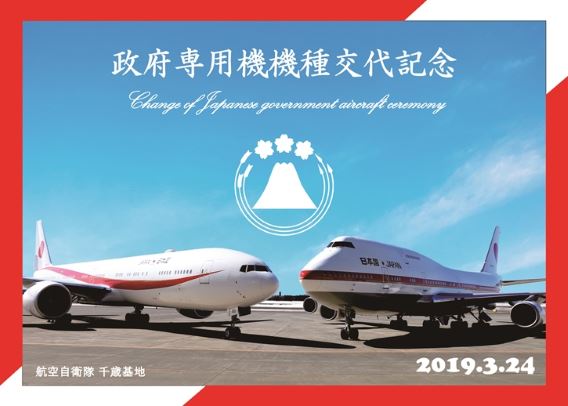 (From Special Airlift Group, JASDF Chitose AB website)
(From Special Airlift Group, JASDF Chitose AB website)
The official changeover (above) was marked by a ceremony held amid snow flurries at Chitose on March 24, 2019. The final stats for the B747s were: 100 countries visited, 271 airports of call, and a total distance covered of 14.6 million kilometres (equivalent to 365 times around the Earth) in the course of 349 mission operations.
The first operational flight, conducted from April 22 to April 29, took Prime Minister Abe’s retinue on a whistle-stop tour from Haneda to Paris, Rome, Vienna, Brussels and Washington DC.
 The first of the pair of Boeing 777-300ERs arrived on August 17, 2018, and conducted its first
The first of the pair of Boeing 777-300ERs arrived on August 17, 2018, and conducted its first
overseas training flight in early November. (Photo: JASDF Public Affairs Office)
 Chitose AB on June 27, 2019. Squadron personnel form ranks to bid farewell to one of the
Chitose AB on June 27, 2019. Squadron personnel form ranks to bid farewell to one of the
B.747-400s on the day of its departure to new ownership in the United States.
(Photo: JASDF Public Affairs Office via Twitter @JASDF_PAO)
 On November 19, 2020, members of the Special Airlift Group had their photo taken to
On November 19, 2020, members of the Special Airlift Group had their photo taken to
commemorate their having successfully completed out 10 B.777 missions. At that time, the
cumulative total of missions stood at 359. (Photo: JASDF Chitose AB via Twitter @jasdf_chitose)
 (Photo: JASDF Chitose AB via Twitter @jasdf_chitose)
(Photo: JASDF Chitose AB via Twitter @jasdf_chitose)
 (Photo: Takao Kadokami)
(Photo: Takao Kadokami)
Please note that the current total of four pages devoted to JASDF
squadron histories are constantly being updated and improved.
(All photographs on this website are copyright J-HangarSpace
unless otherwise stated.)
|
50th Anniversary of Blue Impulse, Bunrindo, 2010 Burū Inparusu Monogatari (Blue Impulse Tales), series published in The Collected Special Color Scheme [sic] of JASDF Aircraft (Ikaros, 2005) Blue Impulse Perfect Guidebook, Ikaros, 2015 Fuji T-1, Famous Airplanes of the World No. 114 (Bunrindo, 2006) JSDF Squadron, series published in Kōkū Fan magazine, Bunrindo (various issues 1997–2001) Japan Self-Defense Force Squadron, Ikaros, Summer 1996 JASDF F-15 All-Unit Guide, JWings, October 2014 issue Kōkū Jieitai F-86/F-104, Military Aircraft of JASDF Vol. 6, Ikaros, 2005 Kōkū Jieitai T-4/C-1/E-767, Military Aircraft of JASDF Vol. 5, Ikaros, 2005 Mitsubishi T-2/F-1 Shashinshū (Photo Collection), Hobby Japan, 2017 North American F-86 Sabre, Famous Airplanes of the World Nos. 20 and 93, Bunrindo, 1995/2002 Watanabe, Akira, Japanese Air Arms, 1952–1984, (self-published in English), 1984
|


